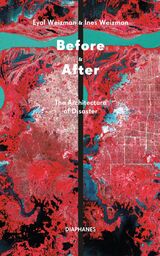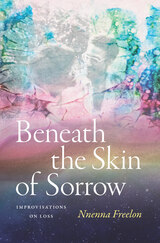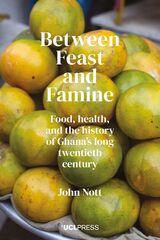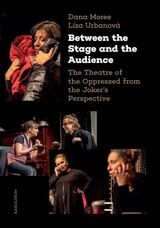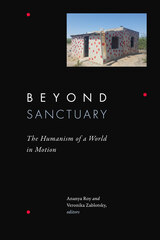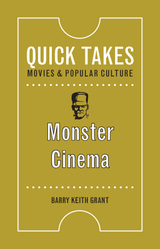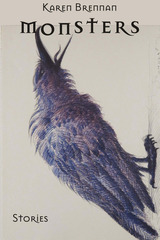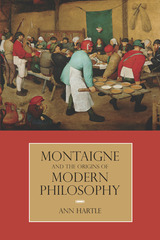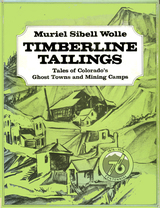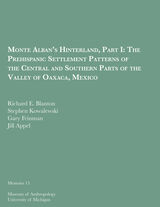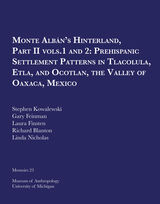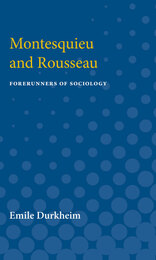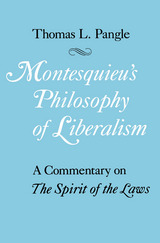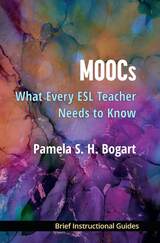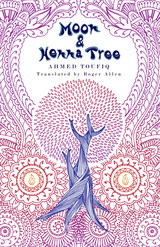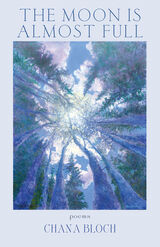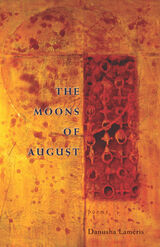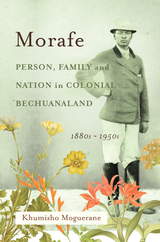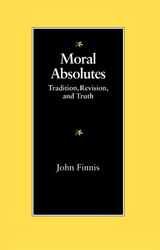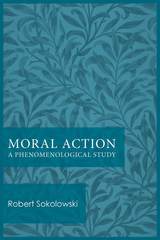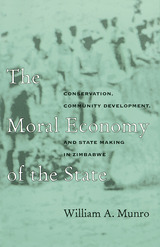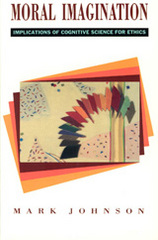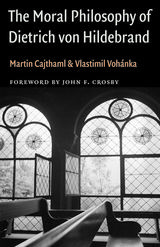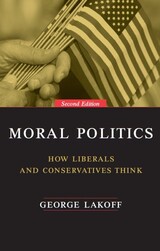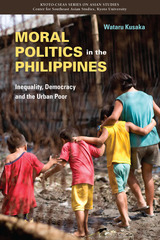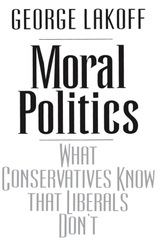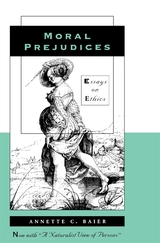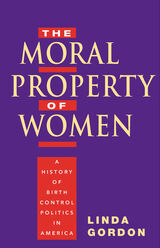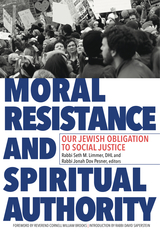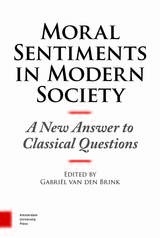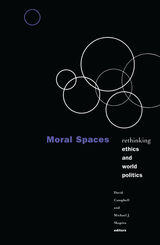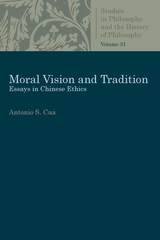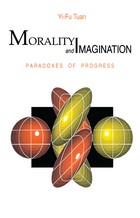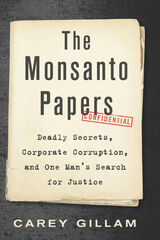 The Monsanto Papers: Deadly Secrets, Corporate Corruption, and One Man’s Search for Justice
Carey Gillam
Island Press, 2021 Lee Johnson was a man with simple dreams. All he wanted was a steady job and a nice home for his wife and children, something better than the hard life he knew growing up. He never imagined that he would become the face of a David-and-Goliath showdown against one of the world’s most powerful corporate giants. But a workplace accident left Lee doused in a toxic chemical and facing a deadly cancer that turned his life upside down. In 2018, the world watched as Lee was thrust to the forefront of one the most dramatic legal battles in recent history.
The Monsanto Papers is the inside story of Lee Johnson’s landmark lawsuit against Monsanto. For Lee, the case was a race against the clock, with doctors predicting he wouldn’t survive long enough to take the witness stand. For the eclectic band of young, ambitious lawyers representing him, it was a matter of professional pride and personal risk, with millions of dollars and hard-earned reputations on the line. For the public at large, the lawsuit presented a question of corporate accountability. With enough money and influence, could a company endanger its customers, hide evidence, manipulate regulators, and get away with it all—for decades?
Readers will be astounded by the depth of corruption uncovered, captivated by the shocking twists, and moved by Lee’s quiet determination to see justice served. With gripping narrative force that reads like fiction, The Monsanto Papers takes readers behind the scenes of a grueling legal battle, pulling back the curtain on the frailties of the American court system and the lengths to which lawyers will go to fight corporate wrongdoing.
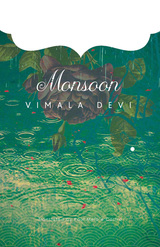 Monsoon
Vimala Devi
Seagull Books, 2019 An actor of traditional Hindu dramas meets an adolescent girl who turns out to be his half-sister. A man returns to Goa from Mozambique to father a child for a family whose unmarried daughters has produced no heirs. Another man feels out of place in his family home after returning from Portugal to get a university education, as a woman waits faithfully for him to return. A forbidden romance blooms between a Christian girl and a Hindu boy.
Through these stories, written with a mix of poignant nostalgia and sharp criticism, Vimala Devi recreates the colonial Goa of her childhood. First published in 1963, two years after the Portuguese colony became part of India, Monsoon is a cycle of twelve stories that vary in tone. By turns satirical, desolate, tender, humorous, and dramatic, they come together through a subtle interplay of echoes, parallels and cross-references to form a composite picture of a world gone by. They delve into divisions of caste, religion, language, and material privilege, setting them off against a common historical experience and deeply felt attachment to the land.
Including a critical and contextualizing introduction by Jason Keith Fernandes, this rendition of Monsoon allows contemporary readers a rare peep into a colonial society that was significantly different from the British Indian mainstream.
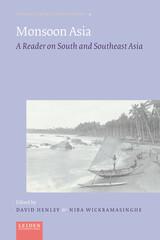 Monsoon Asia: A reader on South and Southeast Asia
David Henley
Leiden University Press, 2023 Monsoon Asia was the first venue of global trade, a zone of encounters, exchanges, and cultural diffusion. This book demonstrates the continuing fertility of the Monsoon Asia perspective as an aid to understanding what South/Southeast Asia, as a connected space, has been in the past and is today. Sixteen tightly knit chapters, written by experts from perspectives ranging from Indology and philology to postcolonial and transnational studies, offer a captivating view of the region, with its rich and variegated history shaped by commonalities in human ecology, cultural forms, and religious practices. The contributions draw upon extensive research and a thorough command of the most recent scholarship. This volume will be an invaluable text for anyone interested in South and Southeast Asia, and for more specialized students in the fields of global and Indian Ocean history, transcultural studies, archaeology, linguistics, and politics.
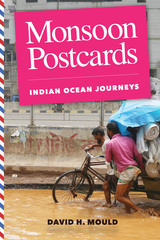 Monsoon Postcards: Indian Ocean Journeys
David H. Mould
Ohio University Press, 2019 In Monsoon Postcards, journalist David H. Mould, notebook in hand, traverses the Indian Ocean—from Madagascar through India and Bangladesh to Indonesia. It’s an unpredictable journey on battered buses, bush taxis, auto-rickshaws, and crowded ferries. Mould travels from the traffic snarls of Delhi, Dhaka, and Jakarta to the rice paddies and ancestral tombs of Madagascar’s Central Highlands; from the ancient kingdom of Hyderabad to India’s so-called chicken neck—the ethnically diverse and underdeveloped northeast; and from the textile factories and rivers of Bangladesh to the beaches of Bali and the province of Aceh—ground zero for the 2004 tsunami. Along the way, in markets, shops, roadside cafes, and classrooms, he meets journalists, professors, students, aid workers, cab drivers, and other everyday residents to learn how they view their past and future. Much like its predecessor, Mould’s Postcards from Stanland,Monsoon Postcards offers witty and insightful glimpses into countries linked by history, trade, migration, religion, and a colonial legacy. It explores how they confront the challenges of climate change, urban growth, economic development, land, water and natural resources, and national and ethnic identity.
Monster Cinema
Grant, Barry Keith
Rutgers University Press, 2018 Monster Cinema introduces readers to a vast menagerie of movie monsters. Some are gigantic, like King Kong or the kaiju in Pacific Rim, while others are microscopic. Some monsters appear uncannily human, from serial killers like Norman Bates to the pod people in Invasion of the Body Snatchers. And of course, other movie monsters like demons, ghosts, vampires, and witches emerge from long folklore traditions. Film expert Barry Keith Grant considers what each type of movie monster reveals about what it means to be human and how we regard the world.
Armed with an encyclopedic knowledge of film history, Grant presents us with an eclectic array of monster movies, from Nosferatu to Get Out. As he discovers, although monster movies might claim to be about Them!, they are really about the capacity for horror that lurks within each of us.
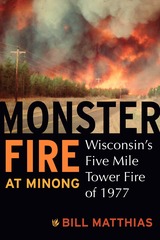 Monster Fire at Minong: Wisconsin’s Five Mile Tower Fire of 1977
Bill Matthias
Wisconsin Historical Society Press, 2010 Ignited by a single match on April 30, 1977, the Five Mile Tower Fire raged out of control for 17 hours. It would be one of the largest wildland fires in Wisconsin history, ultimately destroying more than 13,000 acres of land and 63 buildings. As a column of black pine smoke reached high in the sky, citizens from Minong, Chicog, Webster, Gordon, Wascott, Hayward, Spooner, Solon Springs, and other communities began showing up to help. The grassy field designated as fire headquarters quickly became a hub of activity, jammed with trucks, school buses, dozers on trailers, dump trucks, tanker trucks, fuel trucks, and hundreds of people waiting to sign in. More than 900 came in the first four hours, clogging the road with traffic in both directions. Headquarters personnel worked valiantly to coordinate citizens and DNR workers in a buildup of people and equipment unprecedented in the history of Wisconsin firefighting. Based on his own experiences during the long battle, plus dozens of interviews and other eyewitness accounts, Bill Matthias presents an in-depth look at the Five Mile Tower Fire, the brave citizens who helped fight it, and the important changes made to firefighting laws and procedures in its aftermath.
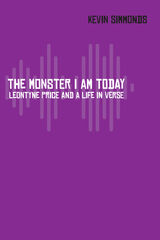 The Monster I Am Today: Leontyne Price and a Life in Verse
Kevin Simmonds
Northwestern University Press, 2021 Leontyne Price remains one of the twentieth century’s most revered opera singers and, notably, the first African American to achieve such international acclaim. In movements encompassing poetry and prose, writer and musician Kevin Simmonds explores Price as an icon, a diva, a woman, and a patriot—and himself as a fan, a budding singer, and a gay man—through passages that move polyphonically through the contested spaces of Black identity, Black sound, Black sensibility, and Black history.
Structured operatically into overture, acts, and postlude, The Monster I Am Today guides the reader through associative shifts from arias like “weather events” and Price’s forty-two-minute final ovation to memories of Simmonds’s coming of age in New Orleans. As he melds lyric forms with the biography of one of classical music’s greatest virtuosos, Simmonds composes a duet that spotlights Price’s profound influence on him as a person and an artist: “That’s how I hear: Her.”
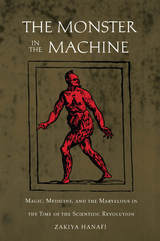 The Monster in the Machine: Magic, Medicine, and the Marvelous in the Time of the Scientific Revolution
Zakiya Hanafi
Duke University Press, 2000 The Monster in the Machine tracks the ways in which human beings were defined in contrast to supernatural and demonic creatures during the time of the Scientific Revolution. Zakiya Hanafi recreates scenes of Italian life and culture from the late sixteenth to the early eighteenth centuries to show how monsters were conceptualized at this particular locale and historical juncture—a period when the sacred was being supplanted by a secular, decidedly nonmagical way of looking at the world.
Noting that the word “monster” is derived from the Latin for “omen” or “warning,” Hanafi explores the monster’s early identity as a portent or messenger from God. Although monsters have always been considered “whatever we are not,” they gradually were tranformed into mechanical devices when new discoveries in science and medicine revealed the mechanical nature of the human body. In analyzing the historical literature of monstrosity, magic, and museum collections, Hanafi uses contemporary theory and the philosophy of technology to illuminate the timeless significance of the monster theme. She elaborates the association between women and the monstrous in medical literature and sheds new light on the work of Vico—particularly his notion of the conatus—by relating it to Vico’s own health. By explicating obscure and fascinating texts from such disciplines as medicine and poetics, she invites the reader to the piazzas and pulpits of seventeenth-century Naples, where poets, courtiers, and Jesuit preachers used grotesque figures of speech to captivate audiences with their monstrous wit.
Drawing from a variety of texts from medicine, moral philosophy, and poetics, Hanafi’s guided tour through this baroque museum of ideas will interest readers in comparative literature, Italian literature, history of ideas, history of science, art history, poetics, women’s studies, and philosophy.
 Monster Mash
Susan Browne
Four Way Books, 2025 Susan Browne (Winner of the Four Way Books Intro Prize in Poetry judged by Edward Hirsch) has crafted her fourth collection of poetry into an incendiary inventory of life’s urgency and vitality in this late-stage capitalist moment. In “Air Quality Index: 500,” while Browne “[wonders] what the government [is] doing during this era of cannibalism,” “a bald eagle [flies] by with its head on fire.” Monster Mash explores the surreal lyricism of this phenomenon—when what sounds like hyperbolic symbolism is actually just the news. Even if the national bird aflame makes a fitting metaphor for the state of our body politic, it also transcribes a true emergency in the poet’s direct sight—wilderness and civilization smoldering alike in the California wildfires. Amid the existential scale of climate and economic crises, Browne’s poems deftly illuminate how we must also navigate the daily necessities of our individual lives: tending to aging parents, grieving those who pass before us, “[waking] to the river of air conditioner noise,” “cleaning the litter box / or driving around the locked-down town, / looking for a house [you] can’t afford or a job that doesn’t exist.” In the words of Dorianne Laux, “Browne’s poems are songs to the suffering earth, to love in the face of the pitiless moon, merciless angels, [and] to the past and the future.” After all, Browne reminds us, not all of our wandering is aimless. The speaker at the wheel “wants to show you what’s still possible / out by the river, the egret & geese, / the fast-moving current, that autumn is here / & there, there, there / are dark pools of coolness under the leaves.”
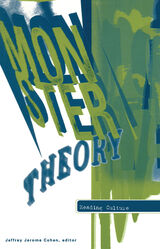 Monster Theory: Reading Culture
Jeffrey Jerome Cohen
University of Minnesota Press, 1996 Explores concepts of monstrosity in Western civilization from Beowulf to Jurassic Park. We live in a time of monsters. Monsters provide a key to understanding the culture that spawned them. So argue the essays in this wide-ranging and fascinating collection that asks the question, What happens when critical theorists take the study of monsters seriously as a means of examining our culture? In viewing the monstrous body as a metaphor for the cultural body, the contributors to Monster Theory consider beasts, demons, freaks, and fiends as symbolic expressions of cultural unease that pervade a society and shape its collective behavior. Through a historical sampling of monsters, these essays argue that our fascination for the monstrous testifies to our continued desire to explore difference and prohibition.Contributors: Mary Baine Campbell, Brandeis U; David L. Clark, McMaster U; Frank Grady, U of Missouri, St. Louis; David A. Hedrich Hirsch, U of Illinois; Lawrence D. Kritzman, Dartmouth College; Kathleen Perry Long, Cornell U; Stephen Pender; Allison Pingree, Harvard U; Anne Lake Prescott, Barnard College; John O'Neill, York U; William Sayers, George Washington U; Michael Uebel, U of Virginia; Ruth Waterhouse.
The Monster with a Thousand Faces: Guises of the Vampire in Myth and Literature
Brian J. Frost
University of Wisconsin Press, 1989 Brian Frost chronicles the history of the vampire in myth and literature, providing a sumptuous repast for all devotees of the bizarre. In a wide-ranging survey, including plot summaries of hundreds of novels and short stories, the reader meets an amazing assortment of vampires from the pages of weird fiction, ranging from the 10,000-year-old femme fatale in Robert E. Howard’s Conan the Conqueror to the malevolent fetus in Eddy C. Bertin’s “Something Small, Something Hungry.” Nostalgia buffs will enjoy a discussion of the vampire yarns in the pulp magazines of the interwar years, while fans of contemporary vampire fiction will also be sated.
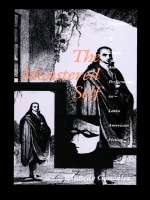 The Monstered Self: Narratives of Death and Performance in Latin American Fiction
Eduardo González
Duke University Press, 1992 Viewing stories and novels from an ethnographic perspective, Eduardo González here explores the relationship between myth, ritual, and death in writings by Borges, Vargas Llosa, Cortázar, and Roa Bastos. He then weaves this analysis into a larger cultural fabric composed of the works of Chaucer, Shakespeare, Joyce, Benjamin, H. G. Wells, Kafka, Poe, and others.
What interests González is the signature of authorial selfhood in narrative and performance, which he finds willfully and temptingly disfigured in the works he examines: horrific and erotic, subservient and tyrannical, charismatic and repellent. Searching out the personal image and plot, González uncovers two fundamental types of narrative: one that strips character of moral choice; and another in which characters' choices deprive them of personal autonomy and hold them in ritual bondage to a group. Thus The Monstered Self becomes a study of the conflict between individual autonomy and the stereotypes of solidarity.
Written in a characteristically allusive, elliptical style, and drawing on psychoanalysis, religion, mythology, and comparative literature, The Monstered Self is in itself a remarkable performance, one that will engage readers in anthropology, psychology, and cultural history as well as those specifically interested in Latin American narrative.
Monsters
Karen Brennan
Four Way Books, 2016 Literal as well as metaphorical monsters inhabit this book of 38 innovative fictions. Here the reader will encounter not only zombies and ghosts, but a lyrical dream braided into a brutal and sorrowful real world. Monsters’ vision embodies the heartbreakingly private and depressingly public—and the funny flipside of it all.
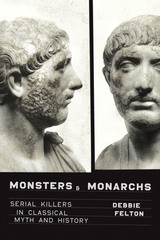 Monsters and Monarchs: Serial Killers in Classical Myth and History
By Debbie Felton
University of Texas Press, 2021 Jack the Ripper. Jeffrey Dahmer. John Wayne Gacy. Locusta of Gaul. If that last name doesn’t seem to fit with the others, it’s likely because our modern society largely believes that serial killers are a recent phenomenon. Not so, argues Debbie Felton—in fact, there’s ample evidence to show that serial killers stalked the ancient world just as they do the modern one. Felton brings this evidence to light in Monsters and Monarchs, and in doing so, forces us to rethink the assumption that serial killers arise from problems unique to modern society. Exploring a trove of stories from classical antiquity, she uncovers mythological monsters and human criminals that fit many serial killer profiles: the highway killers confronted by the Greek hero Theseus, such as Procrustes, who tortured and mutilated their victims; the Sphinx, or “strangler,” from the story of Oedipus; child-killing demons and witches, which could explain abnormal infant deaths; and historical figures such as Locusta of Gaul, the most notorious poisoner in the early Roman Empire. Redefining our understanding of serial killers and their origins, Monsters and Monarchs changes how we view both ancient Greek and Roman society and the modern-day killers whose stories still captivate the public today.
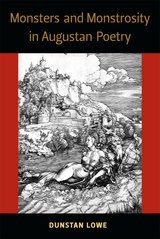 Monsters and Monstrosity in Augustan Poetry
Dunstan Lowe
University of Michigan Press, 2015 Roman poets of the Augustan period reinvented monsters from Greek myth, such as Harpies, Furies, and the warring Centaurs and Giants. These monsters represented the attractions and dangers of novelty in various contexts, ranging from social values to artistic innovation. Rome’s two great epics of the early principate, Vergil’s Aeneid and Ovid’s Metamorphoses, are both filled with mythical monsters. Like the culture that produced them, these poets were fascinated by unfamiliar forms despite their potential to disturb and disrupt. Monsters and Monstrosity in Augustan Poetry is the first full-length study of monsters in Augustan poetry, and the first metapoetic reading of monstrosity in classical antiquity. Dunstan Lowe takes a fresh approach to the canonical works of Vergil, Ovid, and their contemporaries, contributing to a very recent turn toward marvels, monsters, and deformity in classical studies. Monsters provided a fantastical means to explore attitudes toward human nature, especially in its relationship with sex. They also symbolized deformations of poetic form. Such gestures were doomed to replay the defeat of hypermasculine monsters yet, paradoxically, they legitimized poetic innovation. Lowe proposes that monstrosity was acutely topical during the birth of the principate, having featured in aesthetic debates of the Hellenistic age, while also serving as an established, if controversial, means for public figures to amaze the population and display their power. Monsters and Monstrosity in Augustan Poetry will appeal to scholars and students of classical Latin literature and of interdisciplinary monster studies.
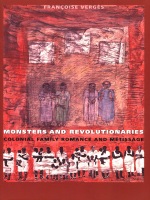 Monsters and Revolutionaries: Colonial Family Romance and Metissage
Françoise Vergès
Duke University Press, 1999 In Monsters and Revolutionaries Françoise Vergès analyzes the complex relationship between the colonizer and colonized on the Indian Ocean island of Réunion. Through novels, iconography, and texts from various disciplines including law, medicine, and psychology, Vergès constructs a political and cultural history of the island’s relations with France. Woven throughout is Vergès’s own family history, which is intimately tied to the history of Réunion itself.
Originally settled by sugar plantation owners and their Indian and African slaves following a seventeenth-century French colonial decree, Réunion abolished slavery in 1848. Because plantation owners continued to import workers from India, Africa, Asia, and Madagascar, the island was defined as a place based on mixed heritages, or métissage. Vergès reads the relationship between France and the residents of Réunion as a family romance: France is the seemingly protective mother, La Mère-Patrie, while the people of Réunion are seen and see themselves as France’s children. Arguing that the central dynamic in the colonial family romance is that of debt and dependence, Verges explains how the republican ideals of the French Revolution and the Enlightenment are seen as gifts to Réunion that can never be repaid. This dynamic is complicated by the presence of métissage, a source of anxiety to the colonizer in its refutation of the “purity” of racial bloodlines. For Vergès, the island’s history of slavery is the key to understanding métissage, the politics of assimilation, constructions of masculinity, and emancipatory discourses on Réunion.
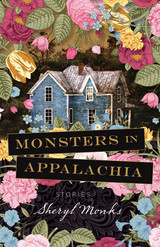 Monsters in Appalachia: Stories
Sheryl Monks
West Virginia University Press, 2016 The characters within these fifteen stories are in one way or another staring into the abyss. While some are awaiting redemption, others are fully complicit in their own undoing.
We come upon them in the mountains of West Virginia, in the backyards of rural North Carolina, and at tourist traps along Route 66, where they smolder with hidden desires and struggle to resist the temptations that plague them.
A Melungeon woman has killed her abusive husband and drives by the home of her son’s new foster family, hoping to lure the boy back. An elderly couple witnesses the end-times and is forced to hunt monsters if they hope to survive. A young girl “tanning and manning” with her mother and aunt resists being indoctrinated by their ideas about men. A preacher’s daughter follows in the footsteps of her backsliding mother as she seduces a man who looks a lot like the devil.
A master of Appalachian dialect and colloquial speech, Monks writes prose that is dark, taut, and muscular, but also beguiling and playful. Monsters in Appalachia is a powerful work of fiction.
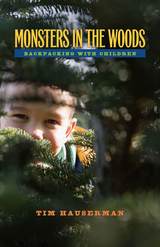 Monsters In The Woods: Backpacking With Children
Tim Hauserman
University of Nevada Press, 2007 How and why you should take your children backpackingDespite America’s enthusiasm for outdoors activities like hiking and backpacking, most books on these subjects focus on adults. Backpacking, however, is an ideal activity for the entire family. Tim Hauserman, who is both an experienced outdoors guide and the father of two daughters, now offers a handbook for parents who would like to introduce their children to backpacking and camping. Hauserman provides practical, humorous advice for families new to the outdoors and for trail-savvy parents planning to take their children along for the first time: how to prepare, what to bring, who carries what, how far to walk, what to do in camp, safety precautions, dealing with mishaps, and proper trail and campground etiquette. He includes guidance about appropriate distances and pack weights for every age level of child, as well as tips about backpacking with an infant and bringing the family dog along on the adventure. He even suggests appealing destinations in the Sierra Nevada appropriate for various age groups and recounts some of his (and his daughters’) favorite hikes. Hauserman’s down-to-earth encouragement is based on decades of backpacking and camping with his own children, their friends, and other groups of youngsters. He is candid about his experiences and the lessons he learned from his own mistakes and how he dealt with them. Ultimately, the reward of sharing a special adventure and the peace and beauty of the outdoors makes all the effort worthwhile.
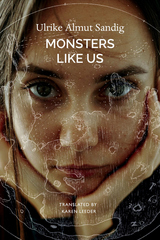 Monsters Like Us
Ulrike Almut Sandig
Seagull Books, 2022 A novel of two young friends growing up on divergent paths in the last days of Communist East Germany.
What is it like to be young and broken in a country that is on the brink of collapse? This is what acclaimed poet and sound artist Ulrike Almut Sandig shows us in her debut novel, through the story of old friends Ruth and Viktor in the last days of Communist East Germany. The two central characters are inseparable since kindergarten, but they are forced to go their different ways to escape their difficult childhood: Ruth into music and the life of a professional musician; Viktor into violence and a neo-Nazi gang. Monsters Like Us is a story of families, a story of abuse, a story about the search for redemption and the ways it takes shape over generations. More than anything, it is about the stories we tell ourselves about who we are, and who we want to be. Bold, brutal, and lyrical, this is a coming-of-age novel that charts the hidden violence of the world we live in today.
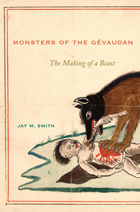 Monsters of the Gévaudan: The Making of a Beast
Jay M. Smith
Harvard University Press, 2011 In a brilliant, original rendition, Monsters of the Gévaudan revisits a spellbinding French tale that has captivated imaginations for over two hundred years, and offers the definitive explanation of the strange events that underlie this timeless story.
In 1764 a peasant girl was killed and partially eaten while tending a flock of sheep. Eventually, over a hundred victims fell prey to a mysterious creature, or creatures, whose cunning and deadly efficiency terrorized the region and mesmerized Europe. The fearsome aggressor quickly took on mythic status, and the beast of the Gévaudan passed into French folklore.
What species was this killer, why did it decapitate so many of its victims, and why did it prefer the flesh of women and children? Why did contemporaries assume that the beast was anything but a wolf, or a pack of wolves, as authorities eventually claimed, and why is the tale so often ignored in histories of the ancien régime? Smith finds the answer to these last two questions in an accident of timing. The beast was bound to be perceived as strange and anomalous because its ravages coincided with the emergence of modernity itself.
Expertly situated within the social, intellectual, cultural, and political currents of French life in the 1760s, Monsters of the Gévaudan will engage a wide range of readers with both its recasting of the beast narrative and its compelling insights into the allure of the monstrous in historical memory.
 Monsters vs. Patriarchy: Toxic Imagination in Global Horror Cinema
Patricia Saldarriaga
Rutgers University Press, 2025 Across the globe, the violent effects of patriarchy are manifest. Women, trans people, gender-nonconforming people, and the racialized Other are regularly subjected to physical danger, beginning with the denial of vitally important health care, and, in its most horrific form, rape, trafficking, and murder. Monsters vs. Patriarchy links these real-world horrors to the monstrification and dehumanization of people as expressed in contemporary global cinema. This monstrification has been achieved through a toxic imagination attributed to women, a trait that historically referred to the power of women to negatively affect others, including their own children in the womb, with only the use of their imagination. This process reflects the misogynist and racist world in which we live, where female bodies, people of color, and alternative identities represent a threat to patriarchal power.
Monsters vs. Patriarchy examines female monstrosity as it appears in horror films from around the world and considers specific political, scientific, and historical contexts to better understand how we construct and reconstruct monstrosity, using an intersectional approach to examine the imposition of gender and racial hierarchies that support national power structures. The authors contend that monstrous female cinematic subjects, including ghosts, witches, cannibals, and posthuman beings, are becoming empowered, using the tools of their monstrification to smash the colonial, white supremacist, and misogynist structures that created them.
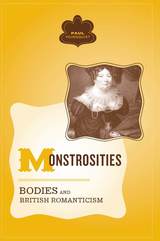 Monstrosities: Bodies And British Romanticism
Paul Youngquist
University of Minnesota Press, 2003 A surprising evaluation of the role of the physical body in the construction of British identity Eighteenth-century medicine used the word “monstrosities” to describe physically deformed bodies—those irreducible to the “proper body” in their singular, sometimes startling difference. Considering British society in confrontation with such monstrosities, Paul Youngquist reveals the cultural politics of embodiment in Britain during the late eighteenth and early nineteenth centuries. Drawing on the histories of medicine, economics, liberalism, and nationalism, his work shows that bodies are not simply born but rather built by cultural practices directed toward particular social ends. Among the phenomena Youngquist treats are the science of comparative anatomy, the annual festivity of Bartholomew Fair, the social status of black Britons, opium habitués, pregnant women, and wounded war veterans. The authors he engages include John Locke, William Blake, Olaudah Equiano, Samuel Taylor Coleridge, Thomas De Quincey, Mary Wollstonecraft, Lord Byron, and Mary Shelley. Uniquely interdisciplinary, formidably researched, and replete with curious illustrations, this remarkable book should be of interest to anyone concerned with the historical and cultural fate of bodies in liberal society—and with the importance of deviance in determining that fate.
 Monstrosity, Bodies, and Knowledge in Early Modern England: Curiosity to See and Behold
Whitney Dirks
Amsterdam University Press, 2024 In 1680, the poor cottager Mary Herring gave birth to conjoined twins. At two weeks of age, they were kidnapped to be shown for money, and their deaths shortly thereafter gave rise to a four-year legal battle over ownership and income. The Herring twins’ microhistory weaves throughout this book, as the chapter structure alternates between the family’s ordeal and the broader cultural context of how so-called ‘monstrous births’ (a contemporary term for deformed humans and animals) were discussed in cheap print, exhibited in London’s pubs and coffeehouses, examined by the Royal Society, portrayed in visual culture, and litigated in London’s legal courts. This book ties together social and medical history, Disability Studies, and Monster Studies to argue that people discussed unusual bodies in early modern England because they provided newsworthy entertainment, revealed the will of God, and demonstrated the internal workings of Nature.
 Monstrosity in Games and Play: A Multidisciplinary Examination of the Monstrous in Contemporary Cultures
Sarah Stang
Amsterdam University Press, 2025 Monsters fascinate us. From ancient folklore to contemporary digital games, they are at the core of the stories we tell. They reflect our fears, deepest desires, and the monstrosity hidden within ourselves. Monsters hold a mirror to our contemporary society and reveal who we truly are.
This edited collection examines monsters and monstrosity in games and play. Monsters are a key feature of most games: we fight, kill, and eat them—and sometimes, we become them. However, monsters in games and play are not only entertaining but also a reflection of the monstrosity of our world. In this book, twenty-two scholars explore how themes such as mental health, colonialism, individualism, disability, gender, sexuality, racism, and exclusion are reflected in the monsters we interact with in games, play, and our daily lives both online and offline.
Monstrosity in Games and Play is recommended to readers interested in the monstrous in contemporary game cultures and their surrounding societies.
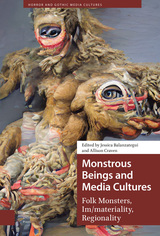 Monstrous Beings and Media Cultures: Folk Monsters, Im/materiality, Regionality
Jessica Balanzategui
Amsterdam University Press, 2023 Monstrous Beings and Media Cultures examines the monsters and sinister creatures that spawn from folk horror, Gothic fiction, and from various sectors of media cultures. The collection illuminates how folk monsters form across different art and media traditions, and interrogates the 21C revitalization of “folk” as both a cultural formation and aesthetic mode. The essays explore how combinations of vernacular and institutional creative processes shape the folkloric and/or folkoresque attributes of monstrous beings, their popularity, and the contexts in which they are received.
While it focuses on 21C permutations of folk monstrosity, the collection is transhistorical in approach, featuring chapters that focus on contemporary folk monsters, historical antecedents, and the pre-C21st art and media traditions that shaped enduring monstrous beings. The collection also illuminates how folk monsters and folk “horror” travel across cultures, media, and time periods, and how iconic monsters are tethered to yet repeatedly become unanchored from material and regional contexts.
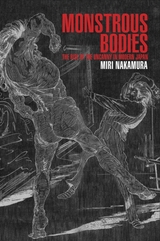 Monstrous Bodies: The Rise of the Uncanny in Modern Japan
Miri Nakamura
Harvard University Press, 2015 Monstrous Bodies is a cultural and literary history of ambiguous bodies in imperial Japan. It focuses on what the book calls modern monsters—doppelgangers, robots, twins, hybrid creations—bodily metaphors that became ubiquitous in the literary landscape from the Meiji era (1868–1912) up until the outbreak of the Second Sino-Japanese War in 1937. Such monsters have often been understood as representations of the premodern past or of “stigmatized others”—figures subversive to national ideologies. Miri Nakamura contends instead that these monsters were products of modernity, informed by the newly imported scientific discourses on the body, and that they can be read as being complicit in the ideologies of the empire, for they are uncanny bodies that ignite a sense of terror by blurring the binary of “normal” and “abnormal” that modern sciences like eugenics and psychology created. Reading these literary bodies against the historical rise of the Japanese empire and its colonial wars in Asia, Nakamura argues that they must be understood in relation to the most “monstrous” body of all in modern Japan: the carefully constructed image of the empire itself.
 Monstrous Imagination
Marie-Hélène Huet
Harvard University Press, 1993 “What woeful maternal fancy produced such a monster?” This was once the question asked when a deformed infant was born. From classical antiquity through the Enlightenment, the monstrous child bore witness to the fearsome power of the mother's imagination. What such a notion meant and how it reappeared, transformed, in the Romantic period are the questions explored in this book, a fascinating study of theories linking imagination, art, and monstrous progeny.
Down through the Middle Ages and the Renaissance, philosophers and men of science rendered their learned opinions on the power of the female imagination to dominate, and thus distort, the act of procreation. Drawing on biological and physiological texts from classical times through the nineteenth century, Marie-Hélène Huet presents this argument as it evolved and as it reflected doubts about the force of paternity. She shows how, in the late eighteenth century, the discussion shifted from the scientific sphere to the aesthetic, and how the idea of imagination as monstrous progenitor eventually became a Romantic conceit. In reinterpreting art as teratology, however, Romanticism reclaimed the subversive power of imagination as a masculine attribute; it was now the artist as monstrous father who would generate new forms. From Ambroise Pare to Diderot, from Shelley to Hawthorne, Balzac and Villiers de l'Isle-Adam, as Huet demonstrates, the monster and the work of art challenged preconceived ideas of the natural order of things—and disclosed, for all to see, the silent desire of their makers: to procreate without the other.
In this analysis of monstrous genesis Huet examines anew such questions as the authorship of Frankenstein, the birth of the Tussaud wax museum, and the ancient legend of the golem. Bringing together philosophy and science, aesthetics and popular culture, Monstrous Imagination is a marvel of intellectual history—a remarkable account of how the imagination has manifested itself, above all, in theory.
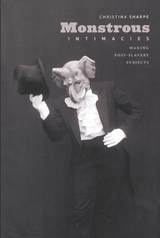 Monstrous Intimacies: Making Post-Slavery Subjects
Christina Sharpe
Duke University Press, 2010 Arguing that the fundamental, familiar, sexual violence of slavery and racialized subjugation have continued to shape black and white subjectivities into the present, Christina Sharpe interprets African diasporic and Black Atlantic visual and literary texts that address those “monstrous intimacies” and their repetition as constitutive of post-slavery subjectivity. Her illuminating readings juxtapose Frederick Douglass’s narrative of witnessing the brutal beating of his Aunt Hester with Essie Mae Washington-Williams’s declaration of freedom in Dear Senator: A Memoir by the Daughter of Strom Thurmond, as well as the “generational genital fantasies” depicted in Gayl Jones’s novel Corregidora with a firsthand account of such “monstrous intimacies” in the journals of an antebellum South Carolina senator, slaveholder, and vocal critic of miscegenation. Sharpe explores the South African–born writer Bessie Head’s novel Maru—about race, power, and liberation in Botswana—in light of the history of the KhoiSan woman Saartje Baartman, who was displayed in Europe as the “Hottentot Venus” in the nineteenth century. Reading Isaac Julien’s film The Attendant, Sharpe takes up issues of representation, slavery, and the sadomasochism of everyday black life. Her powerful meditation on intimacy, subjection, and subjectivity culminates in an analysis of Kara Walker’s black silhouettes, and the critiques leveled against both the silhouettes and the artist.
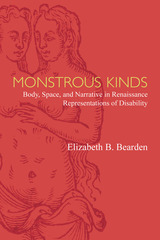 Monstrous Kinds: Body, Space, and Narrative in Renaissance Representations of Disability
Elizabeth B. Bearden
University of Michigan Press, 2019 Monstrous Kinds is the first book to explore textual representations of disability in the global Renaissance. Elizabeth B. Bearden contends that monstrosity, as a precursor to modern concepts of disability, has much to teach about our tendency to inscribe disability with meaning. Understanding how early modern writers approached disability not only provides more accurate genealogies of disability, but also helps nuance current aesthetic and theoretical disability formulations.
The book analyzes the cultural valences of early modern disability across a broad national and chronological span, attending to the specific bodily, spatial, and aesthetic systems that contributed to early modern literary representations of disability. The cross section of texts (including conduct books and treatises, travel writing and wonder books) is comparative, putting canonical European authors such as Castiglione into dialogue with transatlantic and Anglo-Ottoman literary exchange. Bearden questions grand narratives that convey a progression of disability from supernatural marvel to medical specimen, suggesting that, instead, these categories coexist and intersect.
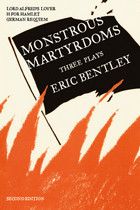 Monstrous Martyrdoms: Three Plays
Eric Bentley
Northwestern University Press, 2004 Winner of 2006 International Association of Theatre Critics Thalia Prize
Recipient of 2007 The Robert Chesley Foundation Lifetime Achievement Award in Playwriting
Winner of 2006 Village Voice OBIE Awards Lifetime Achievement Award
"The road will be red with monstrous martyrdoms, but we shall win." Oscar Wilde wrote these words at the end of the nineteenth century after serving two years at hard labor for the crime of being homosexual. This modern martyrdom is the subject of Lord Alfred's Lover, Eric Bentley's Brechtian dramatization of Wilde's last days.
H for Hamlet is another variation on the modern martyr play, this time in homage to Pirandello. The protagonist thinks, or once thought, he was Hamlet. Fantasy? Perhaps. But, to paraphrase Marianne Moore, there was a real toad in the imaginary garden--a real martyr in the toy theatre.
In German Requiem, Bentley takes inspiration from Heinrich von Kleist's play The Schroffenstein Family, which in turn is a version of Shakespeare's Romeo and Juliet. The young star-crossed lovers in his play are martyrs of an internecine conflict much like those seen in recent history in Ireland and the Middle East.
 Monstrous Nature and Representations of Environmental Harms: A Green Cultural Criminological Perspective
Avi Brisman and Nigel South
Temple University Press, 2025 How does culture influence human relationships with the environment? In Monstrous Nature and Representations of Environmental Harms, green cultural criminologists Avi Brisman and Nigel South examine stories of monsters and disasters to address how the ways we depict and think about harms to the environment dissuade us from taking care of our planet and each other.
The authors use examples from popular culture, including Disney and Marvel Cinematic Universe films, to consider ideas about how the environment responds to people who cause it harm. Brisman and South identify and discuss three dominant and interrelated depictions of the relationship between humans and the environment: first, nature as monstrous or fear inducing; second, nature and the Earth (or parts of it) as abject; and third, the entanglement of nature and the apocalypse, wherein nature is contributing to the end of the world, with an end point sometimes conceptualized as one without humans.
Monstrous Nature and Representations of Environmental Harms argues that such representations have material consequences. The authors make the case for challenging them so that we neither perpetuate them nor retreat into cynicism and defeatism about the future of our planet.
 Monstrous Politics: Geography, Rights, and the Urban Revolution in Mexico City
Ben Gerlofs
Vanderbilt University Press, 2022 The birth of the world’s great megacities is the surest and starkest harbinger of the “urban age” inaugurated in the twentieth century. As the world’s urban population achieves majority for the first time in recorded history, theories proliferate on the nature of urban politics, including the shape and quality of urban democracy, the role of urban social and political movements, and the prospects for progressive and emancipatory change from the corridors of powerful states to the routinized rhythms of everyday life. At stake are both the ways in which the rapidly changing urban world is understood and the urban futures being negotiated by the governments and populations struggling to contend with these changes and forge a place in contemporary cities.
Transdisciplinary by design, Monstrous Politics first moves historically through Mexico City’s turbulent twentieth century, driven centrally by the contentious imbrication of the Institutional Revolutionary Party (PRI) and its capital city. Participant observation, expert interviews, and archival materials demonstrate the shifting strategies and alliances of recent decades, provide the reader with a sense of the texture of contemporary political life in the city during a time of unprecedented change, and locate these dynamics within the history and geography of twentieth-century urbanization and political revolution. Substantive ethnographic chapters trace the emergence and decline of the political language of “the right to the city,” the establishment and contestation of a “postpolitical” governance regime, and the culmination of a century of urban politics in the processes of “political reform” by which Mexico City finally wrested back significant political autonomy and local democracy from the federal state.
A four-fold transection of the revolutionary structure of feeling that pervades the city in this historic moment illustrates the complex and contradictory sentiments, appraisals, and motivations through which contemporary politics are understood and enacted. Drawing on theories of social revolution that embrace complexity, and espousing a methodology that foregrounds the everyday nature of politics, Monstrous Politics develops an understanding of revolutionary urban politics at once contextually nuanced and conceptually expansive, and thus better able to address the realities of politics in the “urban age” even beyond Mexico City.
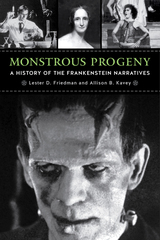 Monstrous Progeny: A History of the Frankenstein Narratives
Friedman, Lester D
Rutgers University Press, 2016 Mary Shelley’s 1818 novel Frankenstein is its own type of monster mythos that will not die, a corpus whose parts keep getting harvested to animate new artistic creations. What makes this tale so adaptable and so resilient that, nearly 200 years later, it remains vitally relevant in a culture radically different from the one that spawned its birth? Monstrous Progeny takes readers on a fascinating exploration of the Frankenstein family tree, tracing the literary and intellectual roots of Shelley’s novel from the sixteenth century and analyzing the evolution of the book’s figures and themes into modern productions that range from children’s cartoons to pornography. Along the way, media scholar Lester D. Friedman and historian Allison B. Kavey examine the adaptation and evolution of Victor Frankenstein and his monster across different genres and in different eras. In doing so, they demonstrate how Shelley’s tale and its characters continue to provide crucial reference points for current debates about bioethics, artificial intelligence, cyborg lifeforms, and the limits of scientific progress. Blending an extensive historical overview with a detailed analysis of key texts, the authors reveal how the Frankenstein legacy arose from a series of fluid intellectual contexts and continues to pulsate through an extraordinary body of media products. Both thought-provoking and entertaining, Monstrous Progeny offers a lively look at an undying and significant cultural phenomenon.
 Monstrous Work and Radical Satisfaction: Black Women Writing under Segregation
Eve Dunbar
University of Minnesota Press, 2024 Radical Black feminist refusal through the works of mid-twentieth-century African American women writers
Monstrous Work and Radical Satisfaction offers new and insightful readings of African American women’s writings in the 1930s–1950s, illustrating how these writers centered Black women’s satisfaction as radical resistance to the false and incomplete promise of liberal racial integration. Eve Dunbar examines the writings of Ann Petry, Dorothy West, Alice Childress, and Gwendolyn Brooks to show how these women explored self-fulfillment over normative and sanctioned models of national belonging. Paying close attention to literary moments of disruption, miscommunication, or confusion rather than ease, assimilation, or mutual understanding around race and gender, Dunbar tracks these writers’ dissatisfaction with American race relations. She shows how Petry, West, Childress, and Brooks redeploy the idea of monstrous work to offer potential modalities for registering Black women’s capacity to locate satisfaction within the domestic and interpersonal. While racial integration may satisfy the national idea of equality and inclusion, it has not met the long-term needs of Black people’s quest for equity. Dunbar responds, demonstrating how these mid-century women offer new blueprints for Black life by creating narrative models for radical satisfaction: Black women’s completeness, joy, and happiness outside the bounds of normative racial inclusion.
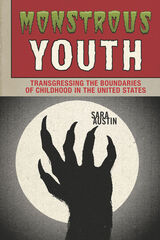 Monstrous Youth: Transgressing the Boundaries of Childhood in the United States
Sara Austin
Ohio State University Press, 2022 Winner, 2024 Children’s Literature Association Book Award The monstrous has a long, complicated history within children’s popular media. In Monstrous Youth: Transgressing the Boundaries of Childhood in the United States, Sara Austin traces the evolution of monstrosity as it relates to youth culture from the 1950s to the present day to spotlight the symbiotic relationship between monstrosity and the bodies and identities of children and adolescents. Examining comics, films, picture books, novels, television, toys and other material culture—including Monsters, Inc. and works by Mercer Mayer, Maurice Sendak, R. L. Stine, and Stephanie Meyer—Austin tracks how the metaphor of monstrosity excludes, engulfs, and narrates difference within children’s culture. Analyzing how cultural shifts have drastically changed our perceptions of both what it means to be a monster and what it means to be a child, Austin charts how the portrayal and consumption of monsters corresponds to changes in identity categories such as race, sexuality, gender, disability, and class. In demonstrating how monstrosity is leveraged in service of political and cultural movements, such as integration, abstinence-only education, and queer rights, Austin offers insight into how monster texts continue to reflect, interpret, and shape the social discourses of identity within children’s culture.
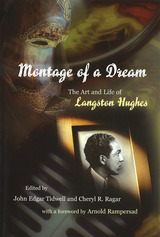 Montage of a Dream: The Art and Life of Langston Hughes
Edited by John Edgar Tidwell & Cheryl R. Ragar, Foreword by Arnold Rampersad
University of Missouri Press, 2007 Over a forty-six-year career, Langston Hughes experimented with black folk expressive culture, creating an enduring body of extraordinary imaginative and critical writing. Riding the crest of African American creative energy from the Harlem Renaissance to the onset of Black Power, he commanded an artistic prowess that survives in the legacy he bequeathed to a younger generation of writers, including award winners Alice Walker, Paule Marshall, and Amiri Baraka. Montage of a Dream extends and deepens previous scholarship, multiplying the ways in which Hughes’s diverse body of writing can be explored. The contributors, including such distinguished scholars as Steven Tracy, Trudier Harris, Juda Bennett, Lorenzo Thomas, and Christopher C. De Santis, carefully reexamine the significance of his work and life for their continuing relevance to American, African American, and diasporic literatures and cultures. Probing anew among Hughes’s fiction, biographies, poetry, drama, essays, and other writings, the contributors assert fresh perspectives on the often overlooked “Luani of the Jungles” and Black Magic and offer insightful rereadings of such familiar pieces as “Cora Unashamed,” “Slave on the Block,” and Not without Laughter. In addition to analyzing specific works, the contributors astutely consider subjects either lightly explored by or unavailable to earlier scholars, including dance, queer studies, black masculinity, and children’s literature. Some investigate Hughes’s use of religious themes and his passion for the blues as the fabric of black art and life; others ponder more vexing questions such as Hughes’s sexuality and his relationship with his mother, as revealed in the letters she sent him in the last decade of her life. Montage of a Dream richly captures the power of one man’s art to imagine an America holding fast to its ideals while forging unity out of its cultural diversity. By showing that Langston Hughes continues to speak to the fundamentals of human nature, this comprehensive reconsideration invites a renewed appreciation of Hughes’s work—and encourages new readers to discover his enduring relevance as they seek to understand the world in which we all live.
Montaigne and the Origins of Modern Philosophy
Ann Hartle
Northwestern University Press, 2013 Montaigne’s Essays are rightfully studied as giving birth to the literary form of that name. Ann Hartle’s Montaigne and the Origins of Modern Philosophy argues that the essay is actually the perfect expression of Montaigne as what he called "a new figure: an unpremeditated and accidental philosopher." Unpremeditated philosophy is philosophy made sociable—brought down from the heavens to the street, where it might be engaged in by a wider audience. In the same philosophical act, Montaigne both transforms philosophy and invents "society," a distinctly modern form of association. Through this transformation, a new, modern character emerges: the individual, who is neither master nor slave and who possesses the new virtues of integrity and generosity. In Montaigne’s radically new philosophical project, Hartle finds intimations of both modern epistemology and modern political philosophy.
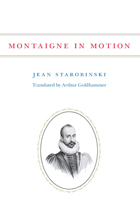 Montaigne in Motion
Jean Starobinski
University of Chicago Press, 1985 Educated in the humanities and trained in psychiatry, Jean Starobinski is a central figure in the Geneva School of criticism. His classic work, Montaigne in Motion, is a subtly conceived and elegantly written study of the Essais of Montaigne, whose deceptively plainspoken meditations have entranced readers and stimulated philosophers since their first publication in 1580 and 1595. Here Starobinski offers a decidedly postmodern reading of Montaigne. In chapters dealing with the themes of public and private life, friendship, death, the body, and love, Starobinski reveals much that will remind us that Montaigne’s thought is as apropos to our time as it was to his own. “The most important contribution to Montaigne studies since Friedrich’s work . . . . [It] will be the critical framework in which scholars will discuss Montaigne in the years to come.”—Choice “Starobinski brings Montaigne to life by treating him as our contemporary and asking him modern questions.”—Hudson Review
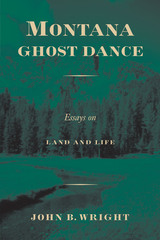 Montana Ghost Dance: Essays on Land and Life
By John B. Wright
University of Texas Press, 1998 Montana has been the "last best place" for so many people. A century ago, Native Americans gathered here to perform the Ghost Dance—a last, doomed attempt to make white settlers vanish and bring back the old ways of life. Today, people are still pouring into Montana, looking for the pristine wilderness they saw in A River Runs through It. The reality of Montana—indeed, of all the West—has never matched the myths, but this book eloquently explores how the search for a perfect place is driving growth, development, and resource exploitation in Big Sky country. In ten personal essays, John Wright looks at such things as Montana myths; old-timers; immigrants; elk; ways of seeing the landscape; land conservation and land trusts; the fate of the Blackfoot, Bitterroot, and Paradise valleys; and some means of preserving the last, best places. These reflections offer a way of understanding Montana that goes far beyond the headlines about militia groups and celebrities' ranches. Montana never was or will be a pristine wilderness, but Wright believes that much can be saved if natives and newcomers alike see what stands to be lost. His book is a wake-up call, not a ghost dance.
Montana Pay Dirt: Guide To Mining Camps Of Treasure State
Muriel Sibell Wolle
Ohio University Press, 1963 “In her pictures of mountain scenery and miners’ cabins, deserted mills and smelters, empty boarding houses, once-lavish hotels, and forgotten stores and post offices, Muriel Sibell Wolle has preserved the authentic look of the Montana mining frontier in a poignant and effective record.” — Allan Radbourne, The English Westerners Tally Sheet
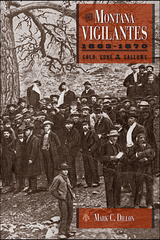 The Montana Vigilantes 1863–1870: Gold,Guns and Gallows
Mark C. Dillon
Utah State University Press, 2016 Historians and novelists alike have described the vigilantism that took root in the gold-mining communities of Montana in the mid-1860s, but Mark C. Dillon is the first to examine the subject through the prism of American legal history, considering the state of criminal justice and law enforcement in the western territories and also trial procedures, gubernatorial politics, legislative enactments, and constitutional rights.
Using newspaper articles, diaries, letters, biographies, invoices, and books that speak to the compelling history of Montana’s vigilantism in the 1860s, Dillon examines the conduct of the vigilantes in the context of the due process norms of the time. He implicates the influence of lawyers and judges who, like their non-lawyer counterparts, shaped history during the rush to earn fortunes in gold.
Dillon’s perspective as a state Supreme Court justice and legal historian uniquely illuminates the intersection of territorial politics, constitutional issues, corrupt law enforcement, and the basic need of citizenry for social order. This readable and well-directed analysis of the social and legal context that contributed to the rise of Montana vigilante groups will be of interest to scholars and general readers interested in Western history, law, and criminal justice for years to come.
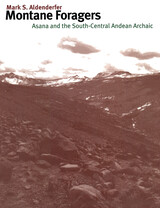 Montane Foragers: Asana and the South-Central Andean Archaic
Mark S. Aldenderfer
University of Iowa Press, 1998 All previous books dealing with prehistoric hunter-gatherers in the high Andes have treated ancient mountain populations from a troglodyte's perspective, as if they were little different from lowlanders who happened to occupy jagged terrain. Early mountain populations have been transformed into generic foragers because the basic nature of high-altitude stress and biological adaptation has not been addressed. In Montane Foragers, Mark Aldenderfer builds a unique and penetrating model of montane foraging that justly shatters this traditional approach to ancient mountain populations.
Aldenderfer's investigation forms a methodological and theoretical tour de force that elucidates elevational stress—what it takes for humans to adjust and survive at high altitudes. In a masterful integration of mountain biology and ecology, he emphasizes the nature of hunter-gatherer adaptations to high-mountain environments. He carefully documents the cultural history of Asana, the first stratified, open-air site discovered in the highlands of the south-central Andes. He establishes a number of major occurrences at this revolutionary site, including the origins of plant and animal domestication and transitions to food production, the growth and packing of forager populations, and the advent of some form of complexity and social hierarchy.
The rich and diversified archaeological record recovered at Asana—which spans from 10,000 to 3,500 years ago—includes the earliest houses as well as public and ceremonial buildings in the central cordillera. Built, used, and abandoned over many millennia, the Asana structures completely transform our understanding of the antiquity and development of native American architecture. Aldenderfer's detailed archaeological case study of high-elevation foraging adaptation, his description of this extreme environment as a viable human habitat, and his theoretical model of montane foraging create a new understanding of the lifeways of foraging peoples worldwide.
Monte Alban's Hinterland, Part I: The Prehispanic Settlement Patterns of the Central and Southern Parts of the Valley of Oaxaca, Mexico
Richard E. Blanton, Stephen Kowalewski, Gary Feinman, and Jill Appel
University of Michigan Press, 1982 In this work, the authors interpret archaeological data on roughly 3000 years of human history in the Valley of Oaxaca, from roughly 1500 BC to AD 1500. They integrate information on settlement patterns, political and social organization, artifact distribution, and more.
Monte Albán's Hinterland, Part II: Prehispanic Settlement Patterns in Tlacolula, Etla, and Ocotlan, the Valley of Oaxaca, Mexico, Vols. 1 and 2
Stephen Kowalewski, Gary Feinman, Laura Finsten, Richard Blanton, and Linda Nicholas
University of Michigan Press, 1989 This two-volume monograph is the final report and synthesis of the Valley of Oaxaca Settlement Pattern Project’s full-coverage surface survey and makes significant theoretical and methodological contributions to the investigation of social evolution, cultural ecology, and regional analysis.
 Monte Cassino in the Middle Ages
Herbert Bloch
Harvard University Press, 1986 The monastery of Monte Cassino, founded by St. Benedict in the sixth century, was the cradle of Western monasticism. It became one of the vital centers of culture and learning in Europe. At the height of its influence, in the eleventh and early twelfth centuries, two of its abbots (including Desiderius) and one of its monks became popes, and it controlled a vast network of dependencies—churches, monasteries, villages, and farms—especially in central and southern Italy.
Herbert Bloch's study, the product of forty years of research, takes as its starting point the twelfth-century bronze doors of the basilica of the abbey, the most significant relic of the medieval structure. The panels of these doors are inscribed with a list of more than 180 of the abbey's possessions. Mr. Bloch has supplemented this roster with lists found in papal and imperial privileges and other documents. The heart of the book is a detailed investigation of the nearly 700 dependencies of Monte Cassino from the sixth to the twelfth century and beyond. No comparable study of this or any other great medieval institution has ever before been undertaken.
Ironically, it was the bombing of 1944, which destroyed the monastery, that led to an unexpected revelation: the discovery, on the reverse side of some panels of the doors, of magnificent engraved figures of patriarchs and apostles. These proved to be remnants of the church portal ordered from Constantinople by Desiderius in the eleventh century, which marked the beginning of the grandiose reconstruction of the abbey and its church, the latter to become a model for many other churches. In order to solve the riddle of the doors of Monte Cassino, Bloch has investigated other bronze doors of Byzantine origin in Italy and the doors of the great Italian master Oderisius of Benevento, as well as those of S. Clemente a Casauria and of the cathedral of Benevento. Also included is a study of the political and cultural impact of Byzantium on Monte Cassino and a chapter on Constantinus Africanus, Saracen turned monk, one of the most interesting figures in the history of medieval medicine.
The text is sumptuously illustrated with 193 plates; most of the more than 300 illustrations have never before been published. This three-volume work, with its nine detailed indexes, offers a wealth of information for scholars in many different fields.
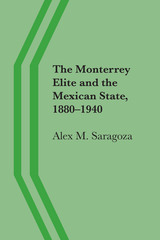 The Monterrey Elite and the Mexican State, 1880–1940
By Alex M. Saragoza
University of Texas Press, 1988 After the Revolution of 1910, a powerful group of Monterrey businessmen led by the Garza-Sada family emerged as a key voice of the Mexican private sector. The Monterrey Elite and The Mexican State is the first major historical study of the "Grupo Monterrey," the business elite that transformed Monterrey into a premier industrial center, the "Pittsburgh" of Mexico. Drawing on archival resources in the United States and Mexico and the work of previous scholars, Alex Saragoza examines the origins of the Monterrey elite. He argues that a "pact" between the new state and business interests was reached by the 1940 presidential elections—an accord that paved the way for the "alliance for profits" that has characterized relations between the Mexican state and capitalists since that time. More than a standard business history, this study delves into both the intimate social world of the Garza-Sadas and their allies and the ideas, beliefs, and vision of the Monterrey elite that set it apart from and often against the Mexican government. In so doing, The Monterrey Elite and the Mexican State reveals the underlying forces that led to the most historic battle between the private sector and the Mexican state: the dramatic showdown in 1936 between the Garza-Sadas and then President Lázaro Cárdenas in Monterrey, Nuevo León.
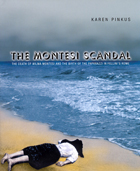 The Montesi Scandal: The Death of Wilma Montesi and the Birth of the Paparazzi in Fellini's Rome
Karen Pinkus
University of Chicago Press, 2003 Early on a windy morning in April 1953, the body of a young woman washed up on a beach outside of Rome. Her name was Wilma Montesi, and, as the papers reported, she had left her home in the city center a day earlier, alone. The police called her death an accidental drowning. But the public was not convinced. In the cafés around the Via Veneto, people began to speak-of the son of a powerful politician, lavish parties, movie stars, orgies, drugs.
How this news item of everyday life exploded into one of the greatest scandals of a modern democracy is the story Karen Pinkus tells in The Montesi Scandal. Wilma's death brought to the surface every simmering element of Italian culture: bitter aspiring actresses, corrupt politicians, nervous Jesuits in sunglasses, jaded princes. Italians of all types lined up to testify-in court or to journalists of varying legitimacy-about the death of the middle-class carpenter's daughter, in the process creating a media frenzy and the modern culture of celebrity. Witnesses sold their stories to the tabloids, only to retract them. They posed for pictures, pretending to shun the spotlight. And they in turn became celebrities in their own right.
Pinkus takes us through the alleys and entryways of Rome in the 1950s, linking Wilma's death to the beginnings of the dolce vita, now synonymous with modern Roman life. Pinkus follows the first paparazzi on their scooters as they shoot the protagonists and gives us an insider's view of the stories and trials that came to surround this lonely figure that washed up on the shores of Ostia. Full of the magnificent paparazzi photos of the protagonists in the drama and film stills from the era's landmark movies, The Montesi Scandal joins true crime with "high" culture in an original form, one true to both the period and the cinematic conception of life it created. More than a meditation of the intricate ties among movies, paparazzo photography, and Italian culture, The Montesi Scandal narrates Wilma's story and its characters as the notes for an unrealized film, but one that, as the reader discovers, seems impossible to produce.
Montesquieu and Rousseau: Forerunners of Sociology
Emile Durkheim
University of Michigan Press, 1960 Montesquieu & Rousseau provides, for the first time in English, two essays by Emile Durkheim on his chief eighteenth-century predecessors in the main stream of Western thought.Durkheim recognized that Montesquieu had laid down the principles of sociology long before that young science had a name and that Rousseau, too, spoke as a sociologist in The Social Contract. With his characteristic blend of reason and fervor, he enlarged upon these forerunners to create the fundamental ideas of modern sociology.The essays are valuable for what they tell us of Montesquieu and Rousseau. They are doubly important to readers who are directly concerned with political philosophy and social science. And, as Henri Peyre points out in the Foreword, they are an example of how the best minds of any age can serve each other.
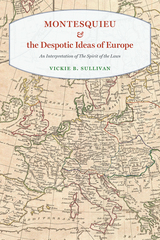 Montesquieu and the Despotic Ideas of Europe: An Interpretation of "The Spirit of the Laws"
Vickie B. Sullivan
University of Chicago Press, 2017 Montesquieu is rightly famous as a tireless critic of despotism, which he associates in his writings overtly with Asia and the Middle East and not with the apparently more moderate Western models of governance found throughout Europe. However, a careful reading of Montesquieu reveals that he recognizes a susceptibility to despotic practices in the West—and that the threat emanates not from the East, but from certain despotic ideas that inform such Western institutions as the French monarchy and the Roman Catholic Church.
Nowhere is Montesquieu’s critique of the despotic ideas of Europe more powerful than in his enormously influential The Spirit of the Laws, and Vickie B. Sullivan guides readers through Montesquieu’s sometimes veiled, yet sharply critical accounts of Machiavelli, Hobbes, Aristotle, and Plato, as well as various Christian thinkers. He finds deleterious consequences, for example, in brutal Machiavellianism, in Hobbes’s justifications for the rule of one, in Plato’s reasoning that denied slaves the right of natural defense, and in the Christian teachings that equated heresy with treason and informed the Inquisition.
In this new reading of Montesquieu’s masterwork, Sullivan corrects the misconception that it offers simple, objective observations, showing it instead to be a powerful critique of European politics that would become remarkably and regrettably prescient after Montesquieu’s death when despotism wound its way through Europe.
Montesquieu's Philosophy of Liberalism: A Commentary on The Spirit of the Laws
Thomas L. Pangle
University of Chicago Press, 1973 This first comprehensive commentary on The Spirit of the Laws uncovers and explicates the plan of Montesquieu's famous but baffling treatise. Pangle brings to light Montesquieu's rethinking of the philosophical groundwork of liberalism, showing how The Spirit of the Laws enlarges and enriches the liberal conception of natural right by means of a new appeal to History as the source of basic norms.
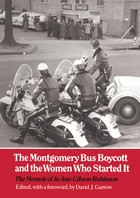 The Montgomery Bus Boycott and the Women Who Started It: The Memoir of Jo Ann Gibson Robinson
Jo Ann Gibson Robinson
University of Tennessee Press, 1987 Histories of the Montgomery Bus Boycott of 1955–1956 typically focus on Rose Parks, who refused to yield her bus seat to a White man, and on a young Martin Luther King Jr., who became the spokesman for the Black community organization set up to pursue a boycott of Montgomery's segregated city buses. In an important revision of the traditional account, this extraordinary personal memoir reveals an earlier and more important role played by a group of middle-class Black Montgomery women in creating the boycott.
As head of the Women's Political Council, the most active and assertive black civic organization in the City, Jo Ann Robinson was centrally involved in planning for a boycott far in advance and was able to immediately initiate it the evening Rosa Parks was arrested. Robinson also took part in crucial but ultimately unsuccessful negotiations with White officials both before and during the protest. Her proud, moving narrative vividly portrays her colleagues in the struggle, their strategies and decisions, and evokes the complex emotional currents in Montgomery during the boycott.
The Montgomery Bus Boycott ignited the civil rights movement and has always been vitally important in southern history and African American history. This seminal publication, named to Wall Street Journal's top ten list of books on the civil rights movement, has long been a milestone publication in understanding America's complicated racial history.
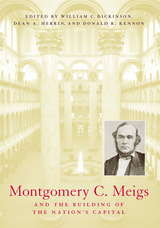 Montgomery C. Meigs and the Building of the Nation’s Capital
William C. Dickinson
Ohio University Press, 2001 At the age of thirty-six, in 1852, Lt. Montgomery Cunningham Meigs of the Army Corps of Engineers reported to Washington, D.C., for duty as a special assistant to the chief army engineer, Gen. Joseph G. Totten. It was a fateful assignment, both for the nation’s capital and for the bright, ambitious, and politically connected West Point graduate.
Meigs's forty-year tenure in the nation's capital was by any account spectacularly successful. He surveyed, designed, and built the Washington water supply system, oversaw the extension of the U.S. Capitol and the erection of its massive iron dome, and designed and supervised construction of the Pension Building, now the home of the National Building Museum. The skills he exhibited in supervising engineering projects were carefully noted by political leaders, including president-elect Abraham Lincoln, who named Meigs quartermaster general of the Union Army, the most important position he held during his long and active military career.
Meigs believed Washington, D.C., should be the reincarnation of Rome, the ancient capital of the Roman Empire. He endeavored to memorialize the story of the American nation in all the structures he built, expressing these ideas in murals, sculpture, and monumental design.
Historians have long known Meigs for the organizational genius with which he fulfilled his duty as quartermaster general during the Civil War and for his unwavering loyalty to Lincoln and Secretary of War Edwin Stanton. This volume establishes his claim as one of the major nineteenth-century contributors to the built environment of the nation's capital.
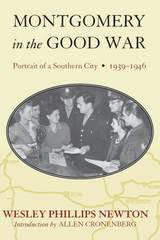 Montgomery in the Good War: Portrait of a Southern City, 1939-1946
Wesley Phillips Newton
University of Alabama Press, 2000 One city. One war. A story of transformation at home and abroad. Using newspaper accounts, interviews, letters, journals, and his own memory of the time, Wesley Newton reconstructs wartime-era Montgomery, Alabama--a sleepy southern capital that was transformed irreversibly during World War II. The war affected every segment of Montgomery society: black and white, rich and poor, male and female, those who fought in Europe and the Pacific and those who stayed on the home front. Newton follows Montgomerians chronologically through the war from Pearl Harbor to Hiroshima as they experience patriotism, draft and enlistment, rationing, scarcity drives, and the deaths of loved ones. His use of small vignettes based on personal recollections adds drama and poignancy to the story. Montgomery in the Good War is an important reminder that wars are waged at home as well as abroad and that their impact reverberates well beyond those who fight on the front lines. Those who came of age during the war will recognize themselves in this moving volume. It will also be enlightening to those who have lived in times of relative peace.
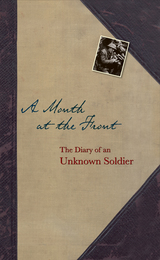 A Month at the Front: The Diary of an Unknown Soldier
Edited by the Bodleian Library
Bodleian Library Publishing, 2006 From The Things They Carried and Platoon to today’s documentaries of soldiers fighting in Iraq and Afghanistan, the ordeals of wartime soldiers are gripping, morally complex narratives of human strength and frailty. A Month at the Front offers another fresh and personal perspective on war. Recently acquired by the Bodleian Library, it is a first-hand account of a young and anonymous British soldier fighting in the frontline trenches of the First World War.
A Month at the Front chronicles one month in the life of a soldier from the 12th East Surrey regiment, and the economical yet powerful narrative vividly brings to life the sights, sounds, and horrors of war. “The first night passed uneventfully, except that we were shelled”—so begins the young man in spare prose, and the quiet drama unfolds from there. Constant bombings and the sobering landscape of war—“It was nothing unusual to come across . . . a dead comrade lying waiting for burial”—are occasionally relieved by humorous events such as the discovery that a troop of advancing Germans was “nothing more than few short willow shrubs waving about in the breeze.” The young soldier describes how his comrades gradually fall one by one, until he and three remaining fellow soldiers are captured by the enemy, an event that abruptly ends the narrative.
A Month at the Front is not penned by a famous author, nor does it claim to offer any broad perspective. Rather, it is the lone voice of an unknown young man thrust into fatal circumstances.
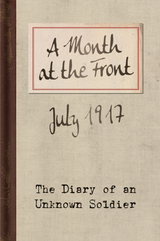 A Month at the Front: The Diary of an Unknown Soldier
Unknown Soldier
Bodleian Library Publishing, 2014 In July 1917, a young man in the 12th East Surrey Regiment kept a journal of his experiences at the front. This account is narrated with a keen sense of observation, bringing to life the sights, sounds, smells, and horrors of war. The anonymous author candidly describes his daily life: dodging shells to fetch meals from the rations cart; his regiment lost on a march, straying perilously near enemy lines; the selfishness of his commanding officer; the daily distribution of rum; the soar of shells above his head; communicating by sign language with a captured German soldier living in his trench; catching sleep in snatches of ten or fifteen minutes; and always, the endless mud. The young soldier describes how his comrades gradually fall one by one, until he and three remaining fellow soldiers are captured by the enemy, an event that abruptly ends the narrative.A Month at the Front offers a fresh and personal perspective on war. The manuscript, acquired by the Bodleian Library, is an authentic firsthand account from a young, anonymous soldier. It is a poignant and moving story of a young man thrust into fatal circumstances.
Montréal Chic: A Locational History of Montréal Fashion
Katrina Sark and Sara Danièle Bélanger-Michaud
Intellect Books, 2016 Montréal is à la mode. A fashionable city in its own right, it also boasts fashion schools, an industry packed with local designers and manufacturers, and a dynamic scene that exhibits local and international collections. With its vibrant cultural life and affordable cost of living, designers and artists flock from all over to be a part of Montréal’s hip fashion community. MontréalChic is the first book to document this scene and how it connects with the city’s design, film, music, and cultural history. Scholars Katrina Sark and Sara Danièle Bélanger-Michaud are intimately acquainted with Montréal and use their firsthand knowledge of the city’s fashion to explore urban culture, music, institutions, scenes, and subcultures, along the way uncovering many untold stories of Montréal’s fashion scene.
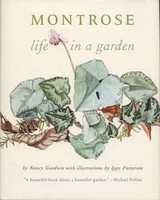 Montrose: Life in a Garden
Nancy Goodwin
Duke University Press, 2005 Something is blooming every day of the year in the renowned gardens at Montrose, Nancy Goodwin’s nineteenth-century property in historic Hillsborough, North Carolina. Since moving to Montrose with her husband Craufurd in 1977, Goodwin has transformed more than twenty acres into an extraordinary complex of interlocking gardens that come in and out of focus as the seasons overlap and change. Beautifully written and illustrated, Montrose: Life in a Garden is Goodwin’s affectionate biography of her gardens, recounting how and why each section was developed over the years, including the Dianthus Walk, Nandinaland, Hellebore Slope, Mother-in-Law Walk, Snowdrop Woods, and Jo’s Bed. It is also a meticulous month-by-month chronicle of a specific year in these gardens—a year that saw a punishing drought that threatened Goodwin’s no-irrigation policy, a damaging December ice storm, and the beginnings of a plan to preserve Montrose in the future. Working on her knees for long days throughout the year, Nancy Goodwin always has a vision of how her gardens will appear in twelve months or in twelve years. She will spend weeks, for instance, planting hundreds of snow drops along a woodsy path in order to enjoy a fleeting week of exquisite beauty in coming years. She never puts anything into the ground without imagining what form, color, and texture it will add to a bed. With tireless patience and unflagging optimism, Goodwin will wait years to see a single plant bloom. Following Goodwin’s activities throughout the year, readers will learn the fundamentals of maintaining a four-season garden in Zone 7 in the South. Award-winning garden illustrator Ippy Patterson has provided more than 160 lavish illustrations of the gardens at Montrose and these meticulously detailed drawings appear throughout the book.
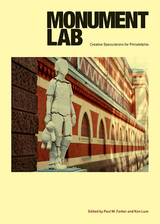 Monument Lab: Creative Speculations for Philadelphia
Paul M. Farber
Temple University Press, 2020 What is an appropriate monument for the current city of Philadelphia? That was the question posed by the curators, artists, scholars, and students who comprise the Philadelphia-based public art and history studio Monument Lab. And in 2017, along with Mural Arts Philadelphia, they produced and organized a groundbreaking, city-wide exhibition of temporary, site-specific works that engaged directly with the community. The installations, by a cohort of diverse artists considering issues of identity, appeared in iconic public squares and neighborhood parks with research and learning labs and prototype monuments. Monument Lab is a fabulous compendium of the exhibition and a critical reflection of the proceedings, including contributions from interlocutors and collaborators. The exhibition and this handbook were designed to generate new ways of thinking about monuments and public art as well as to find new, critical perspectives to reflect on the monuments we have inherited and to imagine those we have yet to build. Monument Lab energizes acivic dialogue about place and history as forces for a deeper questioning of what it means to be Philadelphian in a time of renewal and continuing struggle.
Contributors: Alexander Alberro, Alliyah Allen, Laurie Allen, Andrew Friedman, Justin Geller, Kristen Giannantonio, Jane Golden, Aviva Kapust, Fariah Khan, Homay King, Stephanie Mach, Trapeta B. Mayson, Nathaniel Popkin, Ursula Rucker, Jodi Throckmorton, Salamishah Tillet, Jennifer Harford Vargas, Naomi Waltham-Smith, Bethany Wiggin, Mariam I. Williams, Leslie Willis-Lowry, and the editors.
Artists: Tania Bruguera, Mel Chin, Kara Crombie, Tyree Guyton, Hans Haacke, David Hartt, Sharon Hayes, King Britt and Joshua Mays, Klip Collective, Duane Linklater, Emeka Ogboh, Karyn Olivier, Michelle Angela Ortiz, Kaitlin Pomerantz, RAIR, Alexander Rosenberg, Jamel Shabazz, Hank Willis Thomas, Shira Walinsky and Southeast by Southeast, and Marisa Williamson.
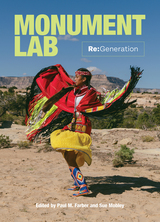 Monument Lab: Re:Generation
Edited by Paul M. Farber and Sue Mobley
Temple University Press, 2026 Beginning in 2022, the Philadelphia-based nonprofit public art, history, and design studio, Monument Lab, launched a nationwide initiative organized around a central question: Which stories belong in public? The editors and contributors to Monument Lab: Re:Generation responded with creative and impactful projects of reclamation that provide a deeper understanding of how monuments live and function in communities.
Monument Lab: Re:Generation presents case studies that travel across America, highlighting local commemorative campaigns dedicated to advancing public memory. Featuring articles and artwork from the country’s leading monument makers, each project includes a framing essay that provides insights into the varied contexts of location, culture, form, and subject matter.
Monument Lab: Re:Generation provides innovative, healing, and practical approaches to the United States’ unreconciled past and divided present facing our nation. In doing so, it invites readers to engage with a broader discourse of monuments and public memory.
Contributors: Thomas J. Adams, Kareal Amenumey, Sháńdíín Brown, Jonathan Jae-an Crisman, Kristen Dorsey, Aruna D'Souza, Mariluz Franco Ortiz, Jacqui Germain, Grace Sanders Johnson, Dani R. Merriman, Deirdre Cooper Owens, Naima Murphy Salcido, Kirk Savage, Clint Smith, Tsione Wolde-Michael, Eric Zimmer, and the editors
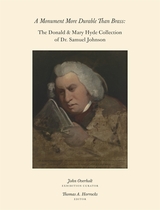 A Monument More Durable than Brass: Donald & Mary Hyde Collection of Dr. Samuel Johnson
John Overholt
Harvard University Press To commemorate the tercentenary of the birth of Samuel Johnson (1709–1784), whose influence on his time was as monumental as his legacy is enduring, Harvard University’s Houghton Library presents this exhibition catalogue of items drawn from the Donald & Mary Hyde Collection of Dr. Samuel Johnson, bequeathed to the library in 2004 by Mary Hyde Eccles. This copiously illustrated catalogue documents sixty years of assiduous and painstaking effort on the part of Lady Eccles, initially in collaboration with her first husband, Donald F. Hyde, and later with the encouragement and support of her second husband, David, Viscount Eccles, to assemble one of the world’s finest collections of eighteenth-century English literature. The catalogue, including essays on Johnson’s literary durability and on Donald and Mary Hyde’s life as collectors, pays tribute to a great literary icon and to a remarkably generous woman who devoted her life to collecting an astonishing array of books, manuscripts, prints, and other rare artifacts relating to his life and times.
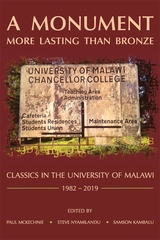 A Monument More Lasting than Bronze: Classics in the University of Malawi, 1982–2019
Paul McKechnie
Harvard University Press, 2023 Formed in 1964, the year of independence, the University of Malawi promised more than the distant University College of Rhodesia and Nyasaland—founded 1952—ever could. A decade and a half later, Hastings Kamuzu Banda, by then Life President of the Republic of Malawi, let it be known to the University that a Department of Classics was to be established—teaching the history and languages of the ancient Mediterranean world at Zomba, on the edge of the African Rift Valley.
A Monument More Lasting than Bronze analyzes President Banda’s motives for this surreal intervention and the political goals it served, and also sketches out the shape the enterprise he called into being has taken—all in the context of worldwide transformations of Classics. A balanced team of authors, some Malawian, some foreign with Malawian connections, brings varied perspectives to this reflection.
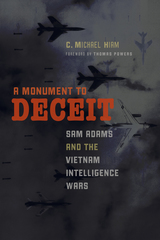 A Monument to Deceit: Sam Adams and the Vietnam Intelligence Wars
C. Michael Hiam
University Press of New England, 2014 It was an enigma of the Vietnam War: American troops kept killing the Viet Cong—and being killed in the process—and yet their ranks continued to grow. When CIA analyst Sam Adams uncovered documents suggesting a Viet Cong army more than twice as large as previously reckoned, another war erupted, this time within the ranks of America’s intelligence community. Although originally clandestine, this conflict involving the highest levels of the U.S. government burst into public view during the acrimonious lawsuit Westmoreland v. CBS. The central issue in the suit, as in the war itself, was the calamitous failure of U.S. intelligence agencies to ascertain the strength of the Viet Cong and get that information to troops in a timely fashion. The legacy of this failure—whether caused by institutional inertia, misguided politics, or individual hubris—haunts our nation. In the era of Chelsea Manning, Julian Assange, and Edward Snowden, Sam Adams’ tireless crusade for “honest intelligence” resonates strongly today.
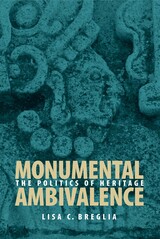 Monumental Ambivalence: The Politics of Heritage
By Lisa C. Breglia
University of Texas Press, 2006 From ancient Maya cities in Mexico and Central America to the Taj Mahal in India, cultural heritage sites around the world are being drawn into the wave of privatization that has already swept through such economic sectors as telecommunications, transportation, and utilities. As nation-states decide they can no longer afford to maintain cultural properties—or find it economically advantageous not to do so in the globalizing economy—private actors are stepping in to excavate, conserve, interpret, and represent archaeological and historical sites. But what are the ramifications when a multinational corporation, or even an indigenous village, owns a piece of national patrimony which holds cultural and perhaps sacred meaning for all the country's people, as well as for visitors from the rest of the world? In this ambitious book, Lisa Breglia investigates "heritage" as an arena in which a variety of private and public actors compete for the right to benefit, economically and otherwise, from controlling cultural patrimony. She presents ethnographic case studies of two archaeological sites in the Yucatán Peninsula—Chichén Itzá and Chunchucmil and their surrounding modern communities—to demonstrate how indigenous landholders, foreign archaeologists, and the Mexican state use heritage properties to position themselves as legitimate "heirs" and beneficiaries of Mexican national patrimony. Breglia's research masterfully describes the "monumental ambivalence" that results when local residents, excavation laborers, site managers, and state agencies all enact their claims to cultural patrimony. Her findings make it clear that informal and partial privatizations—which go on quietly and continually—are as real a threat to a nation's heritage as the prospect of fast-food restaurants and shopping centers in the ruins of a sacred site.
 The Monumental Andes: Geology, Geography, and Ancient Cultures in the Peruvian Andes
Roseanne Chambers
University of Utah Press, 2024 When geologist Roseanne Chambers made her first visit to Machu Picchu in 2006, it sparked a deep fascination with the geology and culture of the Peruvian Andes. Amid the plethora of information available about the Andes Mountains, as well as the Incas and their ancestors, she was unable to find a book that specifically traced the geologic history of that landscape and how this history shaped ancient Andean societies. Consequently, she decided to write that book herself.
At once approachable and informative, The Monumental Andes tells the history of the lofty mountains and civilizations that characterize the Central Andes. The book explores many interconnected aspects of ancient Andean life, including climate, topography, agricultural methods, natural hazards, the construction of monumental structures, the creation of sophisticated art objects, and the plant-based hallucinogens and narcotics used in religious rituals. From earthquake-resistant structures to shrines on the tops of active volcanoes, ancient Andeans left behind relics that amaze and inspire today.
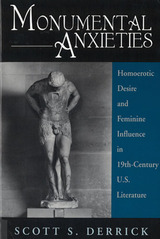 Monumental Anxieties: Homoerotic Desire and Feminine Influence in 19-th Century U.S. Literature
Derrick, Scott S
Rutgers University Press, 1997 Scott Derrick has written an original book that contributes significantly to current revisions of the nineteenth-century American literary tradition's representation of gender and sexuality. His interpretation of feminist, lesbian-feminist, and gay issues in nineteenth-century American literature as complementary enlarges our historical understanding and helps build the coalition politics needed in these areas."-John Carlos Rowe, University of California, Irvine Recent gender-based scholarship on nineteenth-century American literature has established male authors' crucial awareness of the competition from popular women writers. And critical work in gay studies and queer theory has stressed the importance in canonical American literature of homoerotic relations between men, even before "homosexuality" became codified at the end of the century. Scott Derrick draws on these insights to explore the ways in which male authors struggle to refigure literature-historically devalued as feminine-as a masculine and heterosexual enterprise. Derrick focuses on scenes of compositional crisis that reveal how male identity itself is at risk in the perils and possibilities of being a male author in a feminized literary marketplace. He suggests that traditionally valued texts by Hawthorne, Poe, James, Sinclair, and Crane have at their core combustible four-sided conflicts between feminine identifications and masculine distancings, homoerotic longings and homophobic dreads, conflicts which are largely determined by domestic ideals of male and female roles within the nineteenth-century family. The negotiation of such conflicts is controlled by the nature of fiction writing, which both frees the imagination to explore forbidden fantasies and harnesses the imagination to public understandings of the proper form and content of fiction. Thus Monumental Anxieties also contributes to recent debates about the social shaping of contemporary homosexuality and to the history of American masculinity.
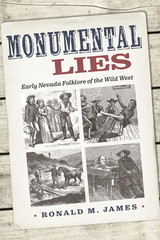 Monumental Lies: Early Nevada Folklore of the Wild West
Ronald M. James
University of Nevada Press, 2023 A playful embrace of tall tales and exaggeration, Monumental Lies explores the evolution of folklore in the Wild West.
Monumental Lies: Early Nevada Folklore of the Wild West opens the door to understanding how legends and traditions emerged during the first decades following the “Rush to Washoe,” which transformed the region beginning in 1859. During this Wild West period, there was widespread celebration of deceit, manifesting in tall tales, burlesque lies, practical jokes, and journalistic hoaxes. Humor was central to these endeavors and practitioners easily found themselves scorned if they failed to be adequately funny. This ethos became central to the way folklore emerged during the formative years of the Nevada territory and state.
The tens of thousands of people who came to the West, attracted by gold and silver mining, brought distinct cultural legacies. The interaction of diverse perspectives, even while new stories and traditions coalesced or simply appeared, was a complex process. Author Ronald M. James addresses how the fluidity of the region affected new expressions of folklore as they took root.
Mark Twain, often a go-to source for collections of early tall tales of this region, cannot be overlooked, but his interaction with local traditions was specific and narrow. More importantly, William Wright—publishing as Dan De Quille—arose as a key collector of legends, a counterpart of early European folklorists. With a bedrock understanding of what unfolded in the nineteenth century, it is possible to consider
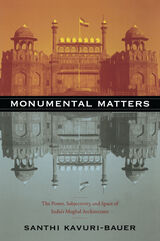 Monumental Matters: The Power, Subjectivity, and Space of India's Mughal Architecture
Santhi Kavuri-Bauer
Duke University Press, 2011 Built in the sixteenth and seventeenth centuries, India’s Mughal monuments—including majestic forts, mosques, palaces, and tombs, such as the Taj Mahal—are world renowned for their grandeur and association with the Mughals, the powerful Islamic empire that once ruled most of the subcontinent. In Monumental Matters, Santhi Kavuri-Bauer focuses on the prominent role of Mughal architecture in the construction and contestation of the Indian national landscape.
She examines the representation and eventual preservation of the monuments, from their disrepair in the colonial past to their present status as protected heritage sites. Drawing on theories of power, subjectivity, and space, Kavuri-Bauer’s interdisciplinary analysis encompasses Urdu poetry, British landscape painting, imperial archaeological surveys, Indian Muslim identity, and British tourism, as well as postcolonial nation building, World Heritage designations, and conservation mandates. Since Independence, the state has attempted to construct a narrative of Mughal monuments as symbols of a unified, secular nation. Yet modern-day sectarian violence at these sites continues to suggest that India’s Mughal monuments remain the transformative spaces—of social ordering, identity formation, and national reinvention—that they have been for centuries.
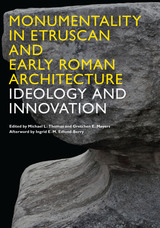 Monumentality in Etruscan and Early Roman Architecture: Ideology and Innovation
Edited by Michael L. Thomas and Gretchen E. Meyers
University of Texas Press, 2012 Every society builds, and many, if not all, utilize architectural structures as markers to define place, patron, or experience. Often we consider these architectural markers as “monuments” or “monumental” buildings. Ancient Rome, in particular, is a society recognized for the monumentality of its buildings. While few would deny that the term “monumental” is appropriate for ancient Roman architecture, the nature of this characterization and its development in pre-Roman Italy is rarely considered carefully. What is “monumental” about Etruscan and early Roman architecture? Delving into the crucial period before the zenith of Imperial Roman building, Monumentality in Etruscan and Early Roman Architecture addresses such questions as, “What factors drove the emergence of scale as a defining element of ancient Italian architecture?” and “How did monumentality arise as a key feature of Roman architecture?” Contributors Elizabeth Colantoni, Anthony Tuck, Nancy A. Winter, P. Gregory Warden, John N. Hopkins, Penelope J. E. Davies, and Ingrid Edlund-Berry reflect on the ways in which ancient Etruscans and Romans utilized the concepts of commemoration, durability, and visibility to achieve monumentality. The editors’ preface and introduction underscore the notion of architectural evolution toward monumentality as being connected to the changing social and political strategies of the ruling elites. By also considering technical components, this collection emphasizes the development and the ideological significance of Etruscan and early Roman monumentality from a variety of viewpoints and disciplines. The result is a broad range of interpretations celebrating both ancient and modern perspectives.
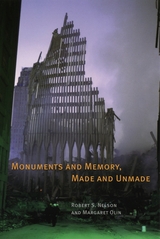 Monuments and Memory, Made and Unmade
Edited by Robert S. Nelson and Margaret Olin
University of Chicago Press, 2003 How do some monuments become so socially powerful that people seek to destroy them? After ignoring monuments for years, why must we now commemorate public trauma, but not triumph, with a monument? To explore these and other questions, Robert S. Nelson and Margaret Olin assembled essays from leading scholars about how monuments have functioned throughout the world and how globalization has challenged Western notions of the "monument."
Examining how monuments preserve memory, these essays demonstrate how phenomena as diverse as ancient drum towers in China and ritual whale-killings in the Pacific Northwest serve to represent and negotiate time. Connecting that history to the present with an epilogue on the World Trade Center, Monuments and Memory, Made and Unmade is pertinent not only for art historians but for anyone interested in the turbulent history of monuments—a history that is still very much with us today.
Contributors:
Stephen Bann, Jonathan Bordo, Julia Bryan-Wilson, Jas Elsner, Tapati Guha-Thakurta, Robert S. Nelson, Margaret Olin, Ruth B. Phillips, Mitchell Schwarzer, Lillian Lan-ying Tseng, Richard Wittman, Wu Hung
 Monuments and Territory: War Memorials in Russian-Occupied Ukraine
Mischa Gabowitsch
Central European University Press, 2025 From the very first weeks of Russia’s large-scale attack on Ukraine in February 2022, Russian soldiers, politicians, and proxy administrators expended considerable effort interacting with monuments on newly occupied territory. Why did the invaders care enough about war memorials to divert scarce resources to destroying, maintaining, or building them amid a massive war? Why did they remove some memorials and spare others? What was the point of commemorating past victories and defeats while bombing Ukrainian cities, and how did commemorative ceremonies in the occupied territories change over the first year of the war? What was the broader impact of monument-related practices beyond the local settings in which they occurred? And what does the Ukrainian case teach us more generally about how memorials to past wars can be used to justify new conquests? These are some of the questions this book explores, based on fieldwork in occupied Ukraine and online research.
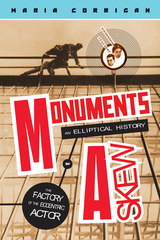 Monuments Askew: An Elliptical History of the Factory of the Eccentric Actor
Maria Corrigan
Rutgers University Press, 2025 Monuments Askew: An Elliptical History of the Factory of the Eccentric Actor presents a cultural history of the Factory of the Eccentric Actor (FEKS), an avant-garde collective of Ukrainian artists whose unique approach to monumental history generated a new kind of cinema for a modernizing Soviet era. Often lost in the shuffle of this period, FEKS’s vibrant and experimental cinematic output initiated a youthful and cheeky overhaul of Soviet revolutionary culture. Monuments Askew reveals the foundational role of this understudied group of artists—including Grigori Kozintsev and Leonid Trauberg—and uses their own theoretical contributions to undo the “foundations” of our understanding of Soviet media and arts. As a counter to a solely cinema-focused conceptualization of this era, Corrigan develops a transnational media theory of eccentricity. Defining eccentric circles as warped, irregular orbits that force a realignment of centers, Monuments Askew shows how FEKS’s body of work inspires an eccentric realignment of the pillars of Soviet visual culture, and indeed of monumentality itself.
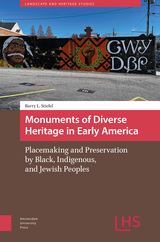 Monuments of Diverse Heritage in Early America: Placemaking and Preservation by Black, Indigenous, and Jewish Peoples
Barry L. Stiefel
Amsterdam University Press, 2025 Monuments of Diverse Heritage in Early America: Placemaking and Preservation by Black, Indigenous, and Jewish Peoples explores a more inclusive history of preserving public historic sites. At a time when some Americans have embraced white nationalism in response to unfolding demographic changes and others celebrate individual identities over all else, an inclusive, tolerant, and unifying historical vision is sorely needed. While past preservation efforts sometimes resulted in exclusionary forms of historical inspiration, that need not be the case in the future. Bringing greater attention to the diverse heritage of the United States will not only help dismantle the lingering remnants of exclusionary and elitist narratives but also celebrate a pluralistic and diverse past and present. An inclusive, empowering history can provide social cohesion while allowing room for individual groups to have authority over their pasts and representation in public, side-by-side with one another.
Monuments of Romanesque Art: The Art of the Church Treasures in Northwestern Europe
Hanns Swarzenski
University of Chicago Press, 1974 This beautiflly illustrated book presents as an artistic whole the chief monuments in ivory, gold, bronze, enamel, and manuscript illumination of north-west Europe from A.D. 800 to 1200. Hanns Swarzenski has selected more than 560 illustrations to exemplify the continuity of artistic development irrespective of the materials in which individual works are executed or the local schools to which they belong. These illustrations offer a splendid presentation of Romanesque art—the most extensive ever brought together between the covers of one book.
 Monuments to Faith: Ukrainian Churches in Manitoba
Basil Rotoff
University of Manitoba Press, 1990 Ukrainians first came to Canada a century ago, seeking a new life on the western prairies. They brought with them an ancient and rich cultural tradition, deeply rooted in Christianity. The most visible symbol of this tradition is the Ukrainian church with its distinctive cupolas. As soon as the settlers were established in the new land, they began to reshape their environment by building churches in the styles they remembered from their homeland.In this richly illustrated volume, the authors trace the continuity of tradition in achitecture, art, and community life from Ukraine to the parishes of the Manitoba prairie. In a detailed examination of the exteriors and interiors of forty-nine churches, the book establishes a typology of Ukrainian church designs. Biographies of the architects, master builders, and artists are included, along with a guide to the art and architecture of a Ukrainian church.
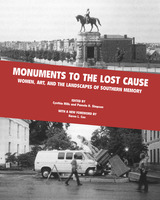 Monuments to the Lost Cause: Women, Art, And The Landscapes Of Southern Memory
Cynthia Mills
University of Tennessee Press, 2003 This richly illustrated collection of essays, reissued in paperback with a new foreword by Karen L. Cox, examines Confederate memorials from Monument Avenue to Stone Mountain and explores how each monument, with its associated public rituals, testifies to the romanticized narrative of the American Civil War known as the Lost Cause. Several of the fourteen essays highlight the creative leading role played by women’s groups in memorialization, while others explore the alternative ways in which people outside white southern culture wrote their very different histories on the southern landscape. The contributors – who include Karen L. Cox, Richard Guy Wilson, Catherine W. Bishir, W. Fitzhugh Brundage, and William M.S. Ramussen – trace the origins, objectives, and changing consequences of Confederate monuments over time and the dynamics of individuals and organizations that sponsored them. Thus these essays extend the growing literature on the rhetoric of the Lost Cause by shifting the focus to the realm of the visual. They are especially relevant in the present day when Confederate symbols and monuments continue to play a central role in a public – and often emotionally charged – debate about how the South’s past should be remembered.
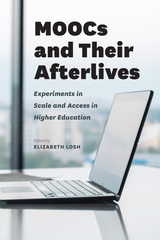 MOOCs and Their Afterlives: Experiments in Scale and Access in Higher Education
Edited by Elizabeth Losh
University of Chicago Press, 2017 A trio of headlines in the Chronicle of Higher Education seem to say it all: in 2013, “A Bold Move Toward MOOCs Sends Shock Waves;” in 2014, “Doubts About MOOCs Continue to Rise,” and in 2015, “The MOOC Hype Fades.” At the beginning of the 2010s, MOOCs, or Massive Open Online Courses, seemed poised to completely revolutionize higher education. But now, just a few years into the revolution, educators’ enthusiasm seems to have cooled. As advocates and critics try to make sense of the rise and fall of these courses, both groups are united by one question: Where do we go from here?
Elizabeth Losh has gathered experts from across disciplines—education, rhetoric, philosophy, literary studies, history, computer science, and journalism—to tease out lessons and chart a course into the future of open, online education. Instructors talk about what worked and what didn’t. Students share their experiences as participants. And scholars consider the ethics of this education. The collection goes beyond MOOCs to cover variants such as hybrid or blended courses, SPOCs (Small Personalized Online Courses), and DOCCs (Distributed Open Collaborative Course). Together, these essays provide a unique, even-handed look at the MOOC movement and will serve as a thoughtful guide to those shaping the next steps for open education.
MOOCs: What Every ESL Teacher Needs to Know
Pamela S.H. Bogart
University of Michigan Press, 2019 Pamela Bogart, an instructor at the University of Michigan's English Language Institute, explains the ins and outs of massive open online courses (MOOCs), particularly those that can support language learning. The author begins by describing what a MOOC is; she then identifies the various types of MOOCs and their pedagogical benefits and shows how MOOCs can aid in the language learning process and offer students a more richly textured blended learning experience. The text concludes with tips for creating and designing a MOOC. Each section includes an Exploration Task that invites readers to deepen their personal understanding of and experience with MOOCs.
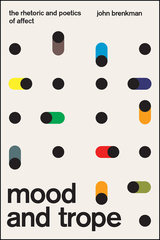 Mood and Trope: The Rhetoric and Poetics of Affect
John Brenkman
University of Chicago Press, 2020 In Mood and Trope, John Brenkman introduces two provocative propositions to affect theory: that human emotion is intimately connected to persuasion and figurative language; and that literature, especially poetry, lends precision to studying affect because it resides there not in speaking about feelings, but in the way of speaking itself.
Engaging a quartet of modern philosophers—Kant, Nietzsche, Heidegger, and Deleuze—Brenkman explores how they all approach the question of affect primarily through literature and art. He draws on the differences and dialogues among them, arguing that the vocation of criticism is incapable of systematicity and instead must be attuned to the singularity and plurality of literary and artistic creations. In addition, he confronts these four philosophers and their essential concepts with a wide array of authors and artists, including Pinter and Poe, Baudelaire, Jorie Graham and Li-Young Lee, Shakespeare, Tino Sehgal, and Francis Bacon. Filled with surprising insights, Mood and Trope provides a rich archive for rethinking the nature of affect and its aesthetic and rhetorical stakes.
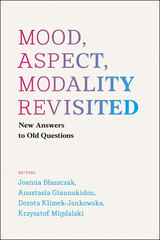 Mood, Aspect, Modality Revisited: New Answers to Old Questions
Edited by Joanna Blaszczak, Anastasia Giannakidou, Dorota Klimek-Jankowska, and Krzysztof Migdalski
University of Chicago Press, 2016 Over the past several decades, linguistic theorizing of tense, aspect, and mood (TAM), along with a strongly growing body of crosslinguistic studies, has revealed complexity in the data that challenges traditional distinctions and treatments of these categories. Mood, Aspect, Modality Revisited argues that it’s time to revisit our conventional assumptions and reconsider our foundational questions: What exactly is a linguistic category? What kinds of categories do labels such as “subjunctive,” “imperative,” “future,” and “modality” truly refer to? In short, how categorical are categories?
Current literature assumes a straightforward link between grammatical category and semantic function, and descriptions of well-studied languages have cultivated a sense of predictability in patterns over time. As the editors and contributors of Mood, Aspect, Modality Revisited prove, however, this predictability and stability vanish in the study of lesser-known patterns and languages. The ten provocative essays gathered here present fascinating cutting-edge research demonstrating that the traditional grammatical distinctions are ultimately fluid—and perhaps even illusory. Developing groundbreaking and highly original theories, the contributors in this volume seek to unravel more general, fundamental principles of TAM that can help us better understand the nature of linguistic representations.
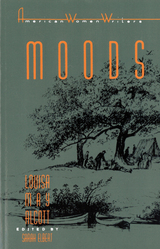 Moods
Elbert, Sarah
Rutgers University Press, 1991 Moods, Louisa May Alcott's first novel was published in 1864, four years before the best-selling Little Women. The novel unconventionally presents a "little woman," a true-hearted abolitionist spinster, and a fallen Cuban beauty, their lives intersecting in Alcott's first major depiction of the "woman problem." Sylvia Yule, the heroine of Moods, is a passionate tomboy who yearns for adventure. The novel opens as she embarks on a river camping trip with her brother and his two friends, both of whom fall in love with her. These rival suitors, close friends, are modeled on Ralph Waldo Emerson and Henry Daniel Thoreau. Aroused, but still "moody" and inexperienced, Sylvia marries the wrong man. In the rest of the novel, Alcott attempts to resolve the dilemma she has created and leave her readers asking whether, in fact, there is a place for a woman such as Sylvia in a man's world. In 1882, eighteen years after the original publication, Alcott revised and republished the novel. Her own literary success and the changes she helped forge in women's lives now allowed her heroine to meet, as Alcott said, "a wiser if less romantic fate than in the former edition." This new volume contains the complete text of the 1864 Moods and Alcott's revisions for the 1882 version, along with explanatory notes by the editor. A critical introduction places Moods in the context of Alcott's own literary history and in the larger historical setting of nineteenth-century society and culture.
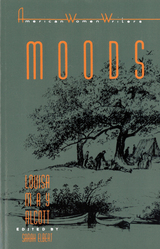 Moods by Louisa May Alcott
Elbert, Sarah
Rutgers University Press, 1991 Moods, Louisa May Alcott's first novel was published in 1864, four years before the best-selling Little Women. The novel unconventionally presents a "little woman," a true-hearted abolitionist spinster, and a fallen Cuban beauty, their lives intersecting in Alcott's first major depiction of the "woman problem." Sylvia Yule, the heroine of Moods, is a passionate tomboy who yearns for adventure. The novel opens as she embarks on a river camping trip with her brother and his two friends, both of whom fall in love with her. These rival suitors, close friends, are modeled on Ralph Waldo Emerson and Henry Daniel Thoreau. Aroused, but still "moody" and inexperienced, Sylvia marries the wrong man. In the rest of the novel, Alcott attempts to resolve the dilemma she has created and leave her readers asking whether, in fact, there is a place for a woman such as Sylvia in a man's world. In 1882, eighteen years after the original publication, Alcott revised and republished the novel. Her own literary success and the changes she helped forge in women's lives now allowed her heroine to meet, as Alcott said, "a wiser if less romantic fate than in the former edition." This new volume contains the complete text of the 1864 Moods and Alcott's revisions for the 1882 version, along with explanatory notes by the editor. A critical introduction places Moods in the context of Alcott's own literary history and in the larger historical setting of nineteenth-century society and culture.
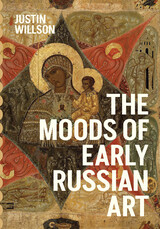 The Moods of Early Russian Art
Justin Willson
University of Chicago Press An examination of the values and debates that shaped early East Slavic art.
The Moods of Early Russian Art describes an alternative early modernity at the easternmost border of the European cultural sphere, where the Renaissance marked a return not to secular humanism but to the religiosity and art of the Middle Ages. Charting a kind of “Renaissance in reverse,” art historian Justin Willson explores how the value placed on style and virtuosity faded in importance as the Church cultivated miracle-working images during the reigns of Ivan the Great and Ivan the Terrible. Arguing for a broader unity of interests among artistic workshops across the Muscovite landscape—a system of interconnected values that he explains using the language of “moods”—Willson examines icons, illuminated manuscripts, enamelwork, and murals, tracing how the interpretive framework of the age shifted from the “aesthetic” and “literal” moods to the “intoxicated” and “romantic” over the fifteenth and sixteenth centuries.
Moon and Henna Tree
By Ahmed Toufiq
University of Texas Press, 2013 Set in the High Atlas in pre-modern Morocco, Moon and Henna Tree chronicles the rise and fall of a local potentate, Hmmu. Not content with the territory left to him upon his father’s death, Hmmu, under the influence of his scheming advisor, Ibn al-Zara, begins a campaign to acquire those lands that adjoin his, either through marriage or physical force. Ahmed Toufiq’s subtle investigation of the abuse of power and its effects on those who suffer under its tyranny also provides a unique look at Amazigh (Berber) culture. While most of Toufiq’s contemporaries focus on modern urban Morocco, he provides a fascinating, and accurate, account of the customs and traditions of a large, yet often ignored, segment of the population. Moon and Henna Tree (in the original Arabic) won the Moroccan Book Prize in 1989.
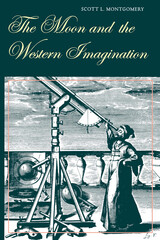 The Moon and the Western Imagination
Scott L. Montgomery
University of Arizona Press, 1999 The Moon is at once a face with a thousand expressions and the archetypal planet. Throughout history it has been gazed upon by people of every culture in every walk of life. From early perceptions of the Moon as an abode of divine forces, humanity has in turn accepted the mathematized Moon of the Greeks, the naturalistic lunar portrait of Jan van Eyck, and the telescopic view of Galileo.
Scott Montgomery has produced a richly detailed analysis of how the Moon has been visualized in Western culture through the ages, revealing the faces it has presented to philosophers, writers, artists, and scientists for nearly three millennia. To do this, he has drawn on a wide array of sources that illustrate mankind's changing concept of the nature and significance of heavenly bodies from classical antiquity to the dawn of modern science.
Montgomery especially focuses on the seventeenth century, when the Moon was first mapped and its features named. From literary explorations such as Francis Godwin's Man in the Moone and Cyrano de Bergerac's L'autre monde to Michael Van Langren's textual lunar map and Giambattista Riccioli's Almagestum novum, he shows how Renaissance man was moved by the lunar orb, how he battled to claim its surface, and how he in turn elevated the Moon to a new level in human awareness. The effect on human imagination has been cumulative: our idea of the Moon, and therefore the planets, is multilayered and complex, having been enriched by associations played out in increasingly complicated harmonies over time. We have shifted the way we think about the lunar face from a "perfect" body to an earthlike one, with corresponding changes in verbal and visual expression.
Ultimately, Montgomery suggests, our concept of the Moon has never wandered too far from the world we know best—the Earth itself. And when we finally establish lunar bases and take up some form of residence on the Moon's surface, we will not be conquering a New World, fresh and mostly unknown, but a much older one, ripe with history.
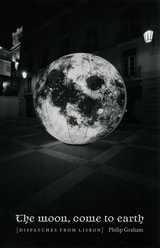 The Moon, Come to Earth: Dispatches from Lisbon
Philip Graham
University of Chicago Press, 2009 A dispatch from a foreign land, when crafted by an attentive and skilled writer, can be magical, transmitting pleasure, drama, and seductive strangeness.
In The Moon, Come to Earth, Philip Graham offers an expanded edition of a popular series of dispatches originally published on McSweeney’s, an exuberant yet introspective account of a year’s sojourn in Lisbon with his wife and daughter. Casting his attentive gaze on scenes as broad as a citywide arts festival and as small as a single paving stone in a cobbled walk, Graham renders Lisbon from a perspective that varies between wide-eyed and knowing; though he’s unquestionably not a tourist, at the same time he knows he will never be a local. So his lyrical accounts reveal his struggles with (and love of) the Portuguese language, an awkward meeting with Nobel laureate José Saramago, being trapped in a budding soccer riot, and his daughter’s challenging transition to adolescence while attending a Portuguese school—but he also waxes loving about Portugal’s saudade-drenched music, its inventive cuisine, and its vibrant literary culture. And through his humorous, self-deprecating, and wistful explorations, we come to know Graham himself, and his wife and daughter, so that when an unexpected crisis hits his family, we can’t help but ache alongside them.
A thoughtful, finely wrought celebration of the moment-to-moment excitement of diving deep into another culture and confronting one’s secret selves, The Moon, Come to Earth is literary travel writing of a rare intimacy and immediacy.
 The Moon in Foil
Zuska Kepplová
Seagull Books, 2023 A glimpse into the world of young people, modern nomads, roving in search of a new and promising life.
The Moon in Foil traces the stories of Petra, Natália, Anka, Mika, Juliana, and Jackie as they go out into the world in search of a better life—or maybe just a different one. In post-communist Europe, they have the freedom to study and work in places their parents couldn’t even have visited—Paris, London, Helsinki, and Budapest. But the reality of that “freedom,” they soon discover, is often nothing more than tedious work and poor living conditions. From close looks at the work of a housekeeper at a French hotel, a bartender at an Irish pub, a snowboarding instructor in Slovakia in the winter and an office worker in London in the summer, and a programmer in Helsinki, to explorations of larger topics such as marriage, divorce, and relationships, Zuska Kepplová’s novel is a millennials’ odyssey—a search for the self by the post–Cold War generation.
 The Moon in the Water: Reflections on an Aging Parent
Kathy J. Phillips
Vanderbilt University Press, 2008 Named a Best Book of 2008 by Library Journal In a series of moving vignettes, the author begins by describing a particular representation of Water-Moon Kuan Yin, a Buddhist teacher and goddess associated with compassion, who often sits on a precarious overhang or floats on a flimsy petal. Then Kuan Yin steps out of the frame to join the author in the mundane challenges of caring for her father-transferring his health insurance, struggling with a wheelchair van, managing adult diapers, or playing in the fictions of dementia. From perplexed to poignant to funny, the vignettes record the working-class English of a fading but still wise dad, and they find other human versions of Kuan Yin in a doctor who will still make house calls or kind strangers in the street. The book includes ten illustrations: both classical representations of Kuan Yin and also the author's own drawings, which adapt Kuan Yin in an act of practical spirituality, reading art through life and life through art. Each vignette invites the harried caregiver to take a deep breath and meditate on the trials and joys of caring for an aging parent.
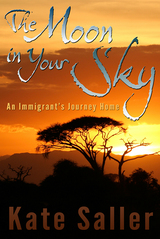 The Moon in Your Sky: An Immigrant's Journey Home
Kate Saller
University of Missouri Press, 2014 The Moon in Your Sky: An Immigrant’s Journey Home brings to life the remarkable story of Annah Emuge. Growing up in Uganda under the rule of Idi Amin, Annah and her peers faced hardships few of us can imagine, living with the constant threat of soldiers breaking into their homes, raiding and pillaging as they pleased. Annah found strength in her relationship with her mother, Esther, and in her relationship with God. Esther encouraged Annah to educate herself and “go out into the world.” Annah’s faith led her to James, an evangelical preacher who became her husband. The two left Uganda for the United States when James received a scholarship to study at Ohio University, only to be stranded there with two small children when the Ugandan government collapsed. The loss of his dreams, along with the realities of American life for African immigrants, proved to be more than James could withstand, and he succumbed to alcoholism. How Annah overcame the trials she endured in the land she had thought would hold only promise for her and her family is a riveting story of perseverance that will inspire any reader. Annah’s sorrows give depth to the great joys she experiences as she not only survives but triumphs, working to make both of her countries better places.
The Moon is Almost Full
Chana Bloch
Autumn House Press, 2017 Chana Bloch’s newest poetry collection, The Moon is Almost Full, focuses frankly and tenderly on the themes of aging and death. Bloch doesn’t shy away from the dark places, but she was a trustworthy guide. These remarkable poems remind the reader to take joy where we can find it and relish the everyday. Bloch’s clear and direct voice makes her poems accessible favorites for all readers. Anyone interested in poetry dealing with aging, cancer, family relationships, and Judaism.
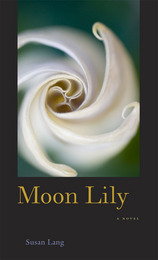 Moon Lily: (a novel)
Susan Lang
University of Nevada Press, 2008 Ruth Farley is a stubbornly independent, free-spirited woman who homesteaded a piece of land at Glory Springs, deep in a beautiful, remote canyon in the Southern California Mojave Desert. At the end of the 1930s she is still there, raising her two children and struggling to preserve her solitude. But the world is intruding. Her Indian friend Martha has been arrested for a murder she didn’t commit, and Ruth must join the Yuiatei tribe in trying to free her. In this final volume of Susan Lang’s Ruth Farley trilogy, Ruth discovers the limits of her autonomy and struggles to make peace with her painful past. As the story comes to a dramatic conclusion and the world descends into the madness of another war, Ruth finally understands that she is inextricably part of the human community and that her hard-won independence will not be sacrificed if she accepts and cherishes the bonds of love and friendship. Ruth Farley is one of the most memorable characters in recent fiction, a perplexing, sometimes exasperating, and utterly sympathetic modern woman torn between her desire for freedom and her need for love, her determination to live life on her own terms and the pressures that society places on a single woman. In this trilogy of novels, Susan Lang has achieved her place among our best contemporary fiction writers.
 Moon Mirrored Indivisible
Farid Matuk
University of Chicago Press, 2025 Multilayered lyric poems that resist systems of power and foster intimacy.
An inheritor of lineages marked by colonial and gendered violence, Farid Matuk approaches the musical capacities of verse not as mere excitation or decoration, but as forms that reclaim pleasure and presence. Entering the sonic constellations of Moon Mirrored Indivisible, the reader finds relief from nesting layers of containment that systems of power impose on our bodies and imaginations. In this hall of historical mirrors, fictions of identity are refracted, reflected, and multiplied into a vast field of possibilities. Matuk’s meditations on place and power offer experiments in self-understanding, moving through expansive conversations between a lyric “I” and others, including poets, the speaker’s partner, ancestors, and the reader, and creating spaces for strange intimacy. Each of the book’s four sections of poems builds on the other to ask how we might form a collective—a people—not founded in orthodoxies of originality but in the mutual work of mirroring one another.
Moon News
Craig Blais
University of Arkansas Press, 2021 Finalist, 2022 Housatonic Book Awards Craig Blais’s Moon News, a finalist for the 2021 Miller Williams Poetry Prize, deploys the sonnet form to treat subjects as diverse as Gregor Samsa, SpongeBob SquarePants, and the cosmos. Here the form’s capaciousness is engaged to full effect. Blais, who turned to the sonnet as a method for focusing on the present in the early days of his recovery from alcoholism, confronts personal demons, loss, and the possibility for healing. These aren’t your grandmother’s sonnets—though you might find her pea soup recipe or sex tape in this remarkable second collection.
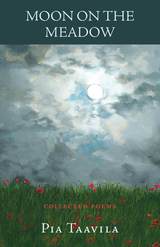 Moon on the Meadow: Collected Poems
Pia Taavila-Borsheim
Gallaudet University Press, 2008 As a child of deaf adults (CODA), Pia Taavila first learned to communicate when her deaf father fingerspelled the names of toys in her crib and her mother showed her the signs for objects in picture books. From this primary visual orientation, in combination with her own innate sense of imagery, Taavila crafted the lush verse featured in Moon on the Meadow: Collected Poems.
Taavila uses the graphic power of her poetry to evoke emotions about all aspects of existence — love, loss of love, family, death, and desire — feelings elicited through a lens attuned to the simple beauty of the natural. Most of the poems in Moon on the Meadow have been published at least once in established journals, testimony to the broad appeal of her passionate outlook on life. Yet, Taavila believes that her experiences as a CODA are essential to her ability to write at all. She never strays far from her home, her family, and the comforts they bring her through her art:
At a wedding, a flautist’s
languid notes lilt on the air.
My mother, who cannot hear,
leans forward, attentive
to the dip and sway of his body.
She signs to me:
It sounds like butterflies
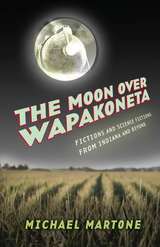 The Moon over Wapakoneta: Fictions and Science Fictions from Indiana and Beyond
Michael Martone
University of Alabama Press, 2018 Lyric fictions by a master fabulist of America’s Midwest
The Moon over Wapakoneta is vintage Michael Martone, the visionary oracle of the American Midwest with the gift for discovering the marvelous in the mundane. In these stories Martone shows us how traveling across time zones from Ohio to Indiana is a form of time travel; how a beer bottle can serve as a kind of telescope, how Amish might power their spaceships with windmills as they travel through space and time. These stories capture the paradox of feeling that one is in the heart of the country while at the same time in the middle of nowhere, of natives who find themselves strangers in their once familiar, but now strange, lands.
On display is a love of obsolete technologies, small-town whimsy, home movies of proms and birthday parties, steam engines and baseball games. If Italo Calvino lived in Indiana rather than Italy, these are the fictions he might have made.
Moonbook and Sunbook
Willis Barnstone
Tupelo Press, 2014 Willis Barnstone’s new volume of poetry offers two sequences paired, pivoting on lunar and solar consciousness and comprised mostly of multiplying sonnets, two per page and mirrored typographically across the page-spreads. Elegant in erudition but always fluently conversational, this book is an homage to the poet’s father and moving proof of an astonishingly productive life in letters.
The Moons of August
Danusha Lameris
Autumn House Press, 2014 Winner of the 2013 Autumn House Press Poetry Contest, selected by Naomi Shihab Nye. This stunning debut collection explores family culture, motherhood, and memory.
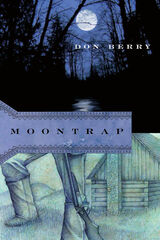 Moontrap
Don Berry
Oregon State University Press, 1962 Winner of the Western Writers of America Spur Award for best historical novel, Moontrap is a book of remarkable beauty and power about a man caught between his vivid past and an uncertain future. The year is 1850, a transitional period in the new Oregon Territory, with settlers and lawmakers working to subdue the untamed region. Johnson Monday, a former mountain man, has been living on a bend of the Willamette River near Oregon City for seven years with his Shoshone Indian wife, struggling to make a place in settled society. One day, Webster T. Webster, a raucous, unrepentant trapper, arrives for an unexpected visit. With his earthy humor and stubborn adherence to the simple life, "Webb" leads Monday through adventures that flirt dangerously close to lawlessness, while helping him to rediscover his moral center. Through defiance, triumph, and tragedy, Moontrap follows Johnson Monday as he realizes that relinquishing the stark honesty of mountain life for the compromises of civilization may be too high a price to pay. Following Trask in Don Berry's trilogy of novels set in the Oregon Territory, Moontrap offers a richly comic and intensely poignant portrayal of pioneer life.
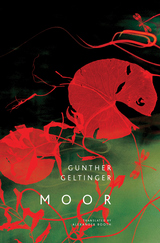 Moor
Gunther Geltinger
Seagull Books, 2017 It’s the early 1970s and Dion Katthusen, thirteen, is growing up fatherless in a small village in northern Germany. An only child plagued with a devastating stutter, Dion is ostracized by his peers and finds solace in the company of nature, collecting dragonflies in a moor filled with myths and legends. On the precipice of adulthood, Dion begins to spill the secrets of his heart—his burning desire for faultless speech and his abiding relationship with his mother, a failed painter with secrets of her own. Even as Dion spins his story, his speech is filled with fissures and holes—much like the swampy earth that surrounds him. Nature, though so often sublime, can also be terribly cruel.
Moor is Dion’s story—a story of escaping the quicksand of loneliness and of the demands we make on love, even as those surrounding us are hurt in their misguided attempts to bear our suffering. Powerfully tuned to the relationship between human and nature, mother and son, Moor is a mysterious and experimental portrait of childhood. Written by up-and-coming German novelist Gunther Geltinger, the novel received critical acclaim in Germany and is now presented in English for the first time by translator Alexander Booth. Evocative and bold, Dion’s story emerges from the forces of nature, his voice rising from the ground beneath the reader’s feet, not soon to be forgotten.
 Moorings and Metaphors: Figures of Culture and Gender in Black Women's Literature
Karla F. Holloway
Rutgers University Press, 1991 Moorings and Metaphors is one of the first studies to examine the ways that cultural tradition is reflected in the language and figures of black women's writing. In a discussion that includes the works of Gloria Naylor, Alice Walker, Ama Ata Aidoo, Ntozake Shange, Buchi Emecheta, Octavia Butler, Efua Sutherland, and Gayl Jones, and with a particular focus on Toni Morrison's Beloved and Flora Nwapa's Efuru, Holloway follows the narrative structures, language, and figurative metaphors of West African goddesses and African-American ancestors as they weave through the pages of these writers' fiction. She explores what she would call the cultural and gendered essence of contemporary literature that has grown out of the African diaspora.
Proceeding from a consideration of the imaginative textual languages of contemporary African-American and West African writers, Holloway asserts the intertextuality of black women's literature across two continents. She argues the subtext of culture as the source of metaphor and language, analyzes narrative structures and linguistic processes, and develops a combined theoretical/critical apparatus and vocabulary for interpreting these writers' works. The cultural sources and spiritual considerations that inhere in these textual languages are discussed within the framework Holloway employs of patterns of revision, (re)membrance, and recursion--all of which are vehicles for expressive modes inscribed at the narrative level. Her critical reading of contemporary black women's writing in the United States and West Africa is unique, radical, and sure to be controversial.
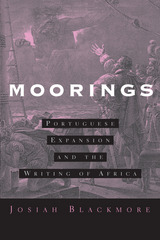 Moorings: Portuguese Expansion and the Writing of Africa
Josiah Blackmore
University of Minnesota Press, 2008 How Africa was perceived in the early modern imaginary In this first book to study Portuguese texts about Africa, Moorings brings an important but little-known body of European writings to bear on contemporary colonial thought. Images of Africa as monstrous, dangerous, and lush were created in early Portuguese imperial writings and dominated its representation in European literature. Moorings establishes these key works in their proper place: foundational to Western imperial discourse. Attentive to history as well as the nuances of language, Josiah Blackmore leads readers from the formation of the “Moor” in medieval Iberia to the construction of a full colonial imaginary, as found in the works of two writers: the royal chronicler Gomes Eanes de Zurara and the epic poet Luís de Camões. Blackmore’s original work helps to explain how concepts and myths—such as the “otherness” of Africa and Africans—originated, functioned, and were perpetuated.Delving into the Portuguese imperial experience, Moorings enriches our understanding of historical and literary imagination during a significant period of Western expansion.
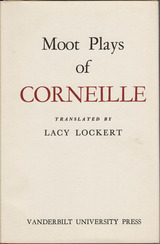 Moot Plays of Corneille
Lacy Lockert
Vanderbilt University Press, 1959 Some plays of Corneille that were formerly considered masterpieces are no longer admired; others that were little liked are now much acclaimed by critics. Amid such changes—and such divergences—of evaluation, the student of drama who is lacking in knowledge of French, but who has a critical sense perhaps equal or even superior to that of many people who are better linguists, may wish that he could judge for himself. This he can do with reasonable assurance by means of translations, just as is commonly done with the dramas of Ibsen. Except as regards poetry, a play can be appraised in a good translation almost as well as in its own language.
In an earlier book, The Chief Plays of Corneille, Dr. Lockert translated the six most famous (but not necessarily the best) tragedies of that dramatist. The present volume makes available to English readers all his other plays, comedies aside, for which high claims have been or could be made. Some recent critics have pronounced some of them superior to everything else of Corneille but the Cid and Polyeucte.
A brief introduction is prefixed to each play, giving examples of the diverse opinions held by representative critics in the last eighty-five years.
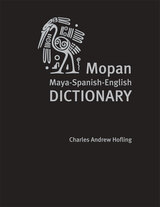 Mopan Maya-Spanish-English Dictionary
Charles A Hofling
University of Utah Press, 2011 Charles Andrew Hofling Smithsonian-Utah Publications in American Indian Languages Lyle Campbell and Ives Goddard Linguistics This is highly valuable dictionary of the Mopan (Mayan) language. In addition to its many entries, it also provides an introductory grammatical description, as well as general dictionary features such as parts of speech, examples, cross-references, variant forms, homophones, and indexes. The book also contains special sections on orthography and pronunciation unique to this important Mayan language, as well as translations into English and Spanish.
The dictionary has the merits well known from other dictionaries of indigenous languages of the Americas, preserving knowledge systems as they are encoded in vocabulary and providing valuable information for numerous fields, including Mayanists, Mesoamericanists, American Indian scholars, anthropologists, historians, linguists, students of Mayan hieroglyphic writing, and members of modern Mayan communities, among others.
This is the second book in the new Smithsonian-Utah Publications in American Indian Languages (SUPAIL) series, a joint venture of the University of Utah Press and the Smithsonian Institution.
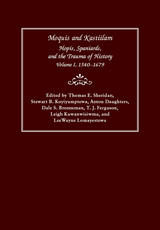 Moquis and Kastiilam: Hopis, Spaniards, and the Trauma of History, Volume I, 1540–1679
Edited by Thomas E. Sheridan, Stewart B. Koyiyumptewa, Anton Daughters, Dale S. Brenneman, T. J. Ferguson, Leigh Kuwanwisiwma, and Lee Wayne Lomayestewa
University of Arizona Press, 2015 The first of a two-volume series, Moquis and Kastiilam tells the story of the encounter between the Hopis, who the Spaniards called Moquis, and the Spaniards, who the Hopis called Kastiilam, from the first encounter in 1540 until the eve of the Pueblo Revolt of 1680. By comparing and contrasting Spanish documents with Hopi oral traditions, the editors portray a balanced presentation of their shared past. Translations of sixteenth-, seventeenth-, and eighteenth-century documents written by Spanish explorers, colonial officials, and Franciscan missionaries tell the perspectives of the European visitors, and oral traditions recounted by Hopi elders reveal the Indigenous experience.
The editors argue that the Spanish record is incomplete, and only the Hopi perspective can balance the story. The Spanish documentary record (and by extension the documentary record of any European or Euro-American colonial power) is biased and distorted, according to the editors, who assert there are enormous silences about Hopi responses to Spanish missionization and colonization. The only hope of correcting those weaknesses is to record and analyze Hopi oral traditions, which have been passed down from generation to generation, and give voice to Hopi values and Hopi social memories of what was a traumatic period in their past.
Spanish abuses during missionization—which the editors address specifically and directly as the sexual exploitation of Hopi women, suppression of Hopi ceremonies, and forced labor of Hopis—drove Hopis to the breaking point, inspiring a Hopi revitalization that led them to participate in the Pueblo Revolt. Those abuses, the revolt, and the resistance that followed remain as open wounds in Hopi society today.
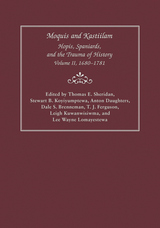 Moquis and Kastiilam: Hopis, Spaniards, and the Trauma of History, Volume II, 1680–1781
Edited by Thomas E. Sheridan, Stewart B. Koyiyumptewa, Anton Daughters, Dale S. Brenneman, T. J. Ferguson, Leigh Kuwanwisiwma, and Lee Wayne Lomayestewa
University of Arizona Press, 2020 The second in a two-volume series, Moquis and Kastiilam, Volume II, 1680–1781 continues the story of the encounter between the Hopis, who the Spaniards called Moquis, and the Spaniards, who the Hopis called Kastiilam, from the Pueblo Revolt in 1680 through the Spanish expeditions in search of a land route to Alta California until about 1781. By comparing and contrasting Spanish documents with Hopi oral traditions, the editors present a balanced presentation of a shared past. Translations of sixteenth-, seventeenth-, and eighteenth-century documents written by Spanish explorers, colonial officials, and Franciscan missionaries tell the perspectives of the European visitors, and oral traditions recounted by Hopi elders reveal the Indigenous experience. The editors argue that only the Hopi perspective can balance the story recounted in the Spanish documentary record, which is biased, distorted, and incomplete (as is the documentary record of any European or Euro-American colonial power). The only hope of correcting those weaknesses and the enormous silences about the Hopi responses to Spanish missionization and colonization is to record and analyze Hopi oral traditions, which have been passed down from generation to generation since 1540, and to give voice to Hopi values and social memories of what was a traumatic period in their past. Volume I documented Spanish abuses during missionization, which the editors address specifically and directly as the sexual exploitation of Hopi women, suppression of Hopi ceremonies, and forced labor of Hopi men and women. These abuses drove Hopis to the breaking point, inspiring a Hopi revitalization that led them to participate in the Pueblo Revolt and to rebuff all subsequent efforts to reestablish Franciscan missions and Spanish control. Volume II portrays the Hopi struggle to remain independent at its most effective—a mixture of diplomacy, negotiation, evasion, and armed resistance. Nonetheless, the abuses of Franciscan missionaries, the bloodshed of the Pueblo Revolt, and the subsequent destruction of the Hopi community of Awat’ovi on Antelope Mesa remain historical traumas that still wound Hopi society today.
Moral Action: A Phenomenological Study
Robert Sokolowski
Catholic University of America Press, 2017 “In this carefully written study of the constituents of human decision making, Robert Sokolowski lays an elaborate groundwork to develop the importance of the distinction between choice and the voluntary in moral discourse…offers a new way of looking at m
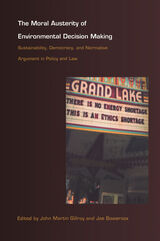 The Moral Austerity of Environmental Decision Making: Sustainability, Democracy, and Normative Argument in Policy and Law
John Martin Gillroy and Joe Bowersox, eds.
Duke University Press, 2002 In The Moral Austerity of Environmental Decision Making a group of prominent environmental ethicists, policy analysts, political theorists, and legal experts challenges the dominating influence of market principles and assumptions on the formulation of environmental policy. Emphasizing the concept of sustainability and the centrality of moral deliberation to democracy, they examine the possibilities for a wider variety of moral principles to play an active role in defining “good” environmental decisions. If environmental policy is to be responsible to humanity and to nature in the twenty-first century, they argue, it is imperative that the discourse acknowledge and integrate additional normative assumptions and principles other than those endorsed by the market paradigm. The contributors search for these assumptions and principles in short arguments and debates over the role of science, social justice, instrumental value, and intrinsic value in contemporary environmental policy. In their discussion of moral alternatives to enrich environmental decision making and in their search for a less austere and more robust role for normative discourse in practical policy making, they analyze a series of original case studies that deal with environmental sustainability and natural resources policy including pollution, land use, environmental law, globalism, and public lands. The unique structure of the book—which features the core contributors responding in a discourse format to the central chapters’ essays and debates—helps to highlight the role personal and public values play in democratic decision making generally and in the field of environmental politics specifically. Contributors. Joe Bowersox, David Brower, Susan Buck, Celia Campbell-Mohn, John Martin Gillroy, Joel Kassiola, Jan Laitos, William Lowry, Bryan Norton, Robert Paehlke, Barry G. Rabe, Mark Sagoff, Anna K. Schwab, Bob Pepperman Taylor, Jonathan Wiener
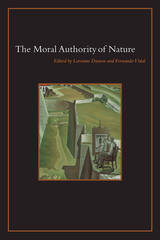 The Moral Authority of Nature
Edited by Lorraine Daston and Fernando Vidal
University of Chicago Press, 2003 For thousands of years, people have used nature to justify their political, moral, and social judgments. Such appeals to the moral authority of nature are still very much with us today, as heated debates over genetically modified organisms and human cloning testify.
The Moral Authority of Nature offers a wide-ranging account of how people have used nature to think about what counts as good, beautiful, just, or valuable. The eighteen essays cover a diverse array of topics, including the connection of cosmic and human orders in ancient Greece, medieval notions of sexual disorder, early modern contexts for categorizing individuals and judging acts as "against nature," race and the origin of humans, ecological economics, and radical feminism. The essays also range widely in time and place, from archaic Greece to early twentieth-century China, medieval Europe to contemporary America.
Scholars from a wide variety of fields will welcome The Moral Authority of Nature, which provides the first sustained historical survey of its topic.
Contributors:
Danielle Allen, Joan Cadden, Lorraine Daston, Fa-ti Fan, Eckhardt Fuchs, Valentin Groebner, Abigail J. Lustig, Gregg Mitman, Michelle Murphy, Katharine Park, Matt Price, Robert N. Proctor, Helmut Puff, Robert J. Richards, Londa Schiebinger, Laura Slatkin, Julia Adeney Thomas, Fernando Vidal
The Moral Bond of Community: Justice and Discourse in Christian Morality
Bernard V. Brady
Georgetown University Press, 1998 Comprehensive in its approach yet written in plain language, The Moral Bond of Community offers a biblically-based concept of Christian justice that can be applied to moral questions in everyday life. Brady examines four forms of Christian moral discourse—narrative, prophetic, ethical, and policy—and shows how each contributes to a fuller understanding of Christian morality.
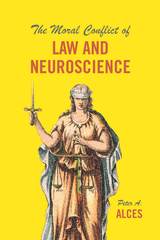 The Moral Conflict of Law and Neuroscience
Peter A. Alces
University of Chicago Press, 2018 Law relies on a conception of human agency, the idea that humans are capable of making their own choices and are morally responsible for the consequences. But what if that is not the case? Over the past half century, the story of the law has been one of increased acuity concerning the human condition, especially the workings of the brain. The law already considers select cognitive realities in evaluating questions of agency and responsibility, such as age, sanity, and emotional distress. As new neuroscientific research comprehensively calls into question the very idea of free will, how should the law respond to this revised understanding?
Peter A. Alces considers where and how the law currently fails to appreciate the neuroscientific revelation that humans may in key ways lack normative free will—and therefore moral responsibility. The most accessible setting in which to consider the potential impact of neuroscience is criminal law, as certain aspects of criminal law already reveal the naiveté of most normative reasoning, such as the inconsistent treatment of people with equally disadvantageous cognitive deficits, whether congenital or acquired. But tort and contract law also assume a flawed conception of human agency and responsibility. Alces reveals the internal contradictions of extant legal doctrine and concludes by considering what would be involved in constructing novel legal regimes based on emerging neuroscientific insights.
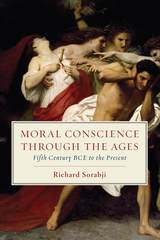 Moral Conscience through the Ages: Fifth Century BCE to the Present
Richard Sorabji
University of Chicago Press, 2014 In Moral Conscience through the Ages, Richard Sorabji brings his erudition and philosophical acumen to bear on a fundamental question: what is conscience? Examining the ways we have conceived of that little voice in our heads—our self-directed judge—he teases out its most enduring elements, the aspects that have survived from the Greek playwrights in the fifth century BCE through St Paul, the Church Fathers, Catholics and Protestants, all the way to the 17th century’s political unrest and the critics and champions of the eighteenth to twentieth centuries.
Sorabji examines an impressive breadth of topics: the longing for different kinds of freedom of conscience, the proper limits of freedom itself, protests at conscience’s being ‘terrorized,’ dilemmas of conscience, the value of conscience to human beings, its secularization, its reliability, and ways to improve it. These historical issues are alive today, with fresh concerns about topics such as conscientious objection, the force of conscience, or the balance between freedoms of conscience, religion, and speech. The result is a stunningly comprehensive look at a central component of our moral understanding.
Moral Demands and Personal Obligations
Josef Fuchs, SJ
Georgetown University Press, 1993 In this collection of recent essays (1988-92), all but one previously unavailable in English, noted theologian Josef Fuchs, SJ, examines key issues in normative morality. Identifying two strains, one based on natural law and a more situational one based on the Golden Rule, he explores the need for plurality in both individual and societal ethics, and the problem of universal versus only general validity. Central ideas that Fuchs develops are the concept of innovative morality as the individual's responsible search for God's will in personal situations; and the significance of the conscience in the face of official statements by the church's magisterium. Among the topics he considers are marriage and sexuality; the beginning and end of life; and international solidarity and social justice.
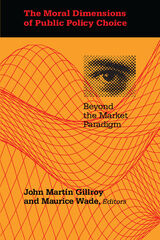 The Moral Dimensions of Public Policy Choice: Beyond the Market Paradigm
John Martin Gillroy
University of Pittsburgh Press, 1992
Combining philosophy with practical politics, an expanding area of policy studies applies moral precepts, critical principles, and conventional values to collective decisions. This evolving new approach to policy analysis asserts that the same variety of ethical principles available to the individual are also available to make collective decisions in the public interest and should be used.
Although policy analysis has long been dominated by assumptions originally developed for the examination of markets, such as efficiency, these essays by leading scholars - the best work done in the field over the past three decades - explore alternatives to the “market paradigm” and show how moral discrimination and choice can extend beyond the individual to encompass public decisions.
Chapters by John Martin Gillroy and Maurice Wade review the political philosophies of Immanuel Kant and David Hume as backgrounds for the development of modern concepts of public policy choice. They present this anthology as a first step in codifying options, arguments, and methods within this important developing area of policy studies.
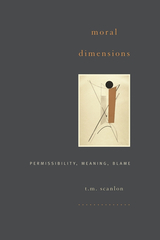 Moral Dimensions: Permissibility, Meaning, Blame
T. M. Scanlon
Harvard University Press, 2010 In a clear and elegant style, T. M. Scanlon reframes current philosophical debates as he explores the moral permissibility of an action. Permissibility may seem to depend on the agent’s reasons for performing an action. For example, there seems to be an important moral difference between tactical bombing and a campaign by terrorists—even if the same number of non-combatants are killed—and this difference may seem to lie in the agents’ respective aims. However, Scanlon argues that the apparent dependence of permissibility on the agent’s reasons in such cases is merely a failure to distinguish between two kinds of moral assessment: assessment of the permissibility of an action and assessment of the way an agent decided what to do.
Distinguishing between these two forms of assessment leads Scanlon to an important distinction between the permissibility of an action and its meaning: the significance for others of the agent’s willingness to act in this way. An action’s meaning depends on the agent’s reasons for performing it in a way that its permissibility does not. Blame, he argues, is a response to the meaning of an action rather than its permissibility. This analysis leads to a novel account of the conditions of moral responsibility and to important conclusions about the ethics of blame.
 Moral Discourse in a Pluralistic World
Daniel Vokey
University of Notre Dame Press, 2001 How shall we collectively confront the global problems we face? In Moral Discourse in a Pluralistic World, Daniel Vokey argues that it is possible for people from very different religious, political, philosophical, and cultural traditions to talk productively about the issues that divide them.
Vokey refutes moral scepticism—the pervasive belief that conflict is impossible to resolve in a rational way—by confronting two kinds of relativist arguments: that we cannot understand the positions of people whose perspectives are incommensurable with our own and that moral values are matters, not of truth, but of opinion, preference, and custom. Vokey challenges the first by reconstructing and extending Alasdair MacIntyre’s account of the rationality of traditions of inquiry. Using the term moral discourse to refer to the processes involved in assessing moral points of view, Vokey shows how evaluating the relative merits of rival paradigms is a crucial step in the search for consensus.
Vokey confronts the second kind of relativist argument by drawing from the teachings of Mahayana Buddhism. He uses Buddhist teachings to locate moral truth in our reasons of the heart, our prediscursive understanding of what is genuinely worth caring about most deeply, while also restoring the link within Aristotelian ethics between the good and the beautiful.
By clarifying the ways in which genuine agreement on moral issues can be pursued through moral discourse, Vokey provides a coherent conceptual framework for addressing the political, social, and environmental problems arising from unresolved moral conflict.
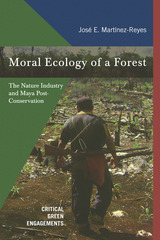 Moral Ecology of a Forest: The Nature Industry and Maya Post-Conservation
José E. Martínez-Reyes
University of Arizona Press, 2016 Forests are alive, filled with rich, biologically complex life forms and the interrelationships of multiple species and materials. Vulnerable to a host of changing conditions in this global era, forests are in peril as never before. New markets in carbon and environmental services attract speculators. In the name of conservation, such speculators attempt to undermine local land control in these desirable areas.
Moral Ecology of a Forest provides an ethnographic account of conservation politics, particularly the conflict between Western conservation and Mayan ontological ecology. The difficult interactions of the Maya of central Quintana Roo, Mexico, for example, or the Mayan communities of the Sain Ka’an Biosphere, demonstrate the clashing interests with Western biodiversity conservation initiatives. The conflicts within the forest of Quintana Roo represent the outcome of nature in this global era, where the forces of land grabbing, conservation promotion and organizations, and capitalism vie for control of forests and land.
Forests pose living questions. In addition to the ever-thrilling biology of interdependent species, forests raise questions in the sphere of political economy, and thus raise cultural and moral questions. The economic aspects focus on the power dynamics and ideological perspectives over who controls, uses, exploits, or preserves those life forms and landscapes. The cultural and moral issues focus on the symbolic meanings, forms of knowledge, and obligations that people of different backgrounds, ethnicities, and classes have constructed in relation to their lands. The Maya Forest of Quintana Roo is a historically disputed place in which these three questions come together.
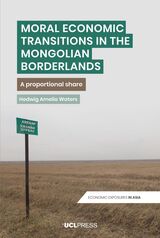 Moral Economic Transitions in the Mongolian Borderlands: A Proportional Share
Hedwig Amelia Waters
University College London, 2023 A nuanced exploration of the effects of the transition to market democracy in Mongolia’s remotest areas.
In the early 1990s, Mongolia began a transition from socialism to a market democracy. In the process, the country became more than ever dependent on international mining revenue. Nearly thirty years later, many of Mongolia’s poor and rural feel that, rather than share in the prosperity the transition was supposed to spread, they have been forgotten.
Moral Economic Transitions in the Mongolian Borderlands analyzes this period of change from the viewpoint of the rural township of Magtaal on the Chinese border. After the end of socialism, the population of this resource-rich area found itself without employment or state institutions yet surrounded by lush nature and mere kilometers from the voracious Chinese market. A two-tiered resource-extractive political-economic system developed. At the same time as large-scale, formal, legally sanctioned conglomerates arrived to extract oil and other resources, local residents grew increasingly dependent on the Chinese-funded informal, illegal cross-border wildlife trade. More than a story about rampant capitalist extraction in the resource frontier, this book intimately details the complex inner worlds, moral ambiguities, and emergent collective politics constructed by individuals who feel caught in political-economic shifts that are largely outside of their control.
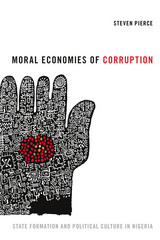 Moral Economies of Corruption: State Formation and Political Culture in Nigeria
Steven Pierce
Duke University Press, 2016 Nigeria is famous for "419" e-mails asking recipients for bank account information and for scandals involving the disappearance of billions of dollars from government coffers. Corruption permeates even minor official interactions, from traffic control to university admissions. In Moral Economies of Corruption Steven Pierce provides a cultural history of the last 150 years of corruption in Nigeria as a case study for considering how corruption plays an important role in the processes of political change in all states. He suggests that corruption is best understood in Nigeria, as well as in all other nations, as a culturally contingent set of political discourses and historically embedded practices. The best solution to combatting Nigerian government corruption, Pierce contends, is not through attempts to prevent officials from diverting public revenue to self-interested ends, but to ask how public ends can be served by accommodating Nigeria's history of patronage as a fundamental political principle.
The Moral Economy of the State: Conservation, Community Development, and State-Making in Zimbabwe
William A. Munro
Ohio University Press, 1998 The Moral Economy of the State examines state formation in Zimbabwe from the colonial period through the first decade of independence. Drawing on the works of Gramsci, E. P. Thompson, and James Scott, William Munro develops a theory of “moral economy” that explores negotiations between rural citizens and state agents over legitimate state incursions in social life. This analysis demonstrates how states try to shape the meanings of citizenship for agrarian populations by redefining conceptions of the public good, property rights, and community membership. The book’s focus on the moral economy of the state offers a refreshing perspective on the difficulties experienced by postcolonial African states in building stronger state and rural institutions.
 The Moral Electricity of Print: Transatlantic Education and the Lima Women's Circuit, 1876-1910
Ronald Briggs
Vanderbilt University Press, 2017 Best Nineteenth-Century Book Award Winner, 2018, Latin American Studies Association Nineteenth-Century Section
Moral electricity—a term coined by American transcendentalists in the 1850s to describe the force of nature that was literacy and education in shaping a greater society. This concept wasn't strictly an American idea, of course, and Ronald Briggs introduces us to one of the greatest examples of this power: the literary scene in Lima, Peru, in the nineteenth century.
As Briggs notes in the introduction to The Moral Electricity of Print, "the ideological glue that holds the American hemisphere together is a hope for the New World as a grand educational project combined with an anxiety about the baleful influence of a politically and morally decadent Old World that dominated literary output through its powerful publishing interests." The very nature of living as a writer and participating in the literary salons of Lima was, by definition, a revolutionary act that gave voice to the formerly colonized and now liberated people. In the actions of this literary community, as men and women worked toward the same educational goals, we see the birth of a truly independent Latin American literature.
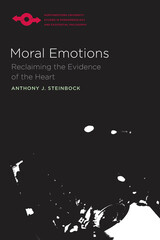 Moral Emotions: Reclaiming the Evidence of the Heart
Anthony J. Steinbock
Northwestern University Press, 2014 Winner, 2015 CSCP Symposium Book Award Moral Emotions builds upon the philosophical theory of persons begun in Phenomenology and Mysticism and marks a new stage of phenomenology. Author Anthony J. Steinbock finds personhood analyzing key emotions, called moral emotions. Moral Emotions offers a systematic account of the moral emotions, described here as pride, shame, and guilt as emotions of self-givenness; repentance, hope, and despair as emotions of possibility; and trusting, loving, and humility as emotions of otherness. The author argues these reveal basic structures of interpersonal experience. By exhibiting their own kind of cognition and evidence, the moral emotions not only help to clarify the meaning of person, they reveal novel concepts of freedom, critique, and normativity. As such, they are able to engage our contemporary social imaginaries at the impasse of modernity and postmodernity.
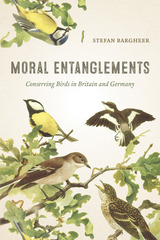 Moral Entanglements: Conserving Birds in Britain and Germany
Stefan Bargheer
University of Chicago Press, 2018 At the center of Stefan Bargheer’s account of bird watching, field ornithology, and nature conservation in Britain and Germany stands the question of how values change over time and how individuals develop moral commitments. Using life history data derived from written narratives and oral histories, Moral Entanglements follows the development of conservation from the point in time at which the greatest declines in bird life took place to the current efforts in large-scale biodiversity conservation and environmental policy within the European Union. While often depicted as the outcome of an environmental revolution that has taken place since the 1960s, Bargheer demonstrates to the contrary that the relevant practices and institutions that shape contemporary conservation have evolved gradually since the early nineteenth century. Moral Entanglements further shows that the practices and institutions in which bird conservation is entangled differ between the two countries. In Britain, birds derived their meaning in the context of the game of bird watching as a leisure activity. Here birds are now, as then, the most popular and best protected taxonomic group of wildlife due to their particularly suitable status as toys in a collecting game, turning nature into a playground. In Germany, by contrast, birds were initially part of the world of work. They were protected as useful economic tools, rendering services of ecological pest control in a system of agricultural production modeled after the factory shop floor. Based on this extensive analysis, Bargheer formulates a sociology of morality informed by a pragmatist theory of value.
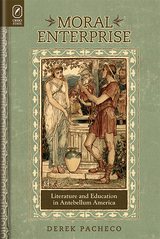 Moral Enterprise: Literature and Education in Antebellum America
Derek Pacheco
Ohio State University Press, 2013 Moral Enterprise: Literature and Education in Antebellum America, by Derek Pacheco,investigates an important moment in the history of professional authorship. Pacheco uses New England “literary reformers” Horace Mann, Nathaniel Hawthorne, Elizabeth Peabody, and Margaret Fuller to argue that writers came to see in educational reform, and the publication venues emerging in connection with it, a means to encourage popular authorship while validating literary work as a profession. Although today’s schools are staffed by systematically trained and institutionally sanctioned teachers, in the unregulated, decentralized world of antebellum America, literary men and women sought the financial stability of teaching while claiming it as moral grounds for the pursuit of greater literary fame. Examining the ethically redemptive and potentially lucrative definition of antebellum author as educator, this book traces the way these literary reformers aimed not merely at social reform through literature but also at the reform of literature itself by employing a wide array of practices—authoring, editing, publishing, and distributing printed texts—brought together under the aegis of modern, democratic education. Moral Enterprise identifies such endeavors by their dual valence as bold, reformist undertakings and economic ventures, exploring literary texts as educational commodities that might act as entry points into, and ways to tame, what Mann characterized as the “Alexandrian library” of American print culture.
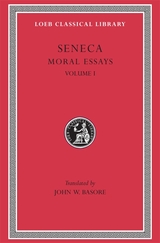 Moral Essays, Volume I: De Providentia. De Constantia. De Ira. De Clementia
Seneca
Harvard University Press Topics in Stoicism.
Seneca, Lucius Annaeus, born at Corduba (Cordova) ca. 4 BC, of a prominent and wealthy family, spent an ailing childhood and youth at Rome in an aunt’s care. He became famous in rhetoric, philosophy, money-making, and imperial service. After some disgrace during Claudius’ reign he became tutor and then, in AD 54, advising minister to Nero, some of whose worst misdeeds he did not prevent. Involved (innocently?) in a conspiracy, he killed himself by order in 65. Wealthy, he preached indifference to wealth; evader of pain and death, he preached scorn of both; and there were other contrasts between practice and principle.
We have Seneca’s philosophical or moral essays (ten of them traditionally called Dialogues)—on providence, steadfastness, the happy life, anger, leisure, tranquility, the brevity of life, gift-giving, forgiveness—and treatises on natural phenomena. Also extant are 124 epistles, in which he writes in a relaxed style about moral and ethical questions, relating them to personal experiences; a skit on the official deification of Claudius, Apocolocyntosis (in LCL 15); and nine rhetorical tragedies on ancient Greek themes. Many epistles and all his speeches are lost.
His moral essays are collected in Volumes I–III of the Loeb Classical Library’s ten-volume edition of Seneca.
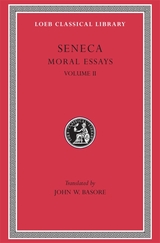 Moral Essays, Volume II: De Consolatione ad Marciam. De Vita Beata. De Otio. De Tranquillitate Animi. De Brevitate Vitae. De Consolatione ad Polybium. De Consolatione ad Helviam
Seneca
Harvard University Press Topics in Stoicism.
Seneca, Lucius Annaeus, born at Corduba (Cordova) ca. 4 BC, of a prominent and wealthy family, spent an ailing childhood and youth at Rome in an aunt’s care. He became famous in rhetoric, philosophy, money-making, and imperial service. After some disgrace during Claudius’ reign he became tutor and then, in AD 54, advising minister to Nero, some of whose worst misdeeds he did not prevent. Involved (innocently?) in a conspiracy, he killed himself by order in 65. Wealthy, he preached indifference to wealth; evader of pain and death, he preached scorn of both; and there were other contrasts between practice and principle.
We have Seneca’s philosophical or moral essays (ten of them traditionally called Dialogues)—on providence, steadfastness, the happy life, anger, leisure, tranquility, the brevity of life, gift-giving, forgiveness—and treatises on natural phenomena. Also extant are 124 epistles, in which he writes in a relaxed style about moral and ethical questions, relating them to personal experiences; a skit on the official deification of Claudius, Apocolocyntosis (in LCL 15); and nine rhetorical tragedies on ancient Greek themes. Many epistles and all his speeches are lost.
His moral essays are collected in Volumes I–III of the Loeb Classical Library’s ten-volume edition of Seneca.
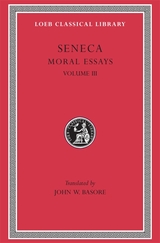 Moral Essays, Volume III: De Beneficiis
Seneca
Harvard University Press Topics in Stoicism.
Seneca, Lucius Annaeus, born at Corduba (Cordova) ca. 4 BC, of a prominent and wealthy family, spent an ailing childhood and youth at Rome in an aunt’s care. He became famous in rhetoric, philosophy, money-making, and imperial service. After some disgrace during Claudius’ reign he became tutor and then, in AD 54, advising minister to Nero, some of whose worst misdeeds he did not prevent. Involved (innocently?) in a conspiracy, he killed himself by order in 65. Wealthy, he preached indifference to wealth; evader of pain and death, he preached scorn of both; and there were other contrasts between practice and principle.
We have Seneca’s philosophical or moral essays (ten of them traditionally called Dialogues)—on providence, steadfastness, the happy life, anger, leisure, tranquility, the brevity of life, gift-giving, forgiveness—and treatises on natural phenomena. Also extant are 124 epistles, in which he writes in a relaxed style about moral and ethical questions, relating them to personal experiences; a skit on the official deification of Claudius, Apocolocyntosis (in LCL 15); and nine rhetorical tragedies on ancient Greek themes. Many epistles and all his speeches are lost.
His moral essays are collected in Volumes I–III of the Loeb Classical Library’s ten-volume edition of Seneca.
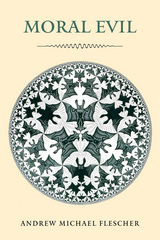 Moral Evil
Andrew Michael Flescher
Georgetown University Press, 2016 The idea of moral evil has always held a special place in philosophy and theology because the existence of evil has implications for the dignity of the human and the limits of human action. Andrew Michael Flescher proposes four interpretations of evil, drawing on philosophical and theological sources and using them to trace through history the moral traditions that are associated with them. The first model, evil as the presence of badness, offers a traditional dualistic model represented by Manicheanism. The second, evil leading to goodness through suffering, presents a theological interpretation known as theodicy. Absence of badness—that is, evil as a social construction—is the third model. The fourth, evil as the absence of goodness, describes when evil exists in lieu of the good—the "privation" thesis staked out nearly two millennia ago by Christian theologian St. Augustine. Flescher extends this fourth model—evil as privation—into a fifth, which incorporates a virtue ethic. Drawing original connections between Augustine and Aristotle, Flescher’s fifth model emphasizes the formation of altruistic habits that can lead us to better moral choices throughout our lives. Flescher eschews the temptation to think of human agents who commit evil as outside the norm of human experience. Instead, through the honing of moral skills and the practice of attending to the needs of others to a greater degree than we currently do, Flescher offers a plausible and hopeful approach to the reality of moral evil.
Moral Imagination: Implications of Cognitive Science for Ethics
Mark Johnson
University of Chicago Press, 1993 Using path-breaking discoveries of cognitive science, Mark Johnson argues that humans are fundamentally imaginative moral animals, challenging the view that morality is simply a system of universal laws dictated by reason. According to the Western moral tradition, we make ethical decisions by applying universal laws to concrete situations. But Johnson shows how research in cognitive science undermines this view and reveals that imagination has an essential role in ethical deliberation.
Expanding his innovative studies of human reason in Metaphors We Live By and The Body in the Mind, Johnson provides the tools for more practical, realistic, and constructive moral reflection.
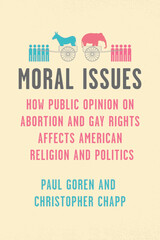 Moral Issues: How Public Opinion on Abortion and Gay Rights Affects American Religion and Politics
Paul Goren and Christopher Chapp
University of Chicago Press, 2024 A new perspective on how beliefs about abortion and gay rights reshaped American politics. Many believe that religious and partisan identities undergird American public opinion. However, when it comes to abortion and gay rights, the reverse may be closer to the truth. Drawing on wide-ranging evidence, Paul Goren and Christopher Chapp show that views on abortion and gay rights are just as durable and politically impactful—and often more so—than political and religious identities. Goren and Chapp locate the lasting strength of stances on abortion and gay rights in the automatic, visceral emotions that the media has primed since the late 1980s. Moral Issues examines how attitudes toward these moralized issues affect, and can sometimes even disrupt, religious and partisan identities. Indeed, over the last thirty years, these attitudes have accelerated the rise of the religious “nones,” who have no religious affiliation, and promoted moral sorting into the Democratic and Republican parties.
 Moral Literacy
Barbara Herman
Harvard University Press, 2008 A distinguished moral philosopher and a leading interpreter of Kant's ethics, Barbara Herman draws on Kant to address timeless issues in ethical theory as well as ones arising from current moral problems, such as obligations to distant need, the history of slavery as it bears on affirmative action, and the moral costs of reparative justice.
Challenging various Kantian orthodoxies, Herman offers a view of moral competency as a complex achievement, governed by rational norms and dependent on supportive social conditions. She argues that the objectivity of duties and obligations does not rule out the possibility of or need for moral invention. Her goal is not to revise Kant but to explore the issues and ask the questions that he did not consider.
Some of the essays involve explicit interpretation of Kant, and others are prompted by ground-level questions. For example, how should we think about moral character given what we know about the fault lines in normal development? If ordinary moral life is saturated by the content of local institutions, how should our accounts of moral obligation and judgment accommodate this?
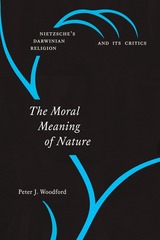 The Moral Meaning of Nature: Nietzsche’s Darwinian Religion and Its Critics
Peter J. Woodford
University of Chicago Press, 2018 What, if anything, does biological evolution tell us about the nature of religion, ethical values, or even the meaning and purpose of life? The Moral Meaning of Nature sheds new light on these enduring questions by examining the significance of an earlier—and unjustly neglected—discussion of Darwin in late nineteenth-century Germany.
We start with Friedrich Nietzsche, whose writings staged one of the first confrontations with the Christian tradition using the resources of Darwinian thought. The lebensphilosophie, or “life-philosophy,” that arose from his engagement with evolutionary ideas drew responses from other influential thinkers, including Franz Overbeck, Georg Simmel, and Heinrich Rickert. These critics all offered cogent challenges to Nietzsche’s appropriation of the newly transforming biological sciences, his negotiation between science and religion, and his interpretation of the implications of Darwinian thought. They also each proposed alternative ways of making sense of Nietzsche’s unique question concerning the meaning of biological evolution “for life.” At the heart of the discussion were debates about the relation of facts and values, the place of divine purpose in the understanding of nonhuman and human agency, the concept of life, and the question of whether the sciences could offer resources to satisfy the human urge to discover sources of value in biological processes. The Moral Meaning of Nature focuses on the historical background of these questions, exposing the complex ways in which they recur in contemporary philosophical debate.
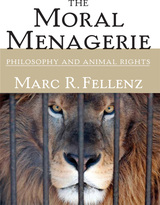 The Moral Menagerie: PHILOSOPHY AND ANIMAL RIGHTS
Marc R. Fellenz
University of Illinois Press, 2006 The Moral Menagerie offers a broad philosophical analysis of the recent debate over animal rights. Marc Fellenz locates the debate in its historical and social contexts, traces its roots in the history of Western philosophy, and analyzes the most important arguments that have been offered on both sides. Fellenz argues that the debate has been philosophically valuable for focusing attention on fundamental problems in ethics and other areas of philosophy, and for raising issues of concern to both Anglo-American and continental thinkers. More provocatively, he also argues that the form the debate often takes--attempting to extend our traditional human-centered moral categories to cover other animals--is ultimately inadequate. Making use of the critical perspectives found in environmentalism, feminism and post-modernism, he concludes that taking animals seriously requires a more radical reassessment our moral framework than the concept of ‘animal rights’ implies.
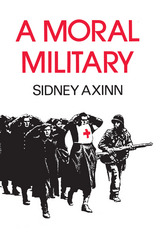 A Moral Military
Sidney Axinn
Temple University Press, 1990 "Sidney Axinn addresses the hardest questions raised by the experience of war and argues his way to clear and forthright answers. His book is a virtuoso display of intellectual energy and moral courage."
--Michael Walzer, Institute for Advanced Study
Should a good soldier ever disobey a direct military order? Are there restrictions on how we fight a war? What is meant by "military honor," and does it really affect the contemporary soldier? Is human dignity possible under battlefield conditions? Sidney Axinn considers these basic ethical questions within the context of the laws of warfare and answers "yes" to each of these questions. In this study of the conduct of war, he examines actions that are honorable or dishonorable and provides the first full-length treatment of the military conventions from a philosophical point of view.
Axinn gives a philosophical analysis of the "Laws of Warfare" as found in the Hague and Geneva Conventions, which have been agreed to by almost every nation in the world. The aims of his study are to establish a basic twentieth-century framework for moral military action and to assist military personnel in analyzing their won professional ethic. Stating that moral reasoning is required by people in military uniform in a wide variety of situations, the author examines the question of the limits of military obedience.
Axinn argues for the seriousness of the concept of military honor but limits honorable military activity by a strict interpretation of the notion of war crime. Major chapters deal with military honor, prisoners of war, spying, war crimes, the dirty-hands theory of command, nuclear weapons, terrorism, and covert operations.
This philosophical study of the line between honorable and dishonorable military action cautions that in compliance with the war conventions professional military personnel and knowledgeable civilians must not lose their moral nerve nor abandon honor to satisfy immoral political requests.
"This is an excellent and long-overdue text on the ethics of the profession of arms. It will be welcomed by both students and instructors due to its straightforward yet entertaining approach to this complex subject. I recommend it highly for both the professional soldier and the citizen concerned with the way his or her country conducts its defense."
--LTC John Nugent, USA
"In order to make warfare more humane, the [Geneva and the Hague] Conventions require nations to teach their provisions to their entire military and civilian populations. This book is written to promote and achieve that end, to defend the rules of war and to explain the reasons for them. …it goes a long way toward teaching the basic Conventions of war and showing strong reasons for following them."
--Choice
"An interesting read. If war is immoral, can a war be fought morally? According to Axinn, yes."
--Reference and Research Book News
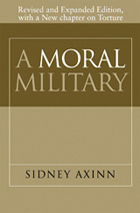 A Moral Military
Sidney Axinn
Temple University Press, 2008 In this new edition of the classic book on the moral conduct of war, Sidney Axinn provides a full-length treatment of the military conventions from a philosophical point of view. Axinn considers these basic ethical questions within the context of the laws of warfare: Should a good soldier ever disobey a direct military order? Are there restrictions on how we fight a war? What is meant by “military honor,” and does it really affect the contemporary soldier? Is human dignity possible under battlefield conditions? Axinn answers “yes” to these questions. His objective in A Moral Military is to establish a basic framework for moral military action and to assist in analyzing military professional ethics. He argues for the seriousness of the concept of military honor but limits honorable military activity by a strict interpretation of the notion of war crime. With revisions and expansions throughout, including a new chapter on torture, A Moral Military is an essential guide on the nature of war during a time when the limits of acceptable behavior are being stretched in new directions.
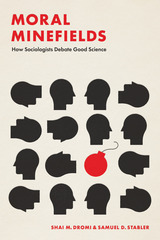 Moral Minefields: How Sociologists Debate Good Science
Shai M. Dromi and Samuel D. Stabler
University of Chicago Press, 2023 An analysis of the effects of moral debates on sociological research.
Few academic disciplines are as contentious as sociology. Sociologists routinely turn on their peers with fierce criticisms not only of their empirical rigor and theoretical clarity but of their character as well. Yet despite the controversy, scholars manage to engage in thorny debates without being censured. How?
In Moral Minefields, Shai M. Dromi and Samuel D. Stabler consider five recent controversial topics in sociology—race and genetics, secularization theory, methodological nationalism, the culture of poverty, and parenting practices—to reveal how moral debates affect the field. Sociologists, they show, tend to respond to moral criticism of scholarly work in one of three ways. While some accept and endorse the criticism, others work out new ways to address these topics that can transcend the criticism, while still others build on the debates to form new, more morally acceptable research.
Moral Minefields addresses one of the most prominent questions in contemporary sociological theory: how can sociology contribute to the development of a virtuous society? Rather than suggesting that sociologists adopt a clear paradigm that can guide their research toward neatly defined moral aims, Dromi and Stabler argue that sociologists already largely possess and employ the repertoires to address questions of moral virtue in their research. The conversation thus is moved away from attempts to theorize the moral goods sociologists should support and toward questions about how sociologists manage the plurality of moral positions that present themselves in their studies. Moral diversity within sociology, they show, fosters disciplinary progress.
Moral Nation
Bruce Nichols
University of Notre Dame Press, 1990
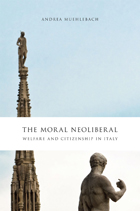 The Moral Neoliberal: Welfare and Citizenship in Italy
Andrea Muehlebach
University of Chicago Press, 2012 Morality is often imagined to be at odds with capitalism and its focus on the bottom line, but in The Moral Neoliberal morality is shown as the opposite: an indispensible tool for capitalist transformation. Set within the shifting landscape of neoliberal welfare reform in the Lombardy region of Italy, Andrea Muehlebach tracks the phenomenal rise of voluntarism in the wake of the state’s withdrawal of social service programs. Using anthropological tools, she shows how socialist volunteers are interpreting their unwaged labor as an expression of social solidarity, with Catholic volunteers thinking of theirs as an expression of charity and love. Such interpretations pave the way for a mass mobilization of an ethical citizenry that is put to work by the state. Visiting several sites across the region, from Milanese high schools to the offices of state social workers to the homes of the needy, Muehlebach mounts a powerful argument that the neoliberal state nurtures selflessness in order to cement some of its most controversial reforms. At the same time, she also shows how the insertion of such an anticapitalist narrative into the heart of neoliberalization can have unintended consequences.
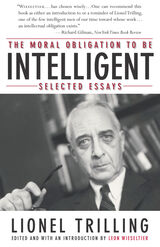 The Moral Obligation to Be Intelligent: Selected Essays
Lionel Trilling
Northwestern University Press, 2009 Bringing together the thoughts of one of American literature’s sharpest cultural critics, this compendium will open the eyes of a whole new audience to the work of Lionel Trilling. Trilling was a strenuous thinker who was proud to think “too much.” As an intellectual he did not spare his own kind, and though he did not consider himself a rationalist, he was grounded in the world.
This collection features 32 of Trilling’s essays on a range of topics, from Jane Austen to George Orwell and from the Kinsey Report to Lolita. Also included are Trilling’s seminal essays “Art and Neurosis” and “Manners, Morals, and the Novel.” Many of the pieces made their initial appearances in periodicals such as The Partisan Review and Commentary; most were later reprinted in essay collections. This new gathering of his writings demonstrates again Trilling’s patient, thorough style. Considering “the problems of life”—in art, literature, culture, and intellectual life—was, to him, a vital occupation, even if he did not expect to get anything as simple or encouraging as “answers.” The intellectual journey was the true goal.
No matter the subject, Trilling’s arguments come together easily, as if constructing complicated defenses and attacks were singularly simple for his well-honed mind. The more he wrote on a subject and the more intricate his reasoning, the more clear that subject became; his elaboration is all function and no filler. Wrestling with Trilling’s challenging work still yields rewards today, his ideas speaking to issues that transcend decades and even centuries.
Moral Philosophy and Development: The Human Condition in Africa
Tedros Kiros
Ohio University Press, 1992 Although development issues generally have been considered in a framework of economic theory and politics, in this volume Tedros Kiros looks to European ideas of moral philosophy to explain the underdevelopment of Africa and the persistent African food crisis. He draws upon the works of Adam Smith, David Ricardo, Karl Marx and the concepts of hegemony and counter-hegemony. Kiros points out that Africans and Europeans held opposing worldviews upon their initial contact and agrees with those who explain the present condition in Africa partly as the result of European colonialism. In his concluding chapter he develops principles of moral philosophy to guide Africans and others in the future economic development of the African continent.
The Moral Philosophy of Dietrich von Hildebrand
Martin Cajthaml
Catholic University of America Press, 2020 The Moral Philosophy of Dietrich von Hildebrand is the first full-fledged monograph on von Hildebrand’s moral philosophy available to date. Despite this pioneering effort, its aim is not to treat all the themes belonging to this area with equal depth and breadth. Rather, it focuses on the themes indicated by the aforementioned questions and relates them according to their inner systematic links rather than according to how and when they appear in von Hildebrand’s works. It also engages von Hildebrand in a critical dialogue, particularly with the ethics of Plato and Aristotle. This book will serve as a very good introduction not just to von Hildebrand´s moral philosophy but to his thought in general.
 Moral Philosophy Of Moore
Robert Peter Sylvester, edited by Ray Perkins, Jr. and R. W. Sleeper, foreword by Tom Regan
Temple University Press, 1990 This study of G. E. Moore’s work in moral philosophy draws upon a close examination of the early essays that preceded the writing of Principia Ethica in order to ground the author’s view that Moore’s famous "naturalistic fallacy argument" of Principia has been widely misunderstood. At the time of his death in 1986, Robert Peter Sylvester was in the process of preparing this book for publication. That process has been brought to completion by Ray Perkins, Jr., and R. W. Sleeper. Sylvester’s reappraisal of the moral philosophy of G. E. Moore argues that criticism of the work of this major twentieth-century British philosopher has been based on misinterpretation of his unified position. He treats Moore’s ideas about "What is Good?", "What things are Good?" and "What ought we to do?" as forming a coherent system. To bring this work up to date since the author’s death, the editors have provided a bibliographic essay following each chapter in which recent scholarship is discussed.
Moral Politics: How Liberals and Conservatives Think, Second Edition
George Lakoff
University of Chicago Press, 2002 In this classic text, the first full-scale application of cognitive science to politics, George Lakoff analyzes the unconscious and rhetorical worldviews of liberals and conservatives, discovering radically different but remarkably consistent conceptions of morality on both the left and right. For this new edition, Lakoff adds a preface and an afterword extending his observations to major ideological conflicts since the book's original publication, from the impeachment of Bill Clinton to the 2000 presidential election and its aftermath.
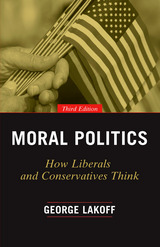 Moral Politics: How Liberals and Conservatives Think, Third Edition
George Lakoff
University of Chicago Press, 2016 When Moral Politics was first published two decades ago, it redefined how Americans think and talk about politics through the lens of cognitive political psychology. Today, George Lakoff’s classic text has become all the more relevant, as liberals and conservatives have come to hold even more vigorously opposed views of the world, with the underlying assumptions of their respective worldviews at the level of basic morality. Even more so than when Lakoff wrote, liberals and conservatives simply have very different, deeply held beliefs about what is right and wrong.
Lakoff reveals radically different but remarkably consistent conceptions of morality on both the left and right. Moral worldviews, like most deep ways of understanding the world, are unconscious—part of our “hard-wired” brain circuitry. When confronted with facts that don’t fit our moral worldview, our brains work automatically and unconsciously to ignore or reject these facts, and it takes extraordinary openness and awareness of this phenomenon to pay critical attention to the vast number of facts we are presented with each day. For this new edition, Lakoff has added a new preface and afterword, extending his observations to major ideological conflicts since the book's original publication, from the Affordable Care Act to the wars in Iraq and Afghanistan, the recent financial crisis, and the effects of global warming. One might have hoped such massive changes would bring people together, but the reverse has actually happened; the divide between liberals and conservatives has become stronger and more virulent.
To have any hope of bringing mutual respect to the current social and political divide, we need to clearly understand the problem and make it part of our contemporary public discourse. Moral Politics offers a much-needed wake-up call to both the left and the right.
Moral Politics in the Philippines: Inequality, Democracy and the Urban Poor
Wataru Kusaka
National University of Singapore Press, 2017 Moral Politics in the Philippines offers an in-depth examination of the political participation and discourse of the urban poor in Manila. After the ousting of Ferdinando Marcos in 1986, society in the Philippines fractured along socioeconomic lines. The educated middle class began to recognize themselves as moral citizens and political participants while condemning the poor as immoral “masses” who earn money illegally and support corrupt leaders. Conversely, the poor believe themselves to be morally upright and criticize the rich as arrogant oppressors. Wataru Kusaka looks at the dangers of this moralization of politics during the last several decades, and he analyzes the damaging effects it has had on democracy by excluding much of society and marginalizing the interests of those most in need of resources.
Moral Politics: What Conservatives Know That Liberals Don't
George Lakoff
University of Chicago Press, 1996 Moral Politics takes a fresh look at how we think and talk about political and moral ideas. George Lakoff analyzed recent political discussion to find that the family—especially the ideal family—is the most powerful metaphor in politics today. Revealing how family-based moral values determine views on diverse issues as crime, gun control, taxation, social programs, and the environment, George Lakoff looks at how conservatives and liberals link morality to politics through the concept of family and how these ideals diverge. Arguing that conservatives have exploited the connection between morality, the family, and politics, while liberals have failed to recognized it, Lakoff explains why conservative moral position has not been effectively challenged. A wake up call to political pundits on both the left and the right, this work redefines how Americans think and talk about politics.
Moral Prejudices: Essays on Ethics
Annette C. Baier
Harvard University Press, 1994 Annette Baier delivers an appeal for our fundamental moral notions to be governed not by rules and codes but by trust: a moral prejudice. Along the way, she gives us the best feminist philosophy there is. Baier’s topics range from violence to love, from cruelty to justice, and are linked by a preoccupation with vulnerability and inequality of vulnerability, with trust and distrust of equals, with cooperation and isolation. Throughout, she is concerned with the theme of women’s roles. In this provocative exploration of the implications of trusting to trust rather than proscription, Baier interweaves anecdote and autobiography with readings of Hume and Kant to produce an entertaining, challenging, and highly readable book.
Moral Principles
John Dewey. Preface by Sidney Hook
Southern Illinois University Press, 1975
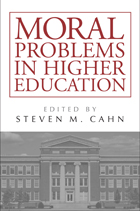 Moral Problems in Higher Education
Steven Cahn
Temple University Press, 2011 Moral Problems in Higher Education brings together key essays that explore ethical issues in academia. The editor and contributors-all noted philosophers and educators-consider such topics as academic freedom and tenure, free speech on campus, sexual harassment, preferential student admissions, affirmative action in faculty appointments, and the ideal of a politically neutral university. Chapters address possible restrictions on research because of moral concerns, the structure of peer review, telling the truth to colleagues and students, and concerns raised by intercollegiate athletics.
Cahn selects two key readings in each area to offer a readable introductory guide to these critical subjects for students studying academic ethics and higher education policy. In addition to the selections and a general introduction, Cahn provides study questions for use in the classroom.
Contributors include Scott F. Aikin, Derek Bok, William G. Bowen, Myles Brand, Richard T. DeGeorge, Paul D. Eisenberg, Leslie Pickering Francis, Martin P. Golding, Philip Kitcher, Charles R. Lawrence III, David Lewis, Paul J. Olscamp, Nancy Tuana, David Shatz, George Sher, Robert L. Simon, Robert B. Talisse, Stephan Thernstrom, Abigail Thernstrom, Laurence Thomas, Robert Paul Wolff, and the editor.
The Moral Property of Women: A History of Birth Control Politics in America
Linda Gordon
University of Illinois Press, 2002 Now in paperback, The Moral Property of Women is a thoroughly updated and revised version of the award-winning historian Linda Gordon’s classic study, Woman’s Body, Woman’s Right (1976). It is the only book to cover the entire history of the intense controversies about reproductive rights that have raged in the United States for more than 150 years. Arguing that reproduction control has always been central to women’s status, Gordon shows how opposition to it has long been part of the entrenched opposition to gender equality.
Moral Resistance and Spiritual Authority: Our Jewish Obligation to Social Justice
Rabbi Seth M. Limmer, DHL and Rabbi Jonah Dov Pesner
Central Conference of American Rabbis, 2019 This foundational new book reminds us of our ancient obligation to bring justice to the world. The essays in this collection explore the spiritual underpinnings of our Jewish commitment to justice, using Jewish text and tradition, as well as contemporary sources and models. Among the topics covered are women's health, LGBTQ rights, healthcare, racial justice, speaking truth to power, and community organizing.
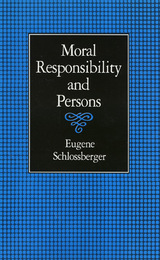 Moral Responsibility and Persons
Eugene Schlossberger
Temple University Press, 1992 Challenging traditional philosophical views of moral responsibility, Eugene Schlossberger argues that we are responsible not so much for what we do as for who we are. He explores what it means to be a person, concluding that personhood is the sum of beliefs and values—which are by no means entirely within our control. Consequently, the voluntariness of our acts—or even whether we act at all—is irrelevant to the moral evaluation of us as persons. Schlossberger contends that we are to be judged morally on the basis of what we are, our "world-view," rather than what we do. In Moral Responsibility and Persons Schlossberger disputes various received philosophical positions. His challenging and entertaining account also examines psychology and its view of the nature of personhood, as well as insanity and the "personality" of animals, children, and computers. He explores the validity of emotions we may feel in response to others—especially gratitude and resentment. And finally, Schlossberger tackles the inevitable implications of his position in the area of crime and punishment.
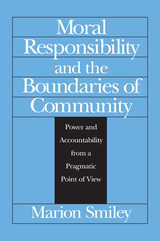 Moral Responsibility and the Boundaries of Community: Power and Accountability from a Pragmatic Point of View
Marion Smiley
University of Chicago Press, 1992 The question of responsibility plays a critical role not only in our attempts to resolve social and political problems, but in our very conceptions of what those problems are. Who, for example, is to blame for apartheid in South Africa? Is the South African government responsible? What about multinational corporations that do business there? Will uncovering the "true facts of the matter" lead us to the right answer?
In an argument both compelling and provocative, Marion Smiley demonstrates how attributions of blame—far from being based on an objective process of factual discovery—are instead judgments that we ourselves make on the basis of our own political and social points of view. She argues that our conception of responsibility is a singularly modern one that locates the source of blameworthiness in an individual's free will. After exploring the flaws inherent in this conception, she shows how our judgments of blame evolve out of our configuration of social roles, our conception of communal boundaries, and the distribution of power upon which both are based.
The great strength of Smiley's study lies in the way in which it brings together both rigorous philosophical analysis and an appreciation of the dynamics of social and political practice. By developing a pragmatic conception of moral responsibility, this work illustrates both how moral philosophy can enhance our understanding of social and political practices and why reflection on these practices is necessary to the reconstruction of our moral concepts.
Moral Sentiments in Modern Society: A New Answer to Classical Questions
Edited by Gabriël van den Brink
Amsterdam University Press, 2015 Since the time of Adam Smith, scholars have tried to understand the role moral sentiments play in modern life, an issue that became especially urgent during and after the 2008 global financial crisis. Previous explanations have ranged from the idea that modern society is built on moral values to the notion that modernization results in moral decay. The essays in this interdisciplinary volume use the example of Dutch society and a wealth of empirical data to propose a novel theory about the ambivalent relation between contemporary life and human nature. In the process, the contributors argue for the need to reject simplistic explanations and reinvent civil society.
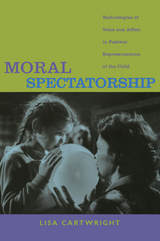 Moral Spectatorship: Technologies of Voice and Affect in Postwar Representations of the Child
Lisa Cartwright
Duke University Press, 2008 Why were theories of affect, intersubjectivity, and object relations bypassed in favor of a Lacanian linguistically oriented psychoanalysis in feminist film theory in the 1980s and 1990s? In Moral Spectatorship, Lisa Cartwright rethinks the politics of spectatorship in film studies. Returning to impasses reached in late-twentieth-century psychoanalytic film theory, she focuses attention on theories of affect and object relations seldom addressed during that period. Cartwright offers a new theory of spectatorship and the human subject that takes into account intersubjective and affective relationships and technologies facilitating human agency. Seeking to expand concepts of representation beyond the visual, she develops her theory through interpretations of two contexts in which adult caregivers help bring children to voice. She considers several social-problem melodramas about deaf and nonverbal girls and young women, including Johnny Belinda, The Miracle Worker, and Children of a Lesser God. Cartwright also analyzes the controversies surrounding facilitated communication, a technological practice in which caregivers help children with communication disorders achieve “voice” through writing facilitated by computers. This practice has inspired contempt among professionals and lay people who charge that the facilitator can manipulate the child’s speech. For more than two decades, film theory has been dominated by a model of identification tacitly based on the idea of feeling what the other feels or of imagining oneself to be the other. Building on the theories of affect and identification developed by André Green, Melanie Klein, Donald W. Winnicott, and Silvan Tomkins, Cartwright develops a model of spectatorship that takes into account and provides a way of critically analyzing the dynamics of a different kind of identification, one that is empathetic and highly intersubjective.
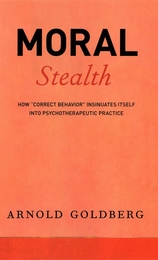 Moral Stealth: How "Correct Behavior" Insinuates Itself into Psychotherapeutic Practice
Arnold Goldberg
University of Chicago Press, 2007 A psychiatrist writes a letter to a journal explaining his decision to marry a former patient. Another psychiatrist confides that most of his friends are ex-patients. Both practitioners felt they had to defend their behavior, but psychoanalyst Arnold Goldberg couldn’t pinpoint the reason why. What was wrong about the analysts’ actions?
In Moral Stealth, Goldberg explores and explains that problem of “correct behavior.” He demonstrates that the inflated and official expectations that are part of an analyst’s training—that therapists be universally curious, hopeful, kind, and purposeful, for example—are often of less help than simple empathy amid the ambiguous morality of actual patient interactions. Being a good therapist and being a good person, he argues, are not necessarily the same.
Drawing on case studies from his own practice and from the experiences of others, as well as on philosophers such as John Dewey, Slavoj Žižek, and Jürgen Habermas, Goldberg breaks new ground and leads the way for therapists to understand the relationship between private morality and clinical practice.
Moral Theology In Age Of Renewal: A Study of the Catholic Tradition since Vatican II
Paulinus Ikechukwu Odozor, C.S.Sp.
University of Notre Dame Press, 2003 The context of moral theology: Theology, hierarchical magisterium and church. Catholic theology and academe -- Methodological questions: A methodological overview of fundamental moral theology. Three methodological issues in moral theology -- Personal ethics: A theological perspective on aging. In vitro fertilization and embryo transfer. The contraceptive revolution and the human condition -- Social ethics: The changing anthropological bases of Catholic social ethics. Religion, law, and public policy in America.
 The Moral Theology of Pope John Paul II
Charles E. Curran
Georgetown University Press, 2005 Pope John Paul II is the second longest serving pope in history and the longest serving pope of the last century. His presence has thrown a long shadow across our time, and his influence on Catholics and non-Catholics throughout the world cannot be denied. Much has been written about this pope, but until now, no one has provided a systematic and thorough analysis of the moral theology that underlies his moral teachings and its astonishing influence. And no one is better positioned to do this than Charles E. Curran, widely recognized as the leading American Catholic moral theologian. Curran focuses on the authoritative statements, specifically the fourteen papal encyclicals the pope has written over the past twenty-five years, to examine how well the pope has addressed the broad issues and problems in the Church today. Curran begins with a discussion of the theological presuppositions of John Paul II's moral teaching and moral theology. Subsequent chapters address his theological methodology, his ethical methodology, and his fundamental moral theology together with his understanding of human life. Finally, Curran deals with the specific issues of globalization, marriage, conscience, human acts, and the many issues involved in social and sexual ethics. While finding much to admire, Curran is nonetheless fiercely precise in his analysis and rigorously thoughtful in his criticism of much of the methodological aspects of the pope's moral theology—in his use of scripture, tradition, and previous hierarchical teaching; in theological aspects including Christology, eschatology, and the validity of human sources of moral wisdom and knowledge; and in anthropology, the ethical model and natural law. Brilliantly constructed and fearlessly argued, this will be the definitive measure of Pope John Paul II's moral theology for years to come.
 The Moral Tradition of American Constitutionalism: A Theological Interpretation
H. Jefferson Powell
Duke University Press, 1993 Debate over the relationship between morality and the law characterizes the contemporary discussion of American constitutionalism. Many theorists equate constitutionalism with the social morality of the American community; others deny the existence of such a community and identify constitutionalism simply as the positive law of the state. In this thoughtful and innovative book, H. Jefferson Powell presents a theological interpretation of the connection between constitutionalism and morality.
Powell locates the origins of constitutional law in the Enlightenment attempt to control the violence of the state by subjecting power to reason. He then traces constitutionalism's rapid evolution into a tradition of rational inquiry centered in the practice of adjudication and embodied in a community of lawyers and judges. Finally, Powell shows how the tradition's nineteenth-century presuppositions about the autonomy and rationality of constitutional argument have been undermined in the twentieth century, within the constitutional community itself, by the acceptance of a positivist and "democratic" understanding of law. Powell shows how the continued willingness of the courts to resolve moral questions by invoking "the Constitution" has thrown the constitutional tradition into an epistemological crisis. He critiques the work of many major theorists—John Hart Ely, Bruce Ackerman, Frank Michaelman, Rogers Smith, Michael Perry, Mark Tushnet, Robert Bork, Sanford Levinson—who, he claims, persist in attempting to resolve the crisis by redefining constitutionalism as American social morality.
With reference to Alasdair MacIntyre's concepts of moral tradition and social practice and John Howard Yoder's theological account of the state, Powell places his analysis of current constitutionalism within a contemporary Christian theological critique of Western liberalism. With certain exceptions, Powell concludes, there are theological grounds in the United States to prefer decision making by elected officials to decision by constitutional courts. Despite the controversial implications for judicial practice and legal argument, Powell ultimately argues that the liberal tradition of rational inquiry--American constitutionalism--be renounced by the Christian community in favor of the majoritarian political process.
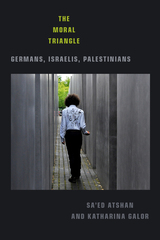 The Moral Triangle: Germans, Israelis, Palestinians
Sa'red Atshan and Katharina Galor
Duke University Press, 2020 Berlin is home to Europe’s largest Palestinian diaspora community and one of the world’s largest Israeli diaspora communities. Germany’s guilt about the Nazi Holocaust has led to a public disavowal of anti-Semitism and strong support for the Israeli state. Meanwhile, Palestinians in Berlin report experiencing increasing levels of racism and Islamophobia. In The Moral Triangle Sa’ed Atshan and Katharina Galor draw on ethnographic fieldwork and interviews with Israelis, Palestinians, and Germans in Berlin to explore these asymmetric relationships in the context of official German policies, public discourse, and the private sphere. They show how these relationships stem from narratives surrounding moral responsibility, the Holocaust, the Israel/Palestine conflict, and Germany’s recent welcoming of Middle Eastern refugees. They also point to spaces for activism and solidarity among Germans, Israelis, and Palestinians in Berlin that can help foster restorative justice and account for multiple forms of trauma. Highlighting their interlocutors’ experiences, memories, and hopes, Atshan and Galor demonstrate the myriad ways in which migration, trauma, and contemporary state politics are inextricably linked.
 The Moral Virtues and Theological Ethics, Second Edition
Romanus Cessario, O.P.
University of Notre Dame Press, 2008
First published in 1991, The Moral Virtues and Theological Ethicsintroduced readers to an approach in Christian ethics that was not then much in vogue. Although the Second Vatican Council had marked a departure from the legalistic code of proper conduct for Catholics (known since the Catholic Reformation as “casuistry”), few Catholic theologians had yet begun to explore an ethics based on moral virtues rather than one based on narrow, prescriptive rules.
At the forefront of studies that would begin to recover virtue ethics—the ethical teaching of the church in the patristic, monastic, and scholastic traditions—The Moral Virtues and Theological Ethicshas been widely used to introduce both students and scholars to the relatively “new” idea of virtue ethics, now a dominant principle in Catholic moral theology.
Following a brief new preface, the text of the six chapters in the original edition remains unchanged. However, Romanus Cessario, O.P., has substantially updated the citations in the notes to account for recent literature on the subject and has written a new chapter that accommodates his original study to the current ethos of moral theology. He draws on documents of the Catholic Church since 1991 to enrich the contemporary discussion of moral virtues and the dynamics of living a happy life. This second edition will inspire a new generation of readers, especially students and teachers of moral theology.
Moral Vision and Tradition
Antonio S. Cua
Catholic University of America Press, 2018 This volume offers a comprehensive philosophical study of Confucian ethics-its basic insights and its relevance to contemporary Western moral philosophy. Distinguished writer and philosopher A. S. Cua presents fourteen essays which deal with various probl
 A Moral Vision for America
Joseph Cardinal Bernardin. John P. Langan, Editor
Georgetown University Press, 1998 Joseph Cardinal Bernardin of Chicago was for twenty years the most influential U.S. Catholic bishop; he was also a beloved public figure whose views commanded respect from Catholics and non-Catholics alike. This posthumous collection of a number of his major addresses on central moral issues in contemporary American life voices the causes that were closest to his heart: the sanctity and protection of all human life, the reshaping of American society and institutions for the benefit of the poorest, the preservation of peace in the pursuit of justice, and the growth of mutual understanding and harmony within the Church. Spanning the period from the early 1980s to just weeks before his death in late 1996, these essays demonstrate a remarkably sustained and thoughtful effort to articulate an overall framework for moral decisions — "a consistent ethic of life" — and to affirm an active role for religious convictions in a pluralist democratic society. Cardinal Bernardin applies the Church’s moral and social teachings to complex policy issues in a way that respects religious freedom and invites both reflection from Catholics and dialogue with people of other beliefs. Written in a clear and accessible style, this volume will be of value to everyone interested in Cardinal Bernardin’s moral vision for political choices. It will also be important for a wide range of readers concerned with in Christian ethics and the role of religion in the public sphere. Joseph Cardinal Bernardin (1928-1996) served as the archbishop of Chicago from 1982 to 1996 and as archbishop of Cincinnati from 1972 to 1982. He was made a cardinal by Pope John Paul II in 1983 and received the Presidential Medal of Freedom in 1996 for his contribution to American civic life. He wrote The Gift of Peace (Loyola University Press, 1997).
 Moral Visions: Ethics and the Book of Mormon
Edited by Courtney S. Campbell and Kelly Sorensen
University of Illinois Press, 2025 Though used by millions as a guide for how to live one’s life, the Book of Mormon’s links with contemporary ethics remain largely unexamined. Courtney S. Campbell and Kelly Sorensen edit essays that spotlight and encourage further thought on these connections. Contributors in the first section discuss foundational issues such as the Book of Mormon’s moral psychology, its minimalist and covenantal moralities, the nature of the good and how the good is known, the question of whether value depends on a certain kind of future, the Book of Mormon's strategy for moral persuasion, and God’s participation in human choices. In the second section, the essayists turn to everyday ethical questions concerning resistance to forced cultural assimilation, clothing and dress, authority, and memory. The final chapter further explores practical moral visions. A rich and thought-provoking analysis, Moral Visions examines the Book of Mormon through a variety of methods while aiming to deepen understanding of both the text’s messages and its potential place in future discussions of ethics. Contributors: Daniel Becerra, Courtney S. Campbell, Ryan Davis, Michael D. K. Ing, Ariel Bybee Laughton, Kimberly Matheson, Rachel Esplin Odell, Kelly Sorensen, Joseph M. Spencer
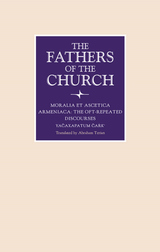 Moralia et Ascetica Armeniaca: The Oft-Repeated Discourses
Abraham Terian
Catholic University of America Press, 2022 The twenty-three discourses presented in this volume have a long textual history that ascribes them to St. Gregory the Illuminator of Armenia (d. 328), a prevalent view that lasted through the nineteenth century. Armenian scholarship through the last century has tended to ascribe them to St. Mashtots‘, the inventor of the Armenian alphabet (d. 440). In his critical introduction to this first-ever English translation of the discourses, Terian presents them as an ascetic text by an anonymous abbot writing near the end of the sixth century. The very title in Armenian, Yačaxapatum Čaŕk‘, literally, “Oft-Repeated Discourses,” further validates their ascetic environment, where they were repeatedly related to novices. For want of answers to introductory questions regarding authorship and date, and because of the pervasive grammatical difficulties of the text, the document has remained largely unknown in scholarship.
The discourses include many of the Eastern Fathers’ favorite theological themes. They are heavily punctuated with biblical quotations and laced with recurring biblical images and phraseology; the doctrinal and functional centrality of the Scriptures is emphasized throughout. They are replete with traditional Christian moral teachings that have acquired elements of moral philosophy transmitted through Late Antiquity. Echoes of St. Basil’s thought are heard in several of them, and some evidence of the author’s dependence on the Armenian version of the saint’s Rules, translated around the turn of the sixth century, is apparent. On the whole they show how Christians were driven by the Johannine love-command and the Pauline Spirit-guided practice of virtuous living, ever maturing in the ethos of an in-group solidarity culminating in monasticism.
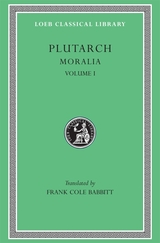 Moralia, Volume I: The Education of Children. How the Young Man Should Study Poetry. On Listening to Lectures. How to Tell a Flatterer from a Friend. How a Man May Become Aware of His Progress in Virtue
Plutarch
Harvard University Press Eclectic essays on ethics, education, and much else besides.
Plutarch (Plutarchus), ca. AD 45–120, was born at Chaeronea in Boeotia in central Greece, studied philosophy at Athens, and, after coming to Rome as a teacher in philosophy, was given consular rank by the emperor Trajan and a procuratorship in Greece by Hadrian. He was married and the father of one daughter and four sons. He appears as a man of kindly character and independent thought, studious and learned.
Plutarch wrote on many subjects. Most popular have always been the forty-six Parallel Lives, biographies planned to be ethical examples in pairs (in each pair, one Greek figure and one similar Roman), though the last four lives are single. All are invaluable sources of our knowledge of the lives and characters of Greek and Roman statesmen, soldiers and orators. Plutarch’s many other varied extant works, about sixty in number, are known as Moralia or Moral Essays. They are of high literary value, besides being of great use to people interested in philosophy, ethics, and religion.
The Loeb Classical Library edition of the Moralia is in fifteen volumes, volume XIII having two parts. Volume XVI is a comprehensive Index.
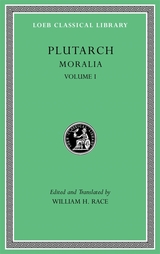 Moralia, Volume I: The Education of Children. How the Young Man Should Study Poetry. On Listening to Lectures. How to Tell a Flatterer from a Friend. How a Man May Become Aware of His Progress in Virtue
Plutarch
Harvard University Press Eclectic essays on ethics, education, and much else besides.
Plutarch (Plutarchus), ca. AD 45–120, was born at Chaeronea in Boeotia, in central Greece. He is renowned for his forty-six Parallel Lives, biographies planned to be ethical examples in pairs (in each pair, one Greek figure and one comparable Roman), though the last four lives are single. But he was also a teacher of philosophy in Rome, a priest at Delphi, and an engaging essayist with an urbane and judicious style whose many other extant works, some seventy in number and known collectively as Moralia or Moral Essays, are important sources for classical philosophy, ethics, and religion. Whether advising about marriage and education, discussing prophecy, divine providence, and life after death, setting forth rules for politicians, or commenting on personal virtues and vices, the Moralia reveal not only Plutarch’s own thinking but also the world in which he lived.
The Loeb Classical Library edition of the Moralia is in sixteen volumes, volume XIII having two parts. Volume XVI comprises an analytical index that provides access to the great riches to be found within the collection. In the present volume are five essays: The Education of Children, How the Young Man Should Study Poetry, On Listening to Lectures, How to Tell a Flatterer from a Friend, and How a Man May Become Aware of His Progress in Virtue.
This edition, which replaces the original by Frank Cole Babbitt (1927), offers text, translation, and annotation that are fully current with modern scholarship.
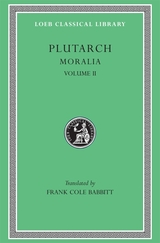 Moralia, Volume II: How to Profit by One’s Enemies. On Having Many Friends. Chance. Virtue and Vice. Letter of Condolence to Apollonius. Advice About Keeping Well. Advice to Bride and Groom. The Dinner of the Seven Wise Men. Superstition
Plutarch
Harvard University Press Eclectic essays on ethics, education, and much else besides.
Plutarch (Plutarchus), ca. AD 45–120, was born at Chaeronea in Boeotia in central Greece, studied philosophy at Athens, and, after coming to Rome as a teacher in philosophy, was given consular rank by the emperor Trajan and a procuratorship in Greece by Hadrian. He was married and the father of one daughter and four sons. He appears as a man of kindly character and independent thought, studious and learned.
Plutarch wrote on many subjects. Most popular have always been the forty-six Parallel Lives, biographies planned to be ethical examples in pairs (in each pair, one Greek figure and one similar Roman), though the last four lives are single. All are invaluable sources of our knowledge of the lives and characters of Greek and Roman statesmen, soldiers and orators. Plutarch’s many other varied extant works, about sixty in number, are known as Moralia or Moral Essays. They are of high literary value, besides being of great use to people interested in philosophy, ethics, and religion.
The Loeb Classical Library edition of the Moralia is in fifteen volumes, volume XIII having two parts. Volume XVI is a comprehensive Index.
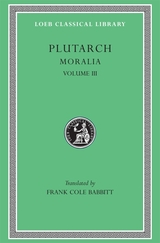 Moralia, Volume III: Sayings of Kings and Commanders. Sayings of Romans. Sayings of Spartans. The Ancient Customs of the Spartans. Sayings of Spartan Women. Bravery of Women
Plutarch
Harvard University Press Eclectic essays on ethics, education, and much else besides.
Plutarch (Plutarchus), ca. AD 45–120, was born at Chaeronea in Boeotia in central Greece, studied philosophy at Athens, and, after coming to Rome as a teacher in philosophy, was given consular rank by the emperor Trajan and a procuratorship in Greece by Hadrian. He was married and the father of one daughter and four sons. He appears as a man of kindly character and independent thought, studious and learned.
Plutarch wrote on many subjects. Most popular have always been the forty-six Parallel Lives, biographies planned to be ethical examples in pairs (in each pair, one Greek figure and one similar Roman), though the last four lives are single. All are invaluable sources of our knowledge of the lives and characters of Greek and Roman statesmen, soldiers and orators. Plutarch’s many other varied extant works, about sixty in number, are known as Moralia or Moral Essays. They are of high literary value, besides being of great use to people interested in philosophy, ethics, and religion.
The Loeb Classical Library edition of the Moralia is in fifteen volumes, volume XIII having two parts. Volume XVI is a comprehensive Index.
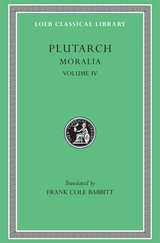 Moralia, Volume IV: Roman Questions. Greek Questions. Greek and Roman Parallel Stories. On the Fortune of the Romans. On the Fortune or the Virtue of Alexander. Were the Athenians More Famous in War or in Wisdom?
Plutarch
Harvard University Press Eclectic essays on ethics, education, and much else besides.
Plutarch (Plutarchus), ca. AD 45–120, was born at Chaeronea in Boeotia in central Greece, studied philosophy at Athens, and, after coming to Rome as a teacher in philosophy, was given consular rank by the emperor Trajan and a procuratorship in Greece by Hadrian. He was married and the father of one daughter and four sons. He appears as a man of kindly character and independent thought, studious and learned.
Plutarch wrote on many subjects. Most popular have always been the forty-six Parallel Lives, biographies planned to be ethical examples in pairs (in each pair, one Greek figure and one similar Roman), though the last four lives are single. All are invaluable sources of our knowledge of the lives and characters of Greek and Roman statesmen, soldiers and orators. Plutarch’s many other varied extant works, about sixty in number, are known as Moralia or Moral Essays. They are of high literary value, besides being of great use to people interested in philosophy, ethics, and religion.
The Loeb Classical Library edition of the Moralia is in fifteen volumes, volume XIII having two parts. Volume XVI is a comprehensive Index.
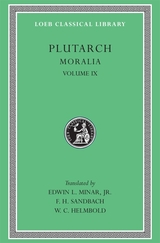 Moralia, Volume IX: Table-talk, Books 7–9. Dialogue on Love
Plutarch
Harvard University Press Eclectic essays on ethics, education, and much else besides.
Plutarch (Plutarchus), ca. AD 45–120, was born at Chaeronea in Boeotia in central Greece, studied philosophy at Athens, and, after coming to Rome as a teacher in philosophy, was given consular rank by the emperor Trajan and a procuratorship in Greece by Hadrian. He was married and the father of one daughter and four sons. He appears as a man of kindly character and independent thought, studious and learned.
Plutarch wrote on many subjects. Most popular have always been the forty-six Parallel Lives, biographies planned to be ethical examples in pairs (in each pair, one Greek figure and one similar Roman), though the last four lives are single. All are invaluable sources of our knowledge of the lives and characters of Greek and Roman statesmen, soldiers and orators. Plutarch’s many other varied extant works, about sixty in number, are known as Moralia or Moral Essays. They are of high literary value, besides being of great use to people interested in philosophy, ethics, and religion.
The Loeb Classical Library edition of the Moralia is in fifteen volumes, volume XIII having two parts. Volume XVI is a comprehensive Index.
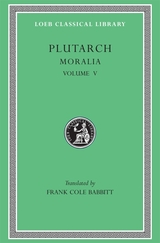 Moralia, Volume V: Isis and Osiris. The E at Delphi. The Oracles at Delphi No Longer Given in Verse. The Obsolescence of Oracles
Plutarch
Harvard University Press Eclectic essays on ethics, education, and much else besides.
Plutarch (Plutarchus), ca. AD 45–120, was born at Chaeronea in Boeotia in central Greece, studied philosophy at Athens, and, after coming to Rome as a teacher in philosophy, was given consular rank by the emperor Trajan and a procuratorship in Greece by Hadrian. He was married and the father of one daughter and four sons. He appears as a man of kindly character and independent thought, studious and learned.
Plutarch wrote on many subjects. Most popular have always been the forty-six Parallel Lives, biographies planned to be ethical examples in pairs (in each pair, one Greek figure and one similar Roman), though the last four lives are single. All are invaluable sources of our knowledge of the lives and characters of Greek and Roman statesmen, soldiers and orators. Plutarch’s many other varied extant works, about sixty in number, are known as Moralia or Moral Essays. They are of high literary value, besides being of great use to people interested in philosophy, ethics, and religion.
The Loeb Classical Library edition of the Moralia is in fifteen volumes, volume XIII having two parts. Volume XVI is a comprehensive Index.
 Moralia, Volume VI: Can Virtue Be Taught? On Moral Virtue. On the Control of Anger. On Tranquility of Mind. On Brotherly Love. On Affection for Offspring. Whether Vice Be Sufficient to Cause Unhappiness. Whether the Affections of the Soul are Worse Than Those of the Body
Plutarch
Harvard University Press Eclectic essays on ethics, education, and much else besides.
Plutarch (Plutarchus), ca. AD 45–120, was born at Chaeronea in Boeotia in central Greece, studied philosophy at Athens, and, after coming to Rome as a teacher in philosophy, was given consular rank by the emperor Trajan and a procuratorship in Greece by Hadrian. He was married and the father of one daughter and four sons. He appears as a man of kindly character and independent thought, studious and learned.
Plutarch wrote on many subjects. Most popular have always been the forty-six Parallel Lives, biographies planned to be ethical examples in pairs (in each pair, one Greek figure and one similar Roman), though the last four lives are single. All are invaluable sources of our knowledge of the lives and characters of Greek and Roman statesmen, soldiers and orators. Plutarch’s many other varied extant works, about sixty in number, are known as Moralia or Moral Essays. They are of high literary value, besides being of great use to people interested in philosophy, ethics, and religion.
The Loeb Classical Library edition of the Moralia is in fifteen volumes, volume XIII having two parts. Volume XVI is a comprehensive Index.
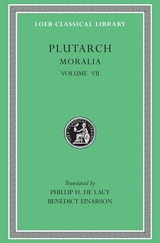 Moralia, Volume VII: On Love of Wealth. On Compliancy. On Envy and Hate. On Praising Oneself Inoffensively. On the Delays of the Divine Vengeance. On Fate. On the Sign of Socrates. On Exile. Consolation to His Wife
Plutarch
Harvard University Press Eclectic essays on ethics, education, and much else besides.
Plutarch (Plutarchus), ca. AD 45–120, was born at Chaeronea in Boeotia in central Greece, studied philosophy at Athens, and, after coming to Rome as a teacher in philosophy, was given consular rank by the emperor Trajan and a procuratorship in Greece by Hadrian. He was married and the father of one daughter and four sons. He appears as a man of kindly character and independent thought, studious and learned.
Plutarch wrote on many subjects. Most popular have always been the forty-six Parallel Lives, biographies planned to be ethical examples in pairs (in each pair, one Greek figure and one similar Roman), though the last four lives are single. All are invaluable sources of our knowledge of the lives and characters of Greek and Roman statesmen, soldiers and orators. Plutarch’s many other varied extant works, about sixty in number, are known as Moralia or Moral Essays. They are of high literary value, besides being of great use to people interested in philosophy, ethics, and religion.
The Loeb Classical Library edition of the Moralia is in fifteen volumes, volume XIII having two parts. Volume XVI is a comprehensive Index.
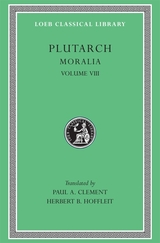 Moralia, Volume VIII: Table-talk, Books 1–6
Plutarch
Harvard University Press Eclectic essays on ethics, education, and much else besides.
Plutarch (Plutarchus), ca. AD 45–120, was born at Chaeronea in Boeotia in central Greece, studied philosophy at Athens, and, after coming to Rome as a teacher in philosophy, was given consular rank by the emperor Trajan and a procuratorship in Greece by Hadrian. He was married and the father of one daughter and four sons. He appears as a man of kindly character and independent thought, studious and learned.
Plutarch wrote on many subjects. Most popular have always been the forty-six Parallel Lives, biographies planned to be ethical examples in pairs (in each pair, one Greek figure and one similar Roman), though the last four lives are single. All are invaluable sources of our knowledge of the lives and characters of Greek and Roman statesmen, soldiers and orators. Plutarch’s many other varied extant works, about sixty in number, are known as Moralia or Moral Essays. They are of high literary value, besides being of great use to people interested in philosophy, ethics, and religion.
The Loeb Classical Library edition of the Moralia is in fifteen volumes, volume XIII having two parts. Volume XVI is a comprehensive Index.
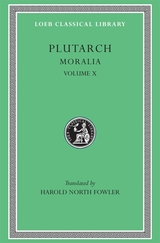 Moralia, Volume X: Love Stories. That a Philosopher Ought to Converse Especially With Men in Power. To an Uneducated Ruler. Whether an Old Man Should Engage in Public Affairs. Precepts of Statecraft. On Monarchy, Democracy, and Oligarchy. That We Ought Not to Borrow
Plutarch
Harvard University Press Eclectic essays on ethics, education, and much else besides.
Plutarch (Plutarchus), ca. AD 45–120, was born at Chaeronea in Boeotia in central Greece, studied philosophy at Athens, and, after coming to Rome as a teacher in philosophy, was given consular rank by the emperor Trajan and a procuratorship in Greece by Hadrian. He was married and the father of one daughter and four sons. He appears as a man of kindly character and independent thought, studious and learned.
Plutarch wrote on many subjects. Most popular have always been the forty-six Parallel Lives, biographies planned to be ethical examples in pairs (in each pair, one Greek figure and one similar Roman), though the last four lives are single. All are invaluable sources of our knowledge of the lives and characters of Greek and Roman statesmen, soldiers and orators. Plutarch’s many other varied extant works, about sixty in number, are known as Moralia or Moral Essays. They are of high literary value, besides being of great use to people interested in philosophy, ethics, and religion.
The Loeb Classical Library edition of the Moralia is in fifteen volumes, volume XIII having two parts. Volume XVI is a comprehensive Index.
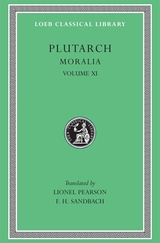 Moralia, Volume XI: On the Malice of Herodotus. Causes of Natural Phenomena
Plutarch
Harvard University Press Eclectic essays on ethics, education, and much else besides.
Plutarch (Plutarchus), ca. AD 45–120, was born at Chaeronea in Boeotia in central Greece, studied philosophy at Athens, and, after coming to Rome as a teacher in philosophy, was given consular rank by the emperor Trajan and a procuratorship in Greece by Hadrian. He was married and the father of one daughter and four sons. He appears as a man of kindly character and independent thought, studious and learned.
Plutarch wrote on many subjects. Most popular have always been the forty-six Parallel Lives, biographies planned to be ethical examples in pairs (in each pair, one Greek figure and one similar Roman), though the last four lives are single. All are invaluable sources of our knowledge of the lives and characters of Greek and Roman statesmen, soldiers and orators. Plutarch’s many other varied extant works, about sixty in number, are known as Moralia or Moral Essays. They are of high literary value, besides being of great use to people interested in philosophy, ethics, and religion.
The Loeb Classical Library edition of the Moralia is in fifteen volumes, volume XIII having two parts. Volume XVI is a comprehensive Index.
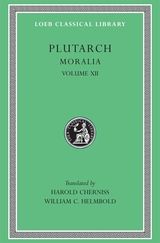 Moralia, Volume XII: Concerning the Face Which Appears in the Orb of the Moon. On the Principle of Cold. Whether Fire or Water Is More Useful. Whether Land or Sea Animals Are Cleverer. Beasts Are Rational. On the Eating of Flesh
Plutarch
Harvard University Press Eclectic essays on ethics, education, and much else besides.
Plutarch (Plutarchus), ca. AD 45–120, was born at Chaeronea in Boeotia in central Greece, studied philosophy at Athens, and, after coming to Rome as a teacher in philosophy, was given consular rank by the emperor Trajan and a procuratorship in Greece by Hadrian. He was married and the father of one daughter and four sons. He appears as a man of kindly character and independent thought, studious and learned.
Plutarch wrote on many subjects. Most popular have always been the forty-six Parallel Lives, biographies planned to be ethical examples in pairs (in each pair, one Greek figure and one similar Roman), though the last four lives are single. All are invaluable sources of our knowledge of the lives and characters of Greek and Roman statesmen, soldiers and orators. Plutarch’s many other varied extant works, about sixty in number, are known as Moralia or Moral Essays. They are of high literary value, besides being of great use to people interested in philosophy, ethics, and religion.
The Loeb Classical Library edition of the Moralia is in fifteen volumes, volume XIII having two parts. Volume XVI is a comprehensive Index.
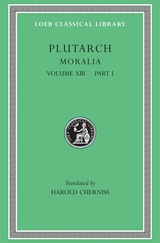 Moralia, Volume XIII: Part I: Platonic Essays
Plutarch
Harvard University Press Eclectic essays on ethics, education, and much else besides.
Plutarch (Plutarchus), ca. AD 45–120, was born at Chaeronea in Boeotia in central Greece, studied philosophy at Athens, and, after coming to Rome as a teacher in philosophy, was given consular rank by the emperor Trajan and a procuratorship in Greece by Hadrian. He was married and the father of one daughter and four sons. He appears as a man of kindly character and independent thought, studious and learned.
Plutarch wrote on many subjects. Most popular have always been the forty-six Parallel Lives, biographies planned to be ethical examples in pairs (in each pair, one Greek figure and one similar Roman), though the last four lives are single. All are invaluable sources of our knowledge of the lives and characters of Greek and Roman statesmen, soldiers and orators. Plutarch’s many other varied extant works, about sixty in number, are known as Moralia or Moral Essays. They are of high literary value, besides being of great use to people interested in philosophy, ethics, and religion.
The Loeb Classical Library edition of the Moralia is in fifteen volumes, volume XIII having two parts. Volume XVI is a comprehensive Index.
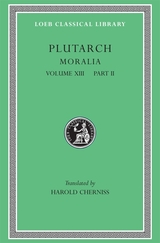 Moralia, Volume XIII: Part II: Stoic Essays
Plutarch
Harvard University Press Eclectic essays on ethics, education, and much else besides.
Plutarch (Plutarchus), ca. AD 45–120, was born at Chaeronea in Boeotia in central Greece, studied philosophy at Athens, and, after coming to Rome as a teacher in philosophy, was given consular rank by the emperor Trajan and a procuratorship in Greece by Hadrian. He was married and the father of one daughter and four sons. He appears as a man of kindly character and independent thought, studious and learned.
Plutarch wrote on many subjects. Most popular have always been the forty-six Parallel Lives, biographies planned to be ethical examples in pairs (in each pair, one Greek figure and one similar Roman), though the last four lives are single. All are invaluable sources of our knowledge of the lives and characters of Greek and Roman statesmen, soldiers and orators. Plutarch’s many other varied extant works, about sixty in number, are known as Moralia or Moral Essays. They are of high literary value, besides being of great use to people interested in philosophy, ethics, and religion.
The Loeb Classical Library edition of the Moralia is in fifteen volumes, volume XIII having two parts. Volume XVI is a comprehensive Index.
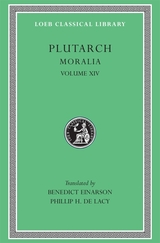 Moralia, Volume XIV: That Epicurus Actually Makes a Pleasant Life Impossible. Reply to Colotes in Defence of the Other Philosophers. Is “Live Unknown” a Wise Precept? On Music
Plutarch
Harvard University Press Eclectic essays on ethics, education, and much else besides.
Plutarch (Plutarchus), ca. AD 45–120, was born at Chaeronea in Boeotia in central Greece, studied philosophy at Athens, and, after coming to Rome as a teacher in philosophy, was given consular rank by the emperor Trajan and a procuratorship in Greece by Hadrian. He was married and the father of one daughter and four sons. He appears as a man of kindly character and independent thought, studious and learned.
Plutarch wrote on many subjects. Most popular have always been the forty-six Parallel Lives, biographies planned to be ethical examples in pairs (in each pair, one Greek figure and one similar Roman), though the last four lives are single. All are invaluable sources of our knowledge of the lives and characters of Greek and Roman statesmen, soldiers and orators. Plutarch’s many other varied extant works, about sixty in number, are known as Moralia or Moral Essays. They are of high literary value, besides being of great use to people interested in philosophy, ethics, and religion.
The Loeb Classical Library edition of the Moralia is in fifteen volumes, volume XIII having two parts. Volume XVI is a comprehensive Index.
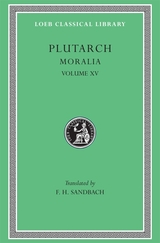 Moralia, Volume XV: Fragments
Plutarch
Harvard University Press Eclectic essays on ethics, education, and much else besides.
Plutarch (Plutarchus), ca. AD 45–120, was born at Chaeronea in Boeotia in central Greece, studied philosophy at Athens, and, after coming to Rome as a teacher in philosophy, was given consular rank by the emperor Trajan and a procuratorship in Greece by Hadrian. He was married and the father of one daughter and four sons. He appears as a man of kindly character and independent thought, studious and learned.
Plutarch wrote on many subjects. Most popular have always been the forty-six Parallel Lives, biographies planned to be ethical examples in pairs (in each pair, one Greek figure and one similar Roman), though the last four lives are single. All are invaluable sources of our knowledge of the lives and characters of Greek and Roman statesmen, soldiers and orators. Plutarch’s many other varied extant works, about sixty in number, are known as Moralia or Moral Essays. They are of high literary value, besides being of great use to people interested in philosophy, ethics, and religion.
The Loeb Classical Library edition of the Moralia is in fifteen volumes, volume XIII having two parts. Volume XVI is a comprehensive Index.
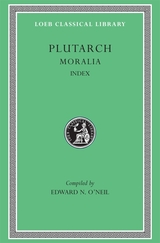 Moralia, Volume XVI: Index
Plutarch
Harvard University Press, 2004 Eclectic essays on ethics, education, and much else besides.
Plutarch (Plutarchus), ca. AD 45–120, was born at Chaeronea in Boeotia in central Greece, studied philosophy at Athens, and, after coming to Rome as a teacher in philosophy, was given consular rank by the emperor Trajan and a procuratorship in Greece by Hadrian. He was married and the father of one daughter and four sons. He appears as a man of kindly character and independent thought, studious and learned.
Plutarch wrote on many subjects. Most popular have always been the forty-six Parallel Lives, biographies planned to be ethical examples in pairs (in each pair, one Greek figure and one similar Roman), though the last four lives are single. All are invaluable sources of our knowledge of the lives and characters of Greek and Roman statesmen, soldiers and orators. Plutarch’s many other varied extant works, about sixty in number, are known as Moralia or Moral Essays. They are of high literary value, besides being of great use to people interested in philosophy, ethics, and religion.
The Loeb Classical Library edition of the Moralia is in fifteen volumes, volume XIII having two parts. Volume XVI is a comprehensive Index.
Morality & Imagination
Yi-Fu Tuan
University of Wisconsin Press, 1989 Can the individual and society be both moral and imaginative? In Western society the moral person tends to be regarded as either simple and naive or narrow and bigoted. In contrast, the imaginative person is looked on as someone not bound by the customs of the group and therefore likely to be fanciful and out of touch with reality.
 Morality and Architecture Revisited
David Watkin
University of Chicago Press, 2001 When Morality and Architecture was first published in 1977, it received passionate praise and equally passionate criticism. An editorial in Apollo, entitled "The Time Bomb," claimed that "it deserved to become a set book in art school and University art history departments," and the Times Literary Supplement savaged it as an example of "that kind of vindictiveness of which only Christians seem capable."
Here, for the first time, is the story of the book's impact. In writing his groundbreaking polemic, David Watkin had taken on the entire modernist establishment, tracing it back to Pugin, Viollet-le-Duc, Corbusier, and others who claimed that their chosen style had to be truthful and rational, reflecting society's needs. Any critic of this style was considered antisocial and immoral. Only covertly did the giants of the architectural establishment support the author. Watkin gives an overview of what has happened since the book's publication, arguing that many of the old fallacies still persist. This return to the attack is a revelation for anyone concerned architecture's past and future.
Morality and Architecture Revisited contains the entire text of the book Morality and Architecture , plus additonal material by David Wakin on the controversy that the the book created.
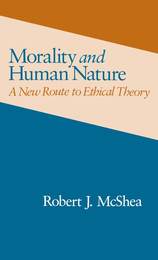 Morality and Human Nature: A New Route to Ethical Theory
Robert J. McShea
Temple University Press, 1990 Plato asked, "How shall a man live?" In this volume, Robert J. McShea offers an important, serious, and controversial answer to that perennial question. In this inquiry into the origins of human values, the author argues that values are based on emotions rather than on reason. The human ability to recall the past, to imagine future consequences of actions, and to be aware simultaneously of present, past, and probable future feelings form the basis of moral judgments. What is truly valuable to humans is a consequence of their species nature; thus, moral theory is the study of that nature. This is what McShea calls the human nature tradition, from "know thyself": to "the noblest study of man is man." Using ethology (studies of animal behavior), the author seeks to remind the reader of the significance of species being to the understanding of all creatures, and thus of ourselves. In viewing moral values as arising from human nature, McShea challenges a number of influential theories-notably, the belief that values are products of culture. Written out of a growing sense that our society finds itself in a moral and social limbo, Morality and Human Nature aurges that we start afresh and calls us to a continual reassessment of mores and social practices in the light of their adaptability to human feeling.
 Morality and the Human Goods: An Introduction to Natural Law Ethics
Alfonso Gómez-Lobo
Georgetown University Press, 2002 A concise and accessible introduction to natural law ethics, this book introduces readers to the mainstream tradition of Western moral philosophy. Building on philosophers from Plato through Aquinas to John Finnis, Alfonso Gómez-Lobo links morality to the protection of basic human goods — life, family, friendship, work and play, the experience of beauty, knowledge, and integrity — elements essential to a flourishing, happy human life. Gómez-Lobo begins with a discussion of Plato's Crito as an introduction to the practice of moral philosophy, showing that it requires that its participants treat each other as equals and offer rational arguments to persuade each other. He then puts forth a general principle for practical rationality: one should pursue what is good and avoid what is bad. The human goods form the basis for moral norms that provide a standard by which actions can be evaluated: do they support or harm the human goods? He argues that moral norms should be understood as a system of rules whose rationale is the protection and enhancement of human goods. A moral norm that does not enjoin the preservation or enhancement of a specific good is unjustifiable. Shifting to a case study approach, Gómez-Lobo applies these principles to a discussion of abortion and euthanasia. The book ends with a brief treatment of rival positions, including utilitarianism and libertarianism, and of conscience as our ultimate moral guide. Written as an introductory text for students of ethics and natural law, Morality and the Human Goods makes arguments consistent with Catholic teaching but is not based on theological considerations. The work falls squarely within the field of philosophical ethics and will be of interest to readers of any background.
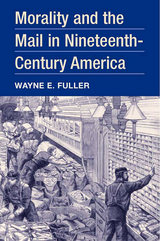 Morality and the Mail in Nineteenth-Century America
Wayne E. Fuller
University of Illinois Press, 2003 Morality and the Mail in Nineteenth-Century America explores the evolution of postal innovations that sparked a communication revolution in nineteenth-century America. Wayne E. Fuller examines how evangelical Protestants, the nation’s dominant religious group, struggled against those transformations in American society that they believed threatened to paganize the Christian nation they were determined to save.
Drawing on House and Senate documents, postmasters general reports, and the Congressional Record, as well as sermons, speeches, and articles from numerous religious and secular periodicals, Fuller illuminates the problems the changed postal system posed for evangelicals, from Sunday mail delivery and Sunday newspapers to an avalanche of unseemly material brought into American homes via improved mail service and reduced postage prices. Along the way, Fuller offers new perspectives on the church and state controversy in the United States as well as on publishing, politics, birth control, the lottery, censorship, Congress’s postal power, and the waning of evangelical Protestant influence.
 Morality by Design: Technology's Challenge to Human Values
Wade Rowland
Intellect Books, 2019 The eleven short, linked essays in Morality by Design represent a culmination of two decades of research and writing on the topic of moral realism. Wade Rowland first introduces readers to the basic ideas of leading moral thinkers from Plato to Leibniz to Putnam, and then, he explores the subject through today’s political, economic, and environmental conundrums. The collection presents a strong argument against postmodern moral relativism and the idea that only science can claim a body of reliable fact; challenges currently fashionable notions of the perfectibility of human individuals—and even the human species—through technology; and argues for the validity of common sense.
In guiding the reader through Enlightenment-era rationalist thought as it pertained to human nature and the foundations of morality, Rowland provides a coherent, intellectually sound, and intuitively appealing alternative to the nihilistic views popularized by contemporary radical relativism. Morality by Design ultimately seeks to convince readers that there is such a thing as moral fact, and that they do indeed have what it takes to make robust and durable moral judgments.
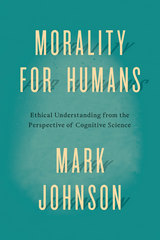 Morality for Humans: Ethical Understanding from the Perspective of Cognitive Science
Mark Johnson
University of Chicago Press, 2014 What is the difference between right and wrong? This is no easy question to answer, yet we constantly try to make it so, frequently appealing to some hidden cache of cut-and-dried absolutes, whether drawn from God, universal reason, or societal authority. Combining cognitive science with a pragmatist philosophical framework in Morality for Humans: Ethical Understanding from the Perspective of Cognitive Science, Mark Johnson argues that appealing solely to absolute principles and values is not only scientifically unsound but even morally suspect. He shows that the standards for the kinds of people we should be and how we should treat one another—which we often think of as universal—are in fact frequently subject to change. And we should be okay with that. Taking context into consideration, he offers a remarkably nuanced, naturalistic view of ethics that sees us creatively adapt our standards according to given needs, emerging problems, and social interactions.
Ethical naturalism is not just a revamped form of relativism. Indeed, Johnson attempts to overcome the absolutist-versus-relativist impasse that has been one of the most intractable problems in the history of philosophy. He does so through a careful and inclusive look at the many ways we reason about right and wrong. Much of our moral thought, he shows, is automatic and intuitive, gut feelings that we follow up and attempt to justify with rational analysis and argument. However, good moral deliberation is not limited merely to intuitive judgments supported after the fact by reasoning. Johnson points out a crucial third element: we imagine how our decisions will play out, how we or the world would change with each action we might take. Plumbing this imaginative dimension of moral reasoning, he provides a psychologically sophisticated view of moral problem solving, one perfectly suited for the embodied, culturally embedded, and ever-developing human creatures that we are.
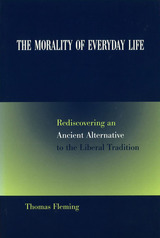 The Morality of Everyday Life: Rediscovering an Ancient Alternative to the Liberal Tradition
Thomas Fleming
University of Missouri Press, 2007
In TheMorality of Everyday Life, Thomas Fleming offers an alternative to the enlightened liberalism espoused by thinkers as different as Kant, Mill, Rand, and Rawls. Philosophers in the liberal tradition, although they disagree on many important questions, agree that moral and political problems should be looked at from an objective point of view and a decision made from a rational perspective that is universally applied to all comparable cases.
Fleming instead places importance on the particular, the local, and moral complexity. He advocates a return to premodern traditions, such as those exemplified in the texts of Aristotle, the Talmud, and the folk wisdom in ancient Greek literature, for a solution to ethical predicaments. In his view, liberalism and postmodernism ignore the fact that human beings by their very nature refuse to live in a world of universal abstractions.
While such modern philosophers as Kant and Kohlberg have regarded a mother’s self-sacrificing love for her children as beneath their level of morality, folk wisdom tells us it is nearly the highest morality, taking precedence over the duties of citizenship or the claims of humanity. Fleming believes that a modern type of “casuistry” should be applied to these moral conflicts in which the line between right and wrong is rarely clear.
This volume will appeal to students of ethics and classics, as well as the general educated reader, who will appreciate Fleming’s jargon-free prose. Teachers will find this text useful because each chapter is a self-contained essay that could be used as the basis for classroom discussion.
|
|
